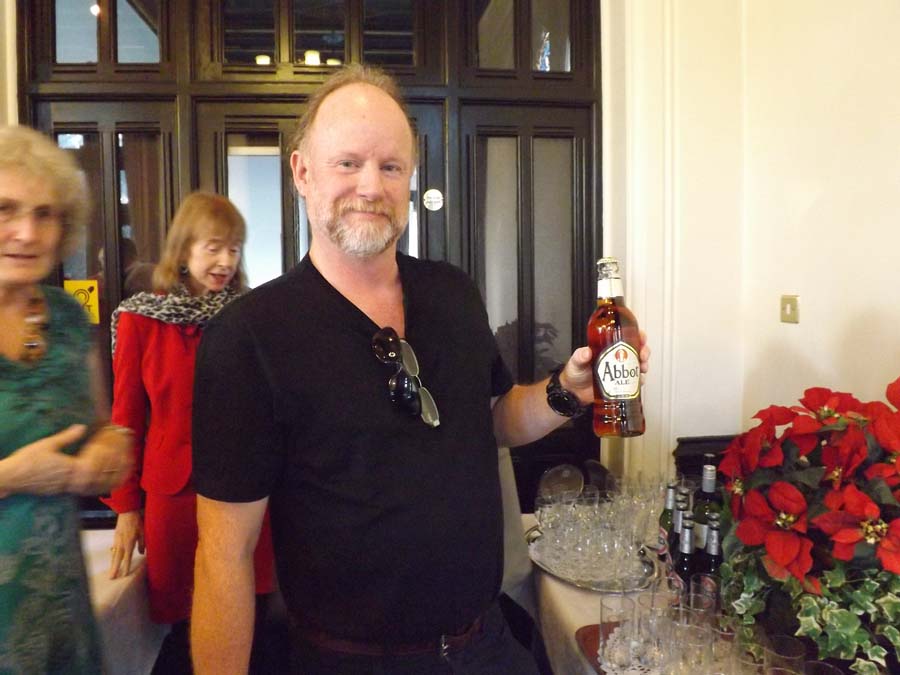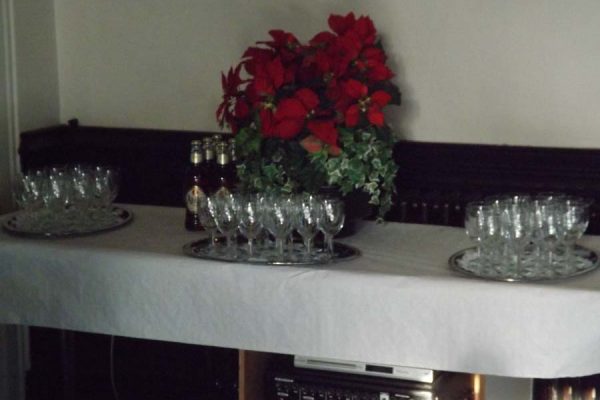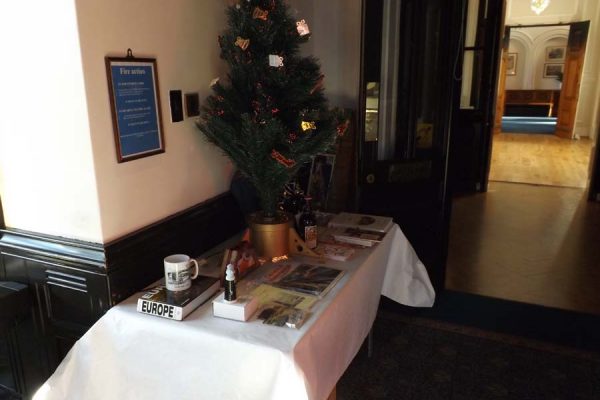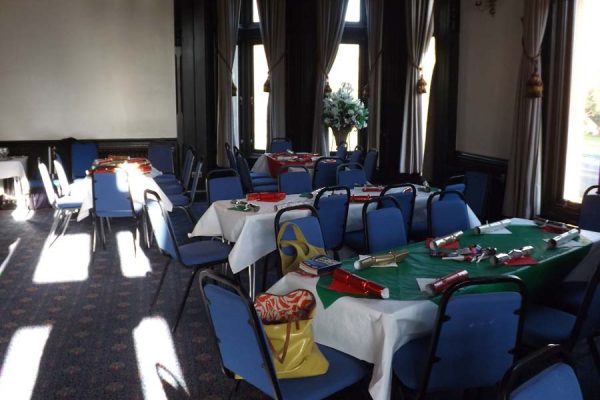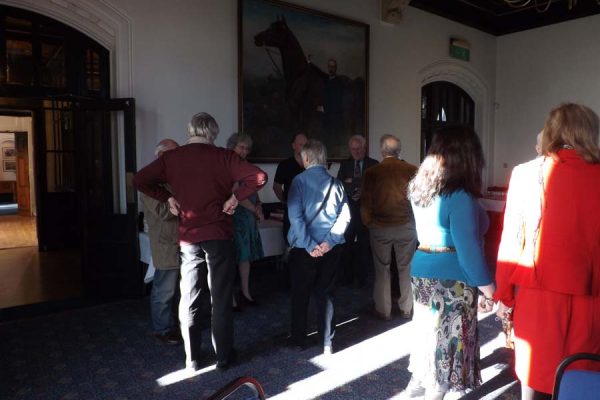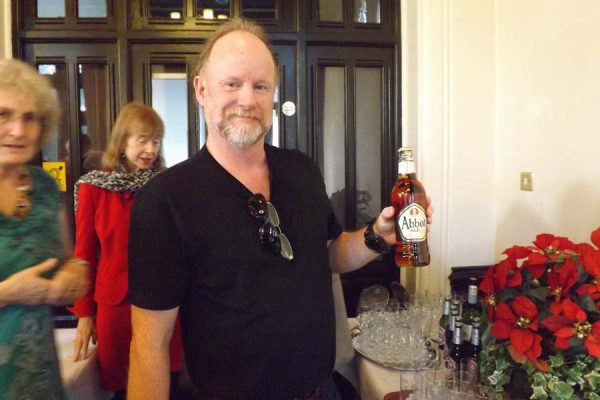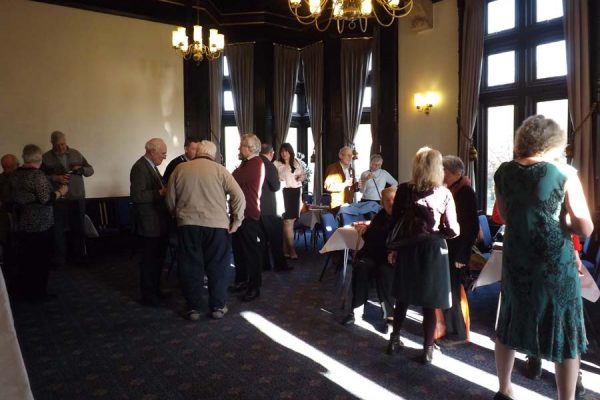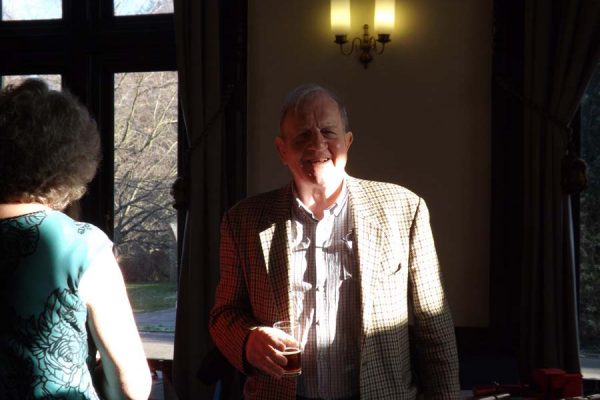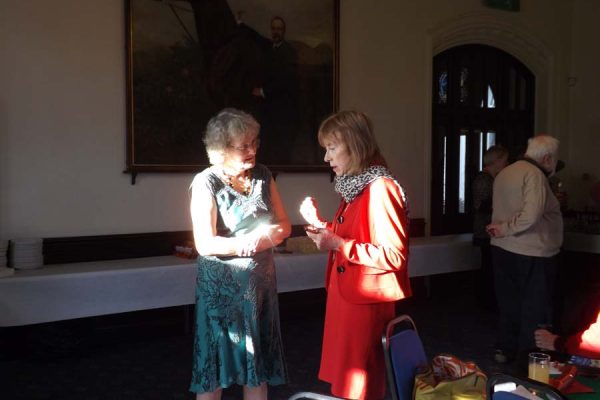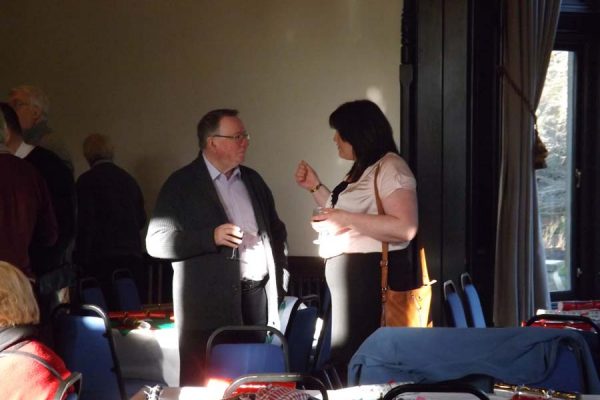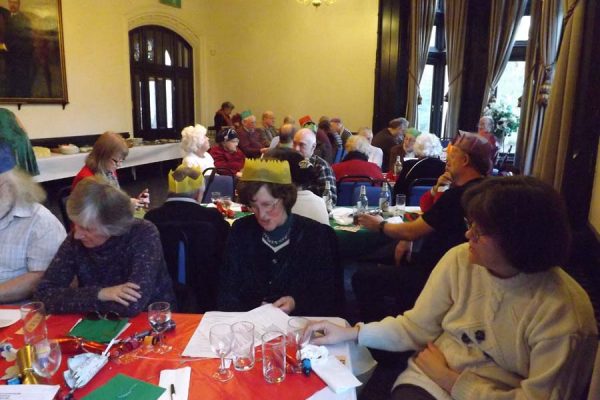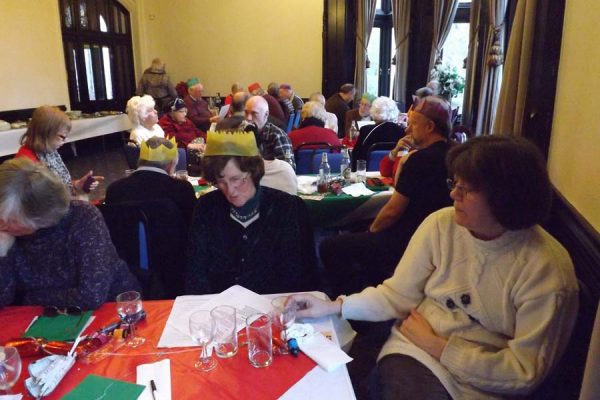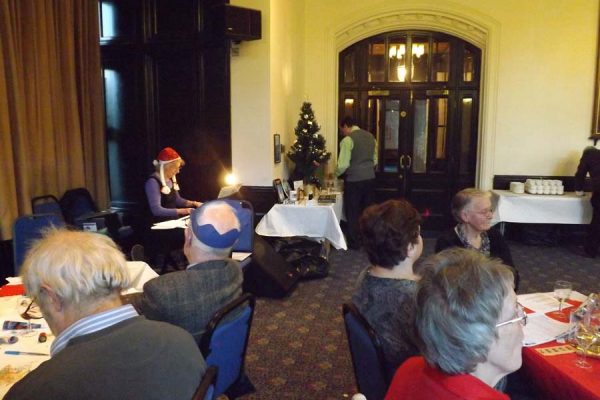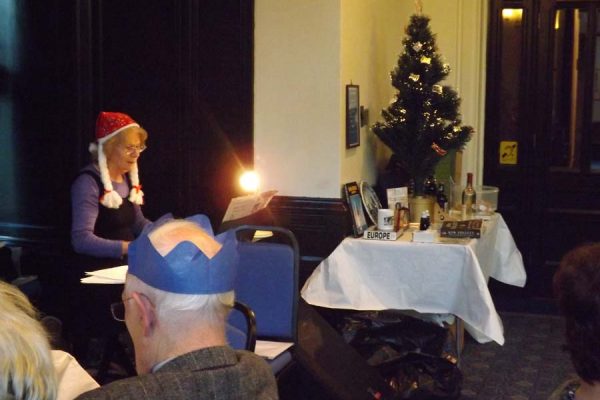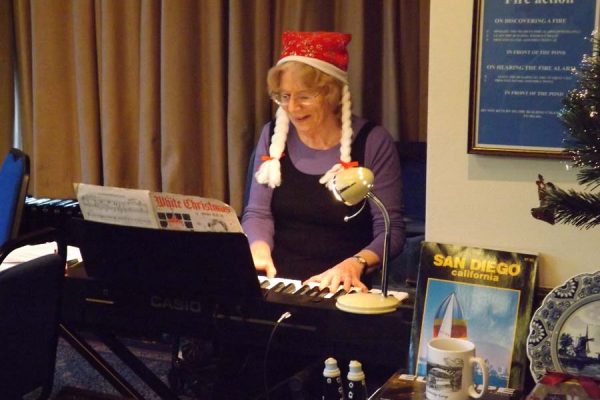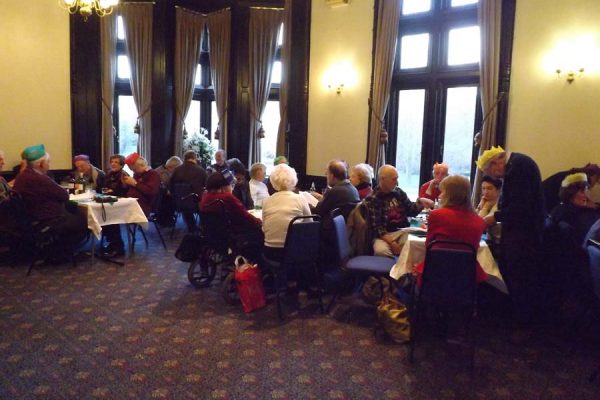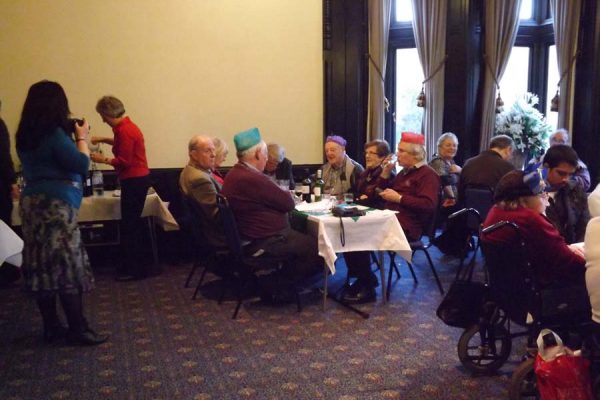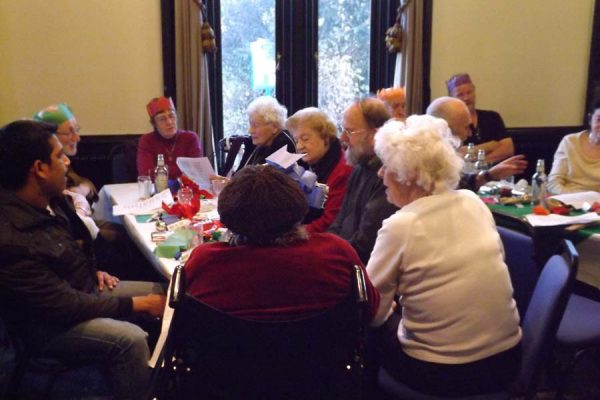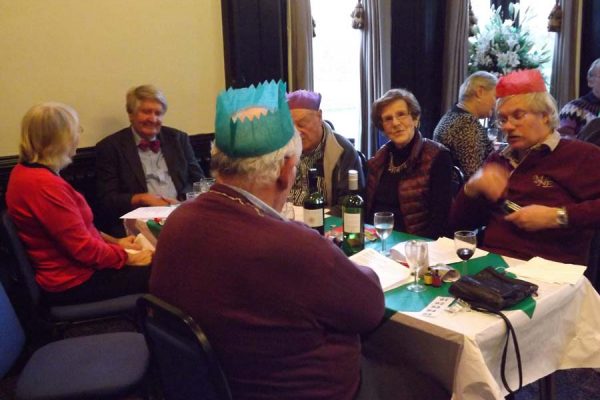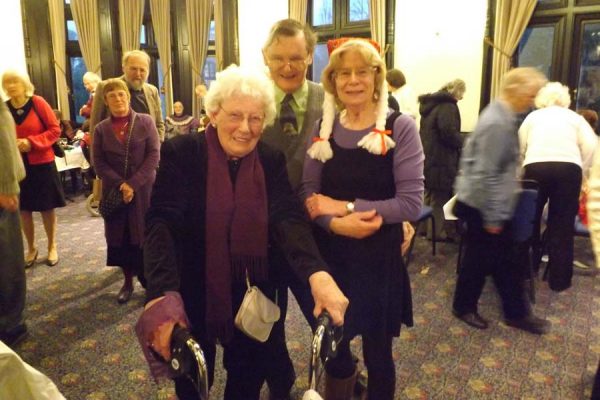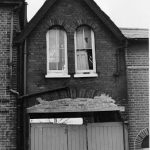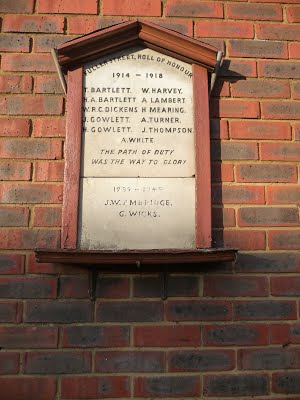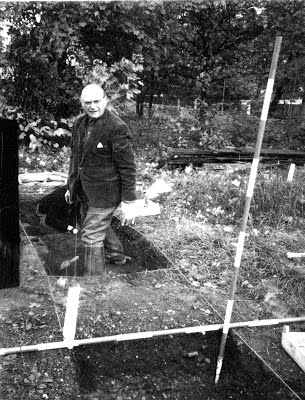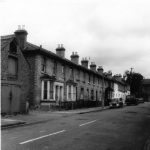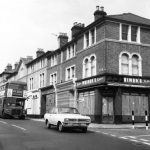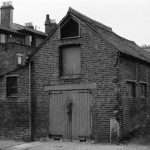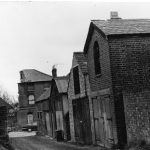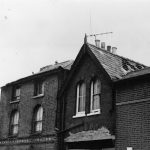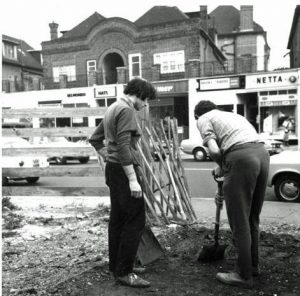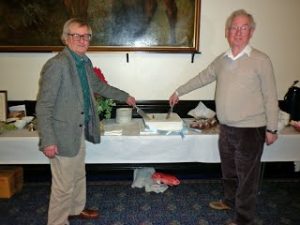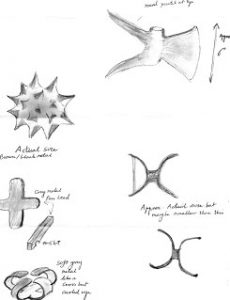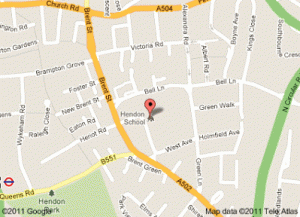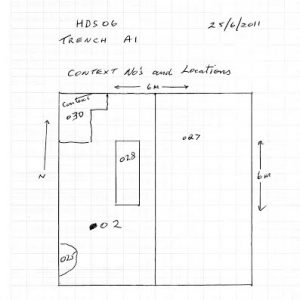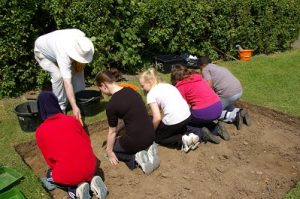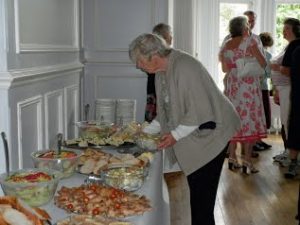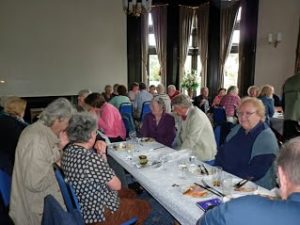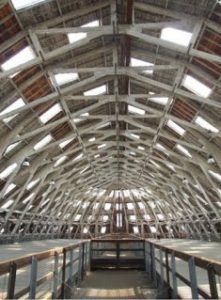Jun
06
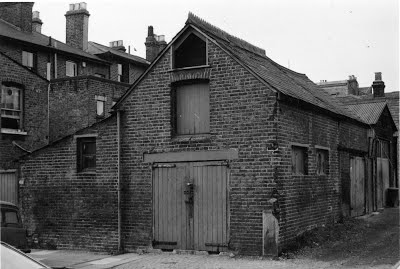
No. 494 MAY 2012 Edited by Sue Willetts
HADAS DIARY — Forthcoming Lectures and Events
Lectures are held at Avenue House, 17 East End Road, Fi nchley, N3 3QE and start promptly at 8.00 pm with coffee /tea and biscuits afterwards. Non-members welcome (£1.00) Buses 82, 125, 143, 326 & 460 pass nearby and Finchley Central Station (Northern line) is a short walk away.
Tuesday 8th May 2012. – Bumps, Bombs and Birds: the history and archaeology of RSPB reserves. Lecture by Robin Standring who is Reserves Archaeologist at the Royal Society for the Protection of Birds (RSPB) covering their reserves network, some 150,000 hectares of wild and beautiful countryside spread the length and breadth of the UK. With a background in field archaeology and a life-long interest in conservation, Robin is the first full time archaeologist employed by the RSPB, joining in 2009 with grant assistance from English Heritage.
There are some 200 RSPB nature reserves, and whilst these are known to be rich in wildlife, it is less well known that there are also many thousands of archaeological sites and features. Key highlights of the collection include almost 200 Scheduled Ancient monuments and one of the best collections of both prehistoric and military archaeology of any single land manager. Robin’s work has focused on ensuring the sympathetic management of these sites as well as making them more accessible and interpreted for visitors. The RSPB is also engaged in ambitious programmes of wetland and heathland habitat restoration and he is trialing methods to ensure that minimum impacts are made upon archaeological remains.
Thurs. 10th May Quiz at Avenue House
Tues 12th June 2012 – Annual General Meeting at Avenue House.
Sun 26th — Thur 30th August 2012 – Summer trip to Ironbridge.
Tues 9th October 2012 – The Life and Legacy of George Peabody. Lecture by Christine Wagg Tues 13th November 2012 – Archaeological discoveries in Southwark. Lecture by Peter Moore, Pre-Construct Archaeology (PCA)
Sun 2nd December 2012 — Christmas Party at Avenue House from 12 noon – 4.30 (approx) LAMAS 49th Annual Conference: Museum of London — 24th Mar 2012.
Andy Simpson. An excellent and informative conference, as always … and very well attended.
Morning Session: Recent Work
Guy Thompson from PCA in his talk entitled ‘An immense and exceedingly commodious goods station’ to quote a contemporary source, examined the archaeology of the Great Northern Railway goods yard at York Way, King’s Cross, dating to 1850-51, with its former mass of sidings industrial character and surviving buildings, tracks and wagon turntables, currently in part being restored for use as part of a University campus. Features studied since 2007, as the pace of redevelopment of the area increased, included subterranean stables.
Malcolm McKenzie from MoLA described the fascinating archaeology of the northern-side Thames waterfront at Three Quays House, Lower Thames Street, west of the Tower of London. Demolition of a long-derelict post-war office block involved the hand excavation of some 40 pile shafts each some 2m square over a ten-month period. Extensive and well-preserved remains of a second-third century Roman timber quay were found, with some
massive timbers surviving, some of them re-used architectural timbers of first century date; plus a huge deposit of unabraded Central Gaulish Samian, clearly deposited as a single (unknown) event, and in two or three shaft bases, the very denuded footings of the third century masonry riverside wall.
A medieval phase of medieval timber quay, south of the Roman quayside line, included more well-preserved timbers; some of them re-used boat timbers and sections of boat, hardly surprising since in medieval times this area was known for its shipbuilding. Contemporary with this was a huge quantity of metal-detected small finds, including buckles and pilgrim badges.
Joanna Taylor’s talk ‘The Thameslink Project in North Southwark: Recent work’ covered the detailed Network-Rail funded work by Oxford Archaeology/Pre-Construct Archaeology in advance of extensive redevelopment of the area. Work on the new Thameslink Borough viaduct has given further insights into building complexes in Roman Southwark, an area of islands and marshes/mudflats amidst the Thames in Roman times. The well-known Wheatsheaf pub site continued work by MoLA, with four metres of good quality archaeological deposits in the back yard/garden of the pub, eighteenth-century brick pub features and with finds-rich medieval cesspits cutting the Roman levels which included truncated masonry foundations.
A nearby site – Bedale St – involved the demolition of three properties (which will be rebuilt after completion of the viaduct) which sealed two metres of deposits – medieval soils and virtually no Roman levels remaining. The major feature was a large seven metre-wide ditch with evidence of a wooden fence that had collapsed into it. This feature was undated, but was post late-Roman and predates the 12th / 13th century. Perhaps this is a late Saxon ditch defining the Saxon Southwark bridgehead settlement.
Further work at 11-15 Borough High St (on the corner of London Bridge St) had high archaeological potential, being adjacent to the Roman road to the northern Southwark island. Modern basements had left islands of good archaeology, including a Roman masonry building with flooring intact and traces of underfloor heating and post-Roman robber cuts. The new building was redesigned to preserve as much as possible in the centre of the site. It is being interpreted as a bathhouse; its exact function is unknown, but it included a 5.75m diameter circular room and limescale accumulations on the floor, supporting this interpretation. Also found were substantial medieval stone foundations interpreted as part of St Thomas’s hospital. For more details see: http://www.thameslinkprogramme.co.uk/news/news items/view/106
John Shepherd in his talk ‘The Temple of Mithras 1954-2012: There and back again’ looked at recent work on the moving, further excavation, and re-interpretation of the famous Temple of M ithras, shortly to be moved back much closer to its original find spot and reconstructed in a much more sympathetic and architecturally correct manner than its crazy-paving floored open-air incarnation of the last 40 years in Queen Victoria St. The new indoors display will form a major part of the new development of the site, with dedicated entrance, interpretative area above to include the original and more recent excavation and general archaeology of the area, and temple display below in an enclosed space to reflect the feel of the temple when first built.
As is well known, the temple was first dug in September/October 1954 on the later site of Bucklersbury House. The temple was built in the 240s AD and converted to a temple for the cult of Bacchus in the fourth century. After public outcry ensured its ‘preservation’ in 1954, the footings of the temple – or rather, as it transpires from recent excavation on the site, most of them – were rather roughly dismantled and stored in roughly the right shape in a bomb-site cellar, quickly becoming disturbed and overgrown. A later move took them to Harrow prior to ‘reconstruction’ on the wrong site and with the wrong orientation. Much original material was lost and replaced with modern concrete, which was carefully removed during the most recent dismantling. Recent excavation on the original site has revealed in-site temple foundations, including mote of a front narthex entrance building, and good organic preservation. Careful plotting of remaining bombed Victorian cellar walls and other features permitted the original site and orientation to be located.
Afternoon Session: Roman Greater London
Isobel Thompson looked at ‘Putting the foundation of Londinium in context – the view from the North’. Looking at the foundation of Londinium based on the Hertfordshire Historic Environment Record (H ER), which indicates over 320 late Iron Age sites in Hertfordshire alone, with plotted settlement/find spots indicating distinct Iron Age styles of pottery divided by a distinct gap formed by the Roding Valley in Essex.
Our old friend (and President) Harvey Sheldon looked at ‘The Roman Pottery Manufacturing Site in Highgate Wood: Archaeology and Experiment’. Nearby Roman roads included Ermine St through Enfield and the suggested V iatores Route 167 through Mill Hill. Highgate is an ancient wood with oak and hornbeam. Ownership of the site passed to the Bishop of London in the seventh century; prior to that it was owned by the Kings of Essex, and may even have been part of the public land administered by the former Roman authority governing Londinium. In 1886 it passed to the Corporation of London for preservation as public open space following a vigorous campaign by those concerned it would be lost to rapidly spreading Victorian suburban development. There are undated banks and ditches in the wood. A 1960s survey looking for flints found first/second century Roman pottery such as poppy-head decoration beakers as well as Mesolithic flints, with a campaign of digging from 1966.
Kilns, kiln dumps/waster mounds and rough flooring were found, along with a series of ditches; kilns excavated had pedestals, walls and flues; one kiln, now removed and preserved off-site, had a tile-covered flue, this being the last kiln found. Some pots were found near-complete, sometimes reused to support flue arches. Fabric was reduced grey, some with grey slip using clay imported from elsewhere. The site appears to have four production phases and three types of fabric (grey/grog /sandy tempered wares), covering the period 50–160+ AD; there is also a surprising amount – some 354 sherds – of Antonine Samian ware dated 70–140+ AD, just as Brockley Hill yielded pottery other than that produced on site.
Martin Dearne kept the hall amused with a highly entertaining and informative review of Roman Enfield: ‘First Stop North of Londinium’. A major feature at the north end of this site on Ermine St. was a possible Mansio. This small roadside settlement, lying mostly on the western side of Ermine St, has mainly been investigated by the Enfield Archaeological Society, with the first recorded finds during suburban development in 1902: cremation burials at the edge of the settlement. Major study began in the 1960s, with the first proof of actual settlement. Much of the excavation work has been in back gardens, with the settlement site covered by housing and a school. So far, there is nothing of pre-Flavian (70s AD) date other than a ditch, the settlement beginning at the north of the site and expanding southwards from the suggested official Mansio/ Mutatio, with the settlement at its zenith in the second century. There is little evidence of great wealth or prosperity, but some glass from a cremation burial, and occupation continues into the late Roman period, late 4th/early 5th century, with one possible fifth-century military/civil service style belt fitting. The settlement lies in an overall landscape, with burials and possible villa sites to the west, possibly along with a tannery; recent discoveries – naturally found after the reconstruction painting shown at last year’s Roman Enfield exhibition was produced – are two southern E-W boundary ditches parallel to a small stream, perhaps reflecting an attempt to impress and showing civic pride, the ditch later replaced by a bank.
Alistair Douglas of PCA studied ‘The Enigma of Roman Shadwell’, the site lying on a gravel river terrace 1.25km east of Londinium, beyond the eastern cemetery, north of what in Roman times was Wapping Island in the Thames. In the 1970s, a robbed square masonry foundation was excavated, 5m square internally, interpreted at the time as a watch tower or signal station, though as Douglas pointed out, a better location for such would surely have been the high ground at Greenwich; it may actually have been a mausoleum, and is dated to the mid-second century. Finds from this dig indicated a large settlement, with Roman levels preserved by deeper soils on a slope, and clay and timber buildings of third/fourth century date, plus wells and two oven-like structures, and timber-lined tanks, possibly for water management-settling tanks?
All Shadwell sites have East Gaulish Samian – the latest of the Samian wares, produced in the Rhine region, perhaps for a site that was officially sponsored, though not necessarily a military one, reaching its peak in the mid-third century.
A further excavation in 2002 on the former Babe Ruth club site in Highway revealed more clay and timber buildings and a well -preserved apsidal bathhouse measuring 19m x 20m, with not all of it exposed. Facing the Thames, and with 16 rooms, it was the second biggest bathhouse in London after the baths at H uggi n Hill, and was of third century date, remaining in use for a century or more.
This seems to have had a communal use, suggested by remains of snacks including chicken bones, along with a fourth-century gold ear ring and gold bracelet, and also along with, according to the accompanying reconstruction drawings, other typical Roman bathhouse pursuits of carousing and indulgence in more earthy pastimes suggested by the presence of female accoutrements such as hairpins, finger rings and bracelets. In addition to the bathhouse and an associated clay and timber building, there was a boundary ditch and the previously recorded ‘tower’ building. The four sites excavated in the immediate area have yielded 800 coins, suggesting a settlement of roadside settlement/small town size, with good trading links to both Europe and Britannia’s interior via water transport. First/second century Londinium had been a logistics/distribution centre, but by the third/fourth century it was self-sufficient, though with a declining population and long-distance trade decreasing, with trade perhaps moving to the settlements at Old Ford or Shadwell. River levels were dropping, but Shadwell remained a vibrant centre to the mid-fourth century.
Finds in 2010 included a collapsed masonry building, with late Roman coins, and better preservation at the south end of the site, including a further Roman oven and a weathered first-second century altar stone. For general Shadwell background information, see http://www.museumoflondon.org.uk/Explore-online/Pocket-
histories/roman/roman_london_5.htm
http://www.ncl.ac.uk/historical/research/publication/178005 http://www.museumoflondonarchaeology.org.uk/Publications/pubDetails.htm?pid=31
David Bird looked at ‘Recent Excavations at Ashstead villa and tileworks, Surrey, and their implications’. The villa site was dug, in the manner of the time, in 1929, revealing a villa and separate bathhouse and evidence of tile-making. There are few surviving site notes – one sketch being literally on the back of an envelope – plus some contemporary press report. The site report was published promptly, with more work on the site in the 1960s; amateur excavation of this relatively remote site has recently continued for 13 seasons. There is a nearby three-period earthwork, originally prehistoric, with mid-first century and later Roman recutting. The villa has a floor plan seemingly unique in the Western Empire, but recent work has added a proper phasing plan, indicating that the building is not all one phase, revising the ground plan somewhat with differing phases of masonry. One room was lined with box flue tiles – whose overnight vandalism, even in 1929, prompted closure of the excavation. There may be a separate building of Flavian date. Geophysics has been done to find the ti l ery and two tile kilns have been found, one on top of the other. This may reflect this and other villa estates having an associated industry – tile, pottery, or stone working, or even timber cutting.
London’s Foundations Peter Collins
Recently, a report entitled London’s Foundations has been published by the Mayor of London. It can be seen at (http://www.london.gov.uk/publication/londons-foundations-spg). Although this is a planning document about London’s geology, it may be of interest to HADAS members as it highlights sites of geological interest across London, many of which have archaeological or historical associations.
A number of these geological sites are within the HADAS area or its vicinity, including Avenue House. When you visit there you may not realise you are standing on glacial till or boulder clay brought down by the Anglian ice sheet some 450,000 years ago. In the gardens, especially when the soil is disturbed by gardening works, the tell-tale pebbles of chalk can be seen. Nearby Coldfall Wood has similar features. Others sites in the vicinity include the complex of Hampstead Heath and Kenwood House, which is recommended by the London Geodiversity Partnership (LGP), http://www.londongeopartnership.org.uk/ as a geology site of regional importance (RIGS). Within Kenwood there is an abandoned quarry face, for the Bagshot sand and the hillocks of Sandy Heath are the result of similar exploitation. In the Heath, Claygate, the top-most member of the London clay was ideal for brick making and, in the nineteenth century, its extraction resulted in Viaduct pond.
If you have any comments or ideas on interesting geological sites in the HADA S area please contact me below and we can consider them within the LGP. Mobile: 07718 587739
E-mail: peter@collins-at-queenscres.org.uk
New map of Roman London Sue Willetts
On 17.1.2012, Julian Hill (MoLA) gave a lecture at the Museum of London which covered the background to the mapping of Roman London over the centuries — publicity for the new map: Londinium: a new map and guide to Roman London. The talk provided an overview of the history of recording Roman remains, known or otherwise indicated. The map shows public buildings, houses and defences which are shown superimposed on the modern street plan. Areas north and south of the river are shown, as is an indication of how the water levels and shoreline have changed over time. On the reverse and to the sides of the map is a detailed and well illustrated historical overview including 18 sites to visit with visible remains. There is a great deal of information included on this map including suggestions for further reading. The map costs £6.25 ISBN 978-1- 90786-05-7.
HADAS Finds Class Blog Stephen Brunning
Regular readers of this newsletter will no doubt know that HADAS took over the running of the old Post-Excavation Analysis class from Birkbeck College in September 2009 and renamed it “Looking at Finds”. If you wish to find out what we get up to behind the scenes on Wednesday evenings at Avenue House, check out the new blog at: www.hadasfindsgroup.blogspot.com. Please feel free to register as a follower, and/or post any comments you wish.
Crop marks Montrose Playing fields Bill Sibley
Having lived in close proximity to Montrose Playing fields for 70 years I am curious about the development of ‘crop marks’ over the past 3/4 years sited by the security camera near to the sports pavilion. Two large sunken rectangles approx 8 x 12 metres in size are becoming more apparent each year; they can be seen quite clearly on Google maps, just call up ‘The Greenway NW9 5AU@ this will bring you close enough to the location. The ‘sinks’ are similar to wooden beam wall foundations rotting away as when old tree roots rot away leaving ‘indents in the ground’.
From studying some old maps, I know that the footbridge nearby was built on the site of a ‘Ford’ for crossing the Silk stream that runs through the park on its way to the Welsh Harp and that some structure may have been built there in the past (who knows how early). I have spoken to older residents than I, who lived in the area during the war years and they discount air raid shelters as they were built further out in the playing fields which is where I remember them as a child before they were demolished. I am also aware of the tram shed and rail link from the park to Mill Hill Broadway sidings for bricks and supplies to Lai ngs when the housing in the area was developed in the late 20’s/ early 30’s on the site of the old Shoelands Farm land, but this again was further out in the field. Would this be of interest for further investigation either to HADAS members or any archaeology students living locally?
Spoilheap removed ‘by persons unknown’ –
The Fuller Street excavation 1974 Part 1. by Andy Simpson
(Part 2 will be continued in a future newsletter)
Following on from looking at the White Swan 1976 excavation, the author decided to look at another previously unpublished HADAS excavation, this time in central Hendon from 1974 – in fact, it followed on from the highly successful Church Terrace excavation of 1973-74, and was located only a short distance away to the east, but was much less successful.
The Fuller Street Area
The Church End area of central Hendon once featured a densely-packed area of Victorian terraced houses and workshops running down to Sunny Gardens and up to Church Walk, centred around the now lost or re-routed Prince of Wales Road, Heading Street, and Fuller Street.
As shown on the 1895 Ordnance Survey map (and Godfrey Edition of the 1912 OS map), the Victorian Fuller Street ran north-south off Church Lane (now Church Road), opposite Ravenshurst Avenue (where the south-eastern corner of Fuller Street – at NGR TQ 232 895 – had a shop, 48 Church Road, which acted as an outlet for the Express Dairy, College Farm, Finchley), towards Church Walk. Fuller Street was lined with typical (mainly) two-story, side-passage terraced houses of the time, dated around 1869, which had tiny fenced front ‘gardens’, fronting onto the pavement, and long, narrow back yards. At least until Edwardian times Fuller Street houses shared one toilet and a scullery between every two houses. The western side of the road’s houses began beyond Chad’s Alley which divided them from the backs of shops fronting onto Church Road at the corner, where there was also a traditional three-story corner shop (No. 46 Church Road, latterly ‘Weiner’s’ butchers, still standing in 1976 at NGR TQ 242 894), and backed onto the backyards of similar terraced houses in the parallel Heading Street. On the eastern side, the backyards faced out towards a builder’s yard and Sunny Gardens Road.
Luckily, HA DAS record cards with photos record the street and its environs in 1970-71, prior to total demolition.
The western row of twelve mainly flat-fronted houses on Fuller St, numbered 2-24, ended in two better quality terraced houses, nos. 2 and 4, with two bay windows flanking a shared entrance with portico-effect pillars. They stood adjacent to Chad’s Alley, running westwards through to Heading Street which also ran north-south off Church Road and was lined with a jumble of two-story brick-built former workshops and stables on its southern side. This southern side backed onto the buildings on Church Road. On the opposite side corner of this alley, also on the southern side, behind 46 Church Road, was a brick-built two-story former slaughterhouse, with roof loft, recorded on 11 December 1971.
The brick wall across the end of Fuller street at the Church Walk end, as well as having a gate leading to Richards builder’s yard, also mounted Fuller Street’s own tablet-style memorial to the men who died in two world wars, facing down the street; happily this still survives today, mounted on the gable end of a row of houses facing the present Fuller Street. There had been considerable correspondence between HA DAS and Barnet Council concerning finding a new location for it.
By 11 December 1971 the eastern side of Fuller Street, numbered 1-29, was being demolished; it featured at least one once-elegant three-story house with decorative brick banding (Nos. 3 and 5 Fuller Street, part demolished by 11 December 1971), adjacent to a gated entrance, with room above, leading to a small yard used as industrial premises by Express Dairies, and more two-story terraced accommodation next to this (No.1 Fuller St).
The whole area was demolished during clearances in the early 1970s, with the last family to leave Fuller Street being George David ‘Happy’ Bartlett and his wife Edith, the last of seven generations living there. From 1974 on it was replaced with flats fronting Church Road and modern low-rise housing. The original line of the street was lost; there is still a Fuller Street, but it runs at right angles across the original line of the old Fuller Street from Sunny Gardens Road before curving north to join the line of Sunni ngfields Road.
HADAS’s cache of photographs even includes two of cast-iron road gutter gratings, also taken on 11 December 1971, one made by Wm. Harris, Stratford).
The above photos show, on the left, the west side of Fuller Street (No.s 2-24) in August 1970, not long before demolition. Just visible on the left is the former slaughter house. The right-hand view is of 46 Church Road, at the corner of Fuller Street, still standing in 1976, being passed by an LT Routemaster bus on the 83 route.
The former slaughterhouse at the corner of Fuller St/Chad’s Alley, photographed on 11 December 1971, prior to demolition. Backs of Church Road shop buildings on left.
Also taken 11 December 1971, looking down Chad’s Alley, with the photographer’s back to the former Heading Street. Former slaughterhouse at end of alley on right and, beyond that, the part-demolished 3/5 Fuller Street; HADAS’s Fuller St trial trench ran behind these buildings.
Upper part of No.s 1,3,5 Fuller St, taken 11 December 1971 prior to completion of demolition. Nos 3/5 on right. The Fuller St excavation trench ran behind the site of these buildings three years later. Note distinctive round-headed windows.
close-up of premises seen in previous photo, formerly used by Express Dairies
(11 December 1971)
The re-sited war memorial (seen here in 2012)
The Excavation
This excavation (at approximately NGR ref TQ 23100 89450; Museum of London-issued site code FUL74) followed on immediately from the highly successful Church Terrace dig of 1973/74 a short distance to the west, and preceded total redevelopment of the area of Church End between St Mary’s and Church Road. Directed as ever at that time by Ted Sammes, there was one main trial trench across an area bounded by Church Road to the south, Fuller Street to the west and Sunny Gardens Road to the east, and a smaller trial trench at right angles to this some distance away.
The only published account is a brief mention in the HADAS Newsletters for August and October 1974 and January 1975. It was intended to grid the site on the weekend of 31 August/1 September 1974, with digging to start on the September 1st. A 24-metre long, one metre wide trial trench was cut north-south across the middle of the site. The trench crossed a concrete yard, which was partly removed to permit hand excavation, which normally occurred on Sundays. Newsletter 47, January 1975, recorded that the Fuller Street dig ‘…has proved unrewarding. Neither the objects found, nor the traces of structures such as a gravelled yard and an early pond, merit further work on the site. It has accordingly been discontinued’. The site plan is annotated (some years after the dig, possibly) as ‘Dig stopped when site huts burnt by ‘Kids’? Actually, the huts were left empty on the site after cessation due to its unrewarding nature; the HADAS Research Committee minutes for June 1975 record the destruction by burning of one of the two huts on site, and the resultant loss of tables and chairs.
The main trench ran along the former backyard/garden line of the eastern row of terraced houses along Fuller Street, from behind No.s 52-54 Church Road; it shows the line of their front wall, with an unexcavated gap and then brick footings and features such as WC drain, tile drain and manhole in the trench, in which five one-metre baulks were left.
Unlike the White Swan excavation previously recorded by this author, some site records do survive – a single site plan, and just one site photograph, in poor condition, showing long-serving HADAS member, the late George Ingram, standing in a narrow trench amidst the scrub, possibly in the small trial trench, with no features visible.
There are a number of mostly dirty, faded and water-damaged ‘context’ cards with rather minimal information – often just a date, grid number and digger’s name. Only a minority have any information on the nature of the contexts within the grid. There are also brief mentions in contemporary HADAS Committee minutes, which mention ‘the trial trench on this site is extremely disappointing. One area of cobble and gravel has been found [at the northern end of the trench – AS] which will be lifted to see if there is anything under it. Finds made so far do not merit extending the dig’ (15 November 1974) and ‘Work ended on December 15th; the Borough Architect’s Department had not felt that back-filling was necessary. They had kindly agreed to the Society’s huts remaining on the site pro tem’ and there was on-going discussion of the problems finding a new site for the Fuller St war memorial. The contemporary HADAS Research Committee minutes provide further detail, including recording removal of the spoilheap ‘by persons unknown’!
The card for grid A3 – the smaller trial trench – indicates it was dug on 27 October and 16 November 1974, with no features recorded. The photo above by Ted Sammes of the late George Ingram may show this trench. Scanned from a damaged print, it is the only known photo of the actual dig.
The main trench appears to be numbered into six grids, recorded sequentially along the trench as D2 to D7 inclusive, with D2 being ‘550cm to edge of [Church?] Road’.
Grid D2, dug 7th and 14th September, is recorded as containing rubble and garden soil at a depth of 24cm; Grid D3, dug 29 September, contained a disturbed brown layer with rubble at a depth of 17cm; D4 dug 20th October contained mixed soil at a depth of 40-45cm and was heavily disturbed; D5 dug 8 December at a depth of up to 91 cm contained the hard core of a former hard standing at 45cm depth and a field drain, and possibly a Bel larmi ne stoneware sherd; D6, as opposed to the usual two record cards per grid, has six, and was dug between 13 September and 8 December 1974 at a depth up to 1.12m, and contained sand and gravel and gravel and rubble at a depth of 88 to 1.12m overlying a burnt layer at 1.12m down, with a layer of laid pebbles at 50cm depth. Grid D7, dug 16 November, yielded at least one sherd of ‘Mocha Ware’, with gravel, rubble and mixed clay from a depth of 50cm down to the top of a sand layer at 95cm.
The site plan shows the ‘pond’ feature in the end three grids (possibly D5-7), the end one cut by a section bottomed at 1.10m. If the site plan grid references follow the cards, grids D2 and 3 contained brick footings, presumably of the recently demolished terraced houses and their outbuildings; Grid D4 angled brick footings and WC drain; Grid D5 pond, manhole and tile drain (as recorded on the cards) and adjacent granite block, Grid D6 the pond and two tile drains (one a probable continuation of that in D5 the other side of the intervening baulk) along with brick footings; and grid 7 the pond. To be continued, with finds information and analysis
Other Societies’ Events Eric Morgan
Fri 4th May 10.30 am & 12 noon. Friends of Barnet Libraries, South Friern Library, Colney Hatch Lane, N10. The nuts and bolts of local history. Talk with coffee.
Sats 5th , 19th & 26th May Trinity in May. Trinity Church Centre. 15 Nether St. N12 7NN. (Near Arts Depot) Arts, Music & Drama. Email art.sample@gmail.com. Also Finchley Art exhibition 12th – 17th May (Tel: 020 8446 0397)
Sat 5th – Mon 7th May Enfield Archaeological Society. Dig at Theobalds Palace, Cedars Park, Cheshunt, Herts. Volunteers needed for dig to west of great garden wall. Contact Mike Dewbrey 01707 870888 (office) for more details.
Tues 8th May – 5.30 pm . Institute of Archaeology, UCL/British Museum Medieval Seminar. Room 612, 31-34 Gordon Sq. WC1H OPY The Roman–Saxon transition: new evidence from excavations at St.Martin’s-in-the-Fields. Alison Telfer.
Sun 13th – Mon 21st May Barnet Borough Arts Council. The Spires, High St, Barnet. (i nc HA DA S)
Tues 15th May 6.30 pm LAMAS, Clore Learning Centre Mus. of London London Wall EC2Y 5HN The Walbrook: its archaeology and history: a water engineer’s view. Stephen Myers. Visitors £2.00
Wed 16th May – 8.00 pm. Islington Archaeology & History Soc. Islington Town Hall, Upper St. N 1 How archaeology transformed the study of Saxon London. Talk by Bob Cowie (MOLA)
Thur 17th May 6 – 8.00 pm. Friends of Barnet Libraries, Hendon Library, The Burroughs, NW4 4BQ Open evening at Local Studies including tour and presentations.
Fri 18th May 6.30 – 9.00 pm. L.A.A.R.C. Mortimer Wheeler House, 46 Eagle Wharf Rd. N1 7ED. The archaeological archive at twilight. Go behind the scenes to view rarely seen finds. Curator-led tours & object handling. Book in advance £6.00, Concs. £5, Friends £4. On 020 7001 9844 or www.museumoflondon.org.uk/events
Fri 18th May – 7.00 pm. COLAS. St.Olave’s Parish Hall, Mark Lane, EC3. Recent excavations at Holborn Viaduct. Talk by Dave Saxby (MOLA) £2.00
Fri 18th May – 6.00 pm. Museums at night. Islington Museum, 245 St.John St. EC1 V 4N B. Radical Clerkenwell. A brief political history of Clerkenwell Green. Talk by Ben Smith then: 7.00 pm The Marx Memorial Library. Tour by John Callow. Both events are free.
Tues 22nd May – 7.00 pm. The London Archaeologist. Inst. of Archaeology, UCL. Annual lecture & meeting. The archaeology of a Royal Peculiar: new light on Westminster Abbey and its furnishings. Prof. Warwick. Rodwel l. Preceded at 6.30 pm by a wine reception. Free but please RSVP for the reception. becky.wallower@dial.pipex.com
Sat 26th – Sun 27th May 11 am – 4pm. COLAS at the Tower. Foreshore access & public displays. Part of Festival of British Archaeology. Activities in the open space in front of the Tower including handling finds approx. 11 am – 1.00 pm on Saturday and 11.30 am – 1.30 pm on Sunday. http://www.colas.org.uk/documents/COLAS_FBA2012_A5.pdf . Note change of usual date.
Thanks to: Stephen Brunning, Peter Collins, Eric Morgan, Bill Sibley, Andy Simpson.
No. 493 APRIL 2012 Edited by Peter Pickering
Membership Renewal – by Stephen Brunning, Membership Secretary
The HADAS membership year runs from 1st April, so all memberships are now due for renewal apart from those new members who have joined since January this year. I have enclosed a renewal form for those people who pay by cheque, and would ask that you return the form to me along with your remittance for the appropriate amount. The rates remain unchanged.
Anyone who thinks they should have had a membership renewal form or Standing Order form but hasn’t received one, anyone who wants to make their membership under Gift Aid and hasn’t already done so, or anyone who has any question at all about their membership, please contact me. (Contact details on back page).
Many thanks.
HADAS DIARY – Forthcoming Lectures and Events.
Lectures are held at Avenue House, 17 East End Road, Finchley, N3 3QE, and start promptly at 8 pm, with coffee/tea and biscuits afterwards. Non-members: £1. Buses 82, 125, 143, 326 & 460 pass nearby and Finchley Central station (Northern Line), is a short walk away.
Tuesday 10th April 2012 Conservation Techniques in Stone Masonry. Lecture by Stephen Critchley.
Stephen Critchley has been a stone mason for over 30 years, and has worked on projects such as Queen’s House Greenwich, Palace of Westminster, Woburn Abbey, Somerset House, Stoneleigh Abbey and many more. Stephen is now a master stonemason and part of his job is to talk to people about the craft using the experience gained from many years of working on some of the most prestigious heritage projects over the last four decades. He will cover the craft of stonemasonry (traditional and modern), the history of stone architecture and the techniques and materials used.
Tuesday 8th May 2012 – Bumps, Bombs and Birds: the history and archaeology of RSPB reserves. Lecture by
Robin Standring (RSPB Reserves Archaeologist).
Tuesday 12th June 2012 -Annual General Meeting.
Sunday 26th -Thursday 30th August – Summer trip to Ironbridge
We still have a few places left for this trip. We will be based at the Best Western Valley Hotel, in the Severn Gorge. Although we will visit some of the museums in the immediate area, we have a number of other places to visit including Wroxeter Roman town, church and vineyard, Severn Valley railway, the RAF museum in Cosford and Shrewsbury – which has a large number of Tudor buildings.
Cost as last year is £390 per person in a double room or £450 in a single room. This includes bed, breakfast, packed lunches and evening meals, coach costs and the entry costs for visits. If you wish to join the group for this trip, please contact Jim or Jo Nelhams on 020 8449 7076.
Tuesday 9th October 2012 – The Life and Legacy of George Peabody. Lecture by Christine Wagg. Tuesday 13th November 2012 – Archaeological Discoveries in Southwark. Lecture by Peter Moore (Pre- Construct Archaeology)
Sunday 2nd December 2012 – Following our enjoyable Christmas event at the end of last year, we have again booked Avenue House. The “party” will run from roughly 12:00 to 4:30. More details in due course.
‘The Archaeology of Human Origins – Update!’ course Peter Nicholson
The Mill Hill Archaeological Study Society is running a course of six classes with this title. The course gives you the opportunity to find out if you share the genes of a Neanderthal. It is both an introduction to and an update on the study of human origins. We will examine the biological and early cultural evolution of humans from the time when hominins (our ancestors) first walked upright. Our aim is to look at those factors which make us human: tool manufacture and use, the development of language, material and non-material culture, as well as biological studies such as DNA which are revolutionising our ideas of evolution. The discovery of ‘new’ human species such as Homo floresiensis (the Hobbit) and the Russian Denisovans will be examined. As for the Neanderthals – are we linked generically – join the class and see! The course tutor is Scott McCracken. The course is on Friday mornings from 10 to 12, beginning 20th April, in the Eversfield Centre, 11 Eversfield Gardens, Mill Hill, NW7 2AE. The cost for the course will be £40. Enrol at the first meeting; if you have not previously attended the Society’s meetings please contact the secretary, Peter Nicholson (020-8959 4757). http://www.mhass.co.uk
A shameful anniversary Don Cooper
On the 31st March 2012 Church Farmhouse Museum will have been closed for a year. What remains of the collection is lying packed for disposal or storage awaiting a London Borough of Barnet (LBB) decision. After nearly a year of part-time work by LBB heritage staff the collection has finally been catalogued but has not yet been published. The collection which belongs to, and should be on display for, the people of Barnet is said tob e subject to a disposal policy consisting of a combination of outright sale, disposal to other non-Barnet
Museums or deposited in deep storage, whatever that is! The grade II* listed building has been handed over to LBB property services to be sold – interest and offers to be received by May 2012. In the meantime the property is deserted and forlorn; the garden is being minimally maintained with the pond overgrown and lots of litter strewn around. This, one of the oldest buildings in Barnet and of special architectural interest, deserves better than this. LBB have a duty of care towards the building and it is up to all of us to cajole, plead and persuade them in every way possible to carry out this task proficiently. So I ask you to speak or write to your local councillors and remind them of their obligation; after all we elected them inter alia to look after the heritage of the Borough.
Transport Corner Andy Simpson
Another book to look out for if you have £8.95 to spare and an interest in the history of the Northern Line.
The London Underground Railway Society have published (in November 2011) a new and greatly expanded edition of an original 1981 booklet, this time titled ‘The Northern Line Extensions’ by Brian Hardy and ‘MRFS’. This covers the uncompleted pre-war planned extensions to Alexandra Palace and beyond Mill Hill East to Edgware and Elstree as part of London Transport’s massive pre and post-war New Works Programme, abandoned after the war when often on the verge of completion, such as the current rails reaching at least as far
as Mill Hill (The Hale). In 70 or so A5 sized pages, with colour covers and track plans, it gives a comprehensive ‘Then and Now’ account of our local tube line and how it might once have served Brockley Hill, Elstree South and Bushey Heath. Many of us are familiar with the still just-visible part demolished brick viaduct arches on the site of the uncompleted Brockley Hill station. It is a well-illustrated book; highlights include detailed track plans of such delights as Highgate Depot, Finchley Central (with former coal sidings), Mill Hill East south and north goods yards, and even the two-siding goods yard at the now-lost and buried Mill Hill (The Hale) station. There are numerous 1930s-50s shots of Finchley Central station – even with a BR diesel unit visiting on an enthusiast’s tour in 1960 – East Finchley station, Highgate depot and Park junction, Woodside Park with both of its signal boxes, Mill Hill The Hale goods yard, a steam-hauled special on Dollis Brook viaduct in 1956, aerial views of Edgware, and even a snapshot of a BR diesel loco shunting the yard at Edgware (GN/LNER) station circa 1962-64, upon the site of which now stands Sainsbury’s. It is worth remembering that BR goods trains worked to Edgware until 4th May 1964 (the track was lifted that September), and could reach Highgate Depot until the tracks through Highgate tunnel and Crouch End linking it to the main line at Finsbury Park closed in October 1970, being lifted in January 1972. The proposed track plan for the intended terminus depot at Bushey Heath, which became the vast Aldenham London Transport bus works, is most impressive!
An intriguing book with a mix of ‘wish I’d seen that’ and ‘what might-have-been’ (loss of more green belt around Brockley Hill, probably, as development followed the railway as it did beyond Golders Green in the 1920s) . Available from the Ian Allan bookshop at Lower Marsh, Waterloo. ISSN 0306-8617.
Personal Details, Data and Privacy Matters Mary Rawitzer
We have recently re-started including photographs in HADAS newsletters. We keep computer records for HADAS membership details and addressing newsletter envelopes. In earlier years HADAS used to issue all members with a Members’ List giving everyone’s full address and phone details.
Nowadays we all seem to be more aware of privacy concerns and some committee members have raised questions about these different matters. At the moment we have cleared that our computer records do not need to be registered in any way. And we certainly wouldn’t give out anyone’s details without first checking with the person concerned. But maybe you don’t want your name, or picture, in the newsletter? If so, please tell me (contact details below).
And is there any demand for a members’ list? If so, also let me know, or send your objections. I look forward to any reaction.
8 Southwood Lawn Rd, London N6 5SF Tel 020 8340 7434
E-mail: mary.rawitzer@talktalk.net
February Lecture – Winchelsea, Cinque Port and Medieval Town Sigrid Padel
This lecture traced the unusual development of Winchelsea from early medieval village to prosperous trading port which was succeeded by a planned town which was never completed. Richard Comotto of Winchelsea Archaeological Society first outlined the geological events which led to the development of Winchelsea. He described the multiple changes in the shoreline of that part of the coast of Sussex and Kent. At the end of the last glaciation this area was not covered by ice, but rivers running south from the icecap deposited masses of flint from the chalk downs to the north. As the ice receded and sea levels rose, these deposits were shifted by storms and currents and formed the shingle banks which eventually enclosed this low lying area, now Romney Marsh. Romney, a Saxon fishing village, existed by AD 600. After a breach caused by further coastal movement, Romney declined. The river Camber formed a shallow lagoon in which two fishing villages were established, Old Winchelsea and Rye. Both thrived on North Sea fishing, mainly of herring, which was processed, i.e. dried or salted, in Yarmouth, where the Cinque Ports enjoyed special rights. This formed the basis of considerable wealth during the following centuries, leading to both Rye and Winchelsea becoming confederates of the Cinque Ports. Later they acquired the full status of members of the league. In years to come Winchelsea provided the largest number of ships to the King’s fleet. Climate change during the 13th century caused further coastal changes. Violent storms destroyed the coastal barriers on several occasions. Old Winchelsea was inundated several times by storms during the 13th century. Finally, in 1280, it was completely swamped. The church had already been destroyed in 1271.
Edward II had previously acquired land on a hill above the marsh between the rivers Camber and Brede, where a small settlement named Iam or Higham was built. The king decided to create a new Winchelsea in this spot. It was to be built on a roughly triangular plot of land. Planned towns were not unusual in England during the Middle Ages. They were built on a grid pattern. Though sometimes likened to the French ‘Bastides,’ Richard Comotto insisted that this was not true. (During the course of the lecture he questioned several myths concerning French connections which are thought to have affected Winchelsea’s history over the centuries.)
The new harbour was situated on a shelf beside the river Brede and the town on a spur above. It was to contain 39 quarters. East-West roads were to be numbered. This has nothing to do with New York, but was usual in medieval planned towns. There were to be a curtain wall and defensive ditch and four gates, 803 square or rectangular plots of different sizes and a one-way traffic system! A very large church was also to be built. But the town was never completed according to this ambitious scheme. Three churches were planned, but only one, St. Thomas, exists. It was intended to be very large, filling one whole plot, but the nave was never finished and has since been destroyed. What remains as the present parish church is merely the chancel of the original design. Spike Milligan is buried there!
Three of the four gates and only four of the civic medieval buildings remain, and Richard’s photos illustrated how much they have been altered over time. There is also the ruin of the Grey Friars monastic chapel.
From the 13th century the town was largely self-governing. It was, and to some extent still is, ruled by the mayor and corporation, consisting of 12 freemen selected by the mayor. He, in turn, is elected by the local freemen, property owners of the town. Winchelsea later became one of the infamous ‘Rotten Boroughs’, where, until the reforms of 1832, a small population was represented in Parliament by two members.
Winchelsea prospered until the 16th century, though never enough to complete the ambitious original design. One remarkable remnant of the early period is a large number of cellars. Over thirty are accessible, and it is known that there are many more. These cellars are well-built vaulted structures. Their most likely use was to store wine from Gascony, one of the major imports.
New Winchelsea, unlike its predecessor, was a river port. There had been economic decline since the middle of the 14th century. When the River Brede finally silted up around 1540, the town lost its raison d’etre. Never having reached its intended size it gradually became what it is now: a rather gentrified village of 280 households.
We were both entertained and informed by this history of the rise and decline of this medieval town, governed both by natural causes and changes in economic conditions. In my opinion it would be a wonderful venue for a HADAS outing.
Current Archaeology Conference Peter Pickering
I attended Current Archaeology’s annual conference on 2nd and 3rd March. It was in the University of London Senate House, a splendid if perhaps Stalinist building by Charles Holden, the architect of many Underground stations. The Beveridge Hall, which holds 450, was well filled, very largely, I judged, with Current Archaeology readers from outside London. The programme was varied, with sessions on megalithic monuments, Roman urbanism, Rescuing the past, Vikings on both sides of the Irish sea, Bodies and battles, Ancient Trade in the Mediterranean, and Living in the Iron Age. The Keynote Speaker was Mark Horton, who amid a wide-ranging and hard-hitting analysis of the state and impact of archaeology to-day singled out for condemnation Barnet Council’s closure of Church Farmhouse Museum.
I was very taken by most of the papers, though some did not chime in with my interests, or coincided with the sleepy parts of my circadian rhythm. Timothy Darvill saw the removal of bluestones from Preseli in
South Wales to Stonehenge as a deliberate transfer of power. Daniel Lee described a very recent excavation of a chamber tomb on South Ronaldsay which was in the process of being destroyed for a car park when it was discovered; it has been dubbed the tomb of the otters, because of the quantity of otter sprait (droppings) there. William Bowden talked about Caistor-by-Norwich; he wondered if the fourth century activity, paralleled only by Cirencester, suggested it might have been a provincial capital. Tony Wilmott spoke on Richborough, where
the Roman remains have suffered not from erosion but from deposition. Stephen Harrison from Dublin has been working over antiquarian reports of and collections from furnished Viking graves, demonstrating (as if HADAS needed to know!) how much real knowledge can come from old records, if they are studied properly. Andrew Wilson asked why the Romans, unlike other pre-modern economies, did not see a drop in per-capita income as the population increased; it was because they did have the benefits of expanding industry and trade – ships were larger, production of commodities such as olive-oil was on an industrial scale, with the benefits of division of labour; there were massive public works; and considerable revenue from customs duties. Philip Kenrick illustrated a particular example of Roman industry and wide-ranging trade – that in Italian Sigillata pottery – the Arretine ware that was the precursor of what we call Samian, and which has informative makers’ marks.
HADAS TRIP – THURSDAY and FRIDAY 22 and 23 September 2011
Carisbrooke Castle Steve Clews
This was a great opportunity to visit a castle complex that has examples from practically all the stages of its development as a defensive fortification. This made it possible to see clearly how the castle was
continuously remodelled to meet the new threats arising from the changing technologies of medieval and early modern warfare.
Unusually for England its key role in defence against seaborne raids on the Isle of Wight and the strategic Spithead fleet anchorage and the naval base of Portsmouth, meant that this castle was not slighted to prevent its use in civil war and remained functioning right into the 19th Century when volunteer regiments used it as a training base during the French scare of the mid 19th century.
This charmed life was probably also due to its use in the immediate aftermath of the first Civil War as a political prison, holding first King Charles I, and part of his family, and later his Commonwealth opponents.
It was here that it became clear to the Parliamentary negotiators that capture of the King and removing his ‘evil councillors’, the classic aim of aristocratic rebellions, was a blind alley when faced with Charles’s obduracy. It was at Carisbrooke that the Parliamentary Army took over the guarding of Charles leading to his journey under Army guard to Newport and eventually to the scaffold at the Banqueting House, Whitehall in January 1649. Hence the lines in Andrew Marvell’s ‘Horatian Ode’ of 1651 where he talks of ‘Carisbrooks narrow case’.
Carisbrooke still has its Norman motte under the existing shell keep. The Saxon Burh and the first Norman earthworks are no longer visible, but their existence can be deduced from the results of small excavations over the years and remaining traces.
The major works by the Redvers family in the 1130s created the basis of the current medieval castle. The curtain wall, the keep and the gatehouse were built at this time and remain substantially intact today. Ironically, the attempt to hold the castle for the Empress Maud against King Stephen during the civil war years of the ‘anarchy’ ended anticlimactically when the well ran dry! The Redvers family then had to perform some heroic political lobbying to regain their lands.
(The response to the water problem was answered by the current Well House and its popular donkey power, which is covered separately)
Most of these defences were remodelled later in the 14th century as the strategic significance of the castle became clear in the cross channel conflicts of the Hundred Years War. The curtain wall has spectacular views across almost the whole of the Island, and signal stations would have kept the garrison fully informed of
the track of any fleets or raiding parties on or around the Island. As we saw elsewhere on our trip, French raids occurred on several occasions in the 14th to 16th centuries, and the Spanish Armada cruised past the island.
The Gate tower in particular was heightened and remodelled at a date soon after the French raid on the Island and the brief siege of the Castle in 1377. The Gate tower was rebuilt with gun ports (initially for hand held guns) indicating the arrival of artillery as a battle weapon.
The next major adaptation came under Sir George Carey in the late 16th century. The fact that he was related to Elizabeth I gives an indication of how central government saw Carisbrooke Castle as a key command.
Under Carey two of the 13th century towers were lowered to provide battery positions. The Eastern artillery platform now known as the ‘Bowling Green’ was constructed at this time. Significantly these defence lines were massively extended a few years later to meet the Armada scare of 1597, and an Italian engineer was brought in to bring things up to the very latest continental standards. The whole of the castle was surrounded with the latest model artillery bastions and enfilading ditches. The defences thus rival those of Berwick on Tweed which were similarly ambitiously remodelled at this time and remain the stand-out examples in this country of an extended artillery defence system.
Carey also remodelled the 13th century hall and chapel and built his own residence within the medieval shell. These adaptations produced the rooms where Charles was to spend his imprisonment.
After its period as a political prison and as the local Militia headquarters, the Castle was remodelled again to provide a home for Victoria’s favourite daughter, Princess Beatrice. The old medieval hall and the suite occupied by Charles as a prisoner were adapted or rebuilt. The St Nicholas chapel is now a magnificent example of late Victorian-Edwardian neo-medievalism, with its Burne-Jones like fittings, a style very different from the High Victorian we saw at St Mildred’s Whippingham.
The latest remodelling is the reconstructed Privy Garden of 2009 tucked behind the chapel.
Carisbrooke Castle: The Well, the Wheel and the Donkeys David Robinson
When I first discovered that the 2011 HADAS trip was to include a visit to Carisbrooke Castle it immediately occurred to me that, as a patron of the Donkey Sanctuary in Sidmouth, I should produce a brief article on the working donkeys there. Having noted a large crowd gathering when a donkey was about to work I was immediately confirmed in my decision. Later, on the ferry returning from the Isle of Wight I encountered a group of happy schoolchildren (the same group that had crossed with us on Monday) and asked what their favourite experiences on the island had been. As a result of this unscientific survey I discovered that Carisbrooke Castle had been their favourite destination and Jim Bob the donkey on duty their favourite character.
The five working donkeys housed at Carisbrooke have a very easy life. At present the donkeys are: Jim Bob (an elegant twelve year old gelding already noted as working on the day of our visit); Joseph (at eighteen the oldest working donkey); Jack and Jill (both eleven years old who were born on the island and who are half
brother and sister); and, Jigsaw (the ‘baby’ who is still undergoing training). We were told that all donkeys housed at Carisbrooke have names beginning with ‘J’ because Charles I when imprisoned there used this initial to sign secret letters.
A brief conversation with Rachel Hunter (the Donkey Keeper on duty) revealed that each donkey was required to work for no more than eight minutes per day on the wheel. They receive at least six to eight months training before they can work in public demonstrations. Jim Bob is an experienced performer who has been working the wheel for six years and will probably continue to do so for another twelve or thirteen. He is an ex- show donkey and certainly knows how to play the crowd. Indeed, he was only too aware that a few mints had been slipped to Rachel for his reward. Since donkeys are quite capable of living to fifty years if well cared for, Carisbrooke provides an excellent deal from their point of view. In short, they are given proper training for the job; provided with full board and lodging and have in place an enviable retirement package. Readers can draw their own conclusions.
At Carisbrooke the well itself is of considerable interest. It was sunk in 1150 and has a depth of 161 feet. The average depth of water is about 30 feet, but there is still a good deal of mud at the bottom. Rachel explained that the upper levels of this deposit had been excavated by divers about five years ago and the finds were on the whole unremarkable. They mostly consisted of Victorian coins, plus mobile phones etc. but notably also a set of false teeth. The well treadmill was originally worked by prisoners and this situation continued until the very end of the seventeenth century at which point the donkeys took over in much more strenuous circumstances than now exist. Rachel explained that she and some colleagues had been on the wheel and that it was extraordinarily hard work for bipeds to raise a full bucket of water 130 feet. Today’s donkeys
have a much easier task since they only have to raise an empty bucket twenty feet. This is done with two turns of the wheel whilst it takes seventeen to raise water from the full depth. The wheel itself was built in 1588 and has an oak frame. More recently however the actual treading surface has been replaced with pine to make it easier for donkey hooves to get a grip when working.
In the recent past horse and donkey powered wheels were in fairly common use in this country – providing power for such diverse activities as pumping water; squeezing apples for cider or crushing ore. A number of these wheels have been preserved; for example, a horse wheel from Aylesbury in the Science
Museum in London. However, the only wheel in actual use is that at Carisbrooke and the reason for its survival is very simple – the visitor industry. Ironically, in the past it was the well water at Carisbrooke Castle that
made the garrison impregnable. The earlier well, constructed in the keep, was simply not sufficiently reliable for such purposes. Now, the wheelhouse and the resident donkeys have become a major attraction for visitors to
the Island – so it is open house to everyone.
Memorable visit to the Isle of Wight Postal Museum Patrick McSharry
Our visit to the Postal Museum was a rare and interesting treat. For me personally it was a defining experience as I will reveal later in this article. It was a unique opportunity to go down memory lane and indulge one’s own personal eccentricities. First impressions might have indicated that such a visit would only appeal to the male members of the party i.e. gender specific but it soon became clear, almost from the start, that once we entered the museum memories came flooding back with the result that all us were literally spell bound by what we saw. People were engrossed and delving deeply into their bank of memories. Eavesdropping peoples’ conversations soon confirmed this. It was, quite simply, an ‘Aladdin’s Cave’ of postal memorabilia. Every conceivable item associated with the postal service was there to be seen and enjoyed. What caught one’s immediate attention upon arrival was the collection of post (pillar) boxes standing like sentries in a large, green open space outside the museum. Like latter-day warriors they were a splendid memorial to the halcyon days of the letter box exuding as they did a creativity of design and variety which judging by current examples of post boxes appears to have evaporated completely.
This was no ordinary museum. The museum was born out of an obsession, the obsession of one man for street furniture. Arthur Reeder, originally from Harrow Middlesex, relocated the museum in the Isle of Wight
2006 specifically to house his ever-expanding collection of small items and small post boxes which was and remains his abiding hobby and intense passion. That said, Arthur did confide to me that his main interest was railways. Arthur had always wanted to set up a museum but simply lacked the funds. The museum boasts around 208 varieties of post boxes; 152 are located in the museum, the oldest of which dates from 1857 and the youngest 2007. The majority of the postal boxes are British or of British design. But this has not stopped Arthur from investing in and displaying foreign postal boxes from countries including Ireland (‘John Bull’s other island’) (15), the USA (1), France (2), Poland (1) and Russia (1), postal hats from abroad and postal sacks, Arthur could not come up with a precise figure on this.
Roadside letter boxes first appeared in the Channel Islands in 1857 and were experimental, hexagonal in shape and made of cast iron. Only after 1859 did they gradually become standardised though there were still
regional variations. It was Anthony Trollope, the distinguished writer, who was responsible for their introduction in his capacity as Post Office Surveyor. Since then there have been countless different varieties – pillar boxes, wall boxes and lamp boxes, of various sizes (and colours) but all displaying the ciphers of different monarchs from Queen Victoria to Elizabeth II. What is more, in recent years, the Royal Mail has introduced modern materials such as glass-reinforced plastic and polypropylene. We should not be surprised after all; cast iron was the in-material during the nineteenth century.
What are Arthur’s plans for the future apropos the museum? Currently the museum boasts eight post office bikes. He is also looking to expand the number of foreign post-boxes and related paraphernalia. It has the potential for becoming the Mecca of all things postal. Arthur would very much like to purchase an ex post
office van which is the obvious missing item in the museum. Of course, the museum has grown like Topsy. It has an organic quality and I dare say when we come to re-visit this oasis of things postal in the future it will have grown. Given that we are on the brink of witnessing the Royal Mail being sold off – I think it is called privatisation – such places as Arthur’s museum assume new importance in feeding our nostalgia and wanting to turn the clock back.
The postal museum was an historical time-line of the United Kingdom over the last 150 years. We have much to thank Arthur, and those of his ilk, who has preserved and conserved, for future generations, an important thread of the social, industrial and political history of this ‘sceptred Isle’. We and future generations are in your debt Arthur. But for you, entirely from your own resources, this important aspect of the history of our nation would be irreparably lost.
During our visit Arthur’s lovely wife Kim provided a fine tea for us and answered any and every query we might have. I said at the beginning of this article that this was a defining visit for me and for two reasons really. First, when ever I see a post (pillar) box or a wall box I stop and examine it and think fondly of our visit last September. Secondly, I have joined the Letter Box Study Group. A Damascene conversion of sorts! I have to admit that personally this visit was one of the highlights of the tour, much cherished and much enjoyed.
Bus Heaven Andy Simpson
On the Thursday after visiting the splendid Brading Roman Villa, the coach dropped me off on the outskirts of Newport. Whilst others visited Carisbrooke Castle, I wanted to have a look round bustling Newport itself – AFTER, of course, first visiting the small but perfectly formed volunteer-run Isle of Wight Bus Museum on the River Medina quayside (www.iowbusmuseum.org.uk). This is a haven for former buses of local operator Southern Vectis and other island coach operators; in a large and gloriously jumbled tin shed owned by the council, for which the lease has now thankfully been extended after a period of uncertainty, it houses a dozen or so vehicles, (with others stored elsewhere on the island) ranging from the rebuilt Ryde Pier tramcar of 1872/1911, via a 1927 Daimler single deck bus rescued from afterlife as a garden shed, and a good selection of classic post-war half cab double-deck vehicles, and yet another shop full of transport history delights and a friendly volunteer to chat to. Modern day Southern Vectis buses (www.islandbuses.info) are well filled, and one took me on the No.9 route, from Newport to Ryde, via the pretty little harbour/marina at Fishbourne, giving the chance of another train ride down to Sandown – and tea! Also at Ryde harbour, though not visited, is the boat museum (www.classicboatmuseum.org/)
The Church of St. George : Arreton, Jean Bayne Wider than you would expect from its length, this small, charming church set in the village of Arreton hints at its Saxon origins. And indeed, it has Saxon remains in its fabric. A church on this site is mentioned in the will of Alfred the Great (901) and was said to have been owned by his family. It was one of seven such wooden churches and the largest. There is other evidence for Saxon connections : the discovery of an ancient font in the churchyard in the nineteenth century , the tenth century west doorway and window and also a patch of pre Norman masonry in the north west wall recess by the tower.
It has been suggested that a group of people converted by St Wilfrid in 685 first settled here in this, safe inland village, close by the pond, and constructed a timber building for their worship. Later, William the Conqueror gave the church and the manor to the Abbey of Lyre in Normandy and this link continued for many years. In 1140, the Abbot, finding it increasingly difficult to collect the tithes and revenue due, transferred the whole estate to the Abbey of Quarr. It appears that the monks from Quarr were more centrally involved with the church, enlarging it by lengthening the chancel and adding aisles, first the north, and then, in the thirteenth
century, the south. A south chapel was also added with an arcade between the chapel and the chancel, using two pillars of Purbeck marble. About 1299, a west tower was added and later strengthened in 1480. Traces of wall paintings and some ancient stained glass from the fourteenth century can still be seen.
An ornate rood screen with a narrow loft for the Cantor to sing from was erected across the chancel arch but finally dismantled in 1886, leaving only traces of the entrance to the loft. The oldest bell in the church, the Sanctuary Bell, was given by Nicholas Serle in 1467 for the ringing of the Angelus and it survives now, at rest, in the body of the church. The Serle family must have been important and well loved as there is a brass plaque to William Serle who lived in the next century .(I tried to copy it but poor light and the age of the monument may have contributed to an inadequate reproduction, but it was so heartfelt in its expression that I am including it here). For it is the memories of the people who lived and died in the parish and who are commemorated in the church who confirm our common humanity and capture our imagination.
Loe here under this tower incovtcht
Is William Serle by name Who for his deeds of charitie Deserveth worthy fame
A man within this parish borne And in this howse called stone A glasse for to behowled a work Hath left to everyone
For that unto the people poor
Of Arreton he gave
A Hundred Pownds in redie coyne
He willed that they should have To be employed In fittest sorte as man could best invent
For yearly relief to the poor
That was his good intent.
Thus did this man, a batcheler
Of yeares full fifte nyne
And doeing good to many a one
So did he spend his tyme Until that day he did decease The first of Februarey
And in the yeare of one thousand five hundred neyntie five
But in the year of William Serle’s birth, Henry VIII took the church away from the Abbey of Quarre and sold it to a merchant in Southampton. Later it was transferred to the Fleming family who held it till recently.
The 17th and 18th centuries saw more structural renovations taking place: the walls were whitewashed, removing any remaining medieval paintings and the box pews were replaced with Tudor benches. In the 19th century, the whitewash was removed and choir stalls were placed in the chancel. The box pews were taken out and the present organ installed.
It was also at the beginning of the 19th century, that another local person was acknowledged and revered: Elizabeth Wallbridge, the Dairyman’s Daughter. She was the heroine of a book by the Reverend Legh Richmond, extolling her piety and good works. It sold one million copies between 1805 and 1820. She died from tuberculosis at the age of 31 and is buried in the churchyard. She was so famous that Queen Victoria came to visit her grave.
But there is evidence that it was not all sweetness and light in Arreton! On the floor of the Sanctuary, there is a brass of Henry Hawes –‘long tyme stuard of the Yie of Wight’– who died in 1415 and it is headless: it was said that he owed the King money and was suspected of embezzlement, so he symbolically lost his head!. There was also some lack of trust among the clergy themselves. A large oak chest from 1679 with 3 locks can be found in the church: one key belonged to the vicar and two to his church wardens. So the chest, which, no doubt, held treasures and vestments, could only be opened in the presence of all three.
There are also exterior points of interest. Oliver Cromwell’s grandson is buried in the churchyard among other notable local people. The Elizabethan square stone porch faces south and the sundial above it could be seen by villagers and clergy. The fifteenth century unusually shaped buttresses are also a unique feature of the church.
It is a delightful church, spanning many centuries, resulting in a wonderful eclectic mixture . For example, the six bells in the belfry span five centuries. And there are Tudor windows in the aisles, Norman and Early English in the chancel and Saxon in the belfry. Again the old font with a carving of a fish – an early secret Christian symbol – has a 19th century cover, carved by an Isle of Wight woman from local barn beams and is set on a plinth of Purbeck marble. However, it is also a living church. One of the most recent monuments is a memorial window dedicated to the Burma Star Association, unveiled by the Countess Mountbatten of Burma in 1992. Continuity is evident by the fact that many of the families mentioned in church records over the centuries are still living in the village.
Shipwreck Centre Arrreton Jo Nelhams
The Shipwreck Centre is the result of one man’s interest and hobby, amassing an extraordinary collection.
The museum was founded in 1978 at Bembridge where Martin Woodward, a professional diver, was a member of the RLNI (Royal National Lifeboat Institution) lifeboat crew and coxswain until 2005. He has been diving since the 1960s and has recovered thousands of treasures, having dived on hundreds of wrecks around the Isle of Wight as well as other locations around the world.
A number of wrecks from the First World War were named. The bell from SS Polo, torpedoed in 1918, was recovered as well as a mine sweeping chain. Also sunk in 1918 was HMS A12 on which complete glass bottles were found. There is a replica diving bell designed by Dr. Edmund Halley in 1690 and made of wood, coated with lead with glass at the top.
From a Dutch wreck of the 1700s, a grindstone and clay pipes were found and coins from the ‘Henry Addington’ from 1798 and two flintlock pistols. Also, an astrolabe from 1620 found in 1986, considerably worn after centuries under water.
There are some real ‘pieces of eight’, the international currency of the 17th and 18th centuries. The majority of the coins were struck in South America when Spain was in control of gold and silver. The coins were chiselled from sheets or bars, and then stamped, hence the varying shapes.
There is also the Lifeboat section with the historic ‘Queen Victoria’ Lifeboat of 1887 (which was on display by the road). This has been pulled through the street annually re-enacting an epic occasion at Lynmouth in 1899 when a lifeboat was pulled miles across country to calmer waters because it could not be launched in its normal place. The re-enactments, mainly using people power and shire horses, have raised thousands of pounds for the RNLI. Other items collected are agricultural machinery, vintage horse drawn carts as well as antique cars.
Long live the collectors – remember last year, the Forncett Industrial museum static steam engines and this year the Shipwreck museum and Arthur’s post boxes. Who or what will we find in the future?
Isle of Wight Birds. Sylvia Javes
From the beginning of the trip I was looking out for birds, and once on the ferry, my binoculars came out. There were four kinds of gull: black headed, herring gull, and lesser and greater black backed gulls. There were plenty of birds to be seen from the coach from the common starlings, house sparrows, rooks and jackdaws, to the much more interesting great spotted woodpecker, seen from the coach on the way to Yarmouth.
The ferry from Yarmouth to Hurst Castle proved quite exciting, as there was a constant stream of martins and swallows flying south across the Solent, on their way to Africa. Other birds seen were cormorants and various gulls. Some lucky people even saw a gannet. Near the landing point at Hurst Castle there were shallow pools and a marshy area. I decided to take a short walk along the shingle spit and was rewarded with curlew, oyster catcher, little egret, redshank, wheatear and common tern. Had I stayed in the castle, I might have seen the Sandwich terns reported by other members of the group. On the way back from Yarmouth, there were quite a number of buzzards seen from the coach, riding thermals over the hills.
At the Brading Roman Villa, I crept out into the sunshine for a while, and as I sat on a bench, all I could hear was the mewing of buzzards over the hillside, and the chacking of jackdaws. No aircraft, no traffic, no other noise. This is what it must have been like when the villa was occupied nearly two thousand years ago. Round the back of the villa is a small conservation area, where I got wonderful close views of two more wheatears. I was delighted to see these, as I had missed wheatears during the spring migration.
All in all it was a great trip for birding opportunities.
Isle of Wight Summary Jim Nelhams
A brief word of thanks to all our travellers. While the places we visit may be of interest – as illustrated by the reports submitted, it is really the people that make the trip successful – giving us a chance to get to know each other a little better. A total of 19 people provided the reports in this and earlier newsletters. We look forward to the 2012 outings, especially the trip to the Ironbridge area.
Other Societies’ Events Eric Morgan
Tuesday 3rd April, 1pm – Gresham College, Barnard’s Inn Hall, Holborn EC1N 2HH ‘The Roman Denarius and Euro – a precedent for Monetary Union?’ Talk by Dr Andrew Burnett (British Museum)
Wednesday 4th April 2.30-4.30 pm Friends of Barnet Libraries Mill Hill Library, Hartley Avenue, NW7
2NX ‘Dickens’ London’ Talk with refreshments
Wednesday 11th April 7.45 pm Hornsey Historical Society Union Church Hall, Corner Ferme Park Road, Weston Park N8. ‘The History of Highgate Gatehouse and its Theatre’. Talk by John Plews. £1. Refreshments
Monday 16th April 3pm Barnet and District Local History Society. Church House, Wood Street, Barnet
(opposite museum) ‘People linked with Nicholls farm’ Talk by Dr Gillian Gear.
Tuesday 17th April 6.30 pm LAMAS. Clore Learning Centre, Museum of London, 150 London Wall, EC2.
‘The Thames Tunnel: Eighth Wonder of the World?’ Talk by Robert Hulse’ Refreshments 6 pm.
Thursday 19th April 7.30 pm Camden History Society ‘Survey of the Palace of Westminster before the
1834 Fire’ Talk by Professor Michael Scott: Burgh House, New End Square NW3. Visitors £1
Thursday 19th April 7.30 pm Avenue House East End Road N3 ‘Historic Film Night’ Presented by Angela English with a Barnet and Finchley emphasis. Tickets £7.50 at Avenue House or from info@friendsofavenuehouse.org
Friday 20th April 7pm COLAS St Olave’s Parish Hall, Mark Lane EC3. ‘A Hidden Landscape Revealed: Excavations at Syon.’ Bob Cowie (MOLA) Visitors £2.
Friday 20th April. 8pm Enfield Archaeological Society Jubilee Hall, 2 Parsonage Lane\Junction Chase Side
Enfield. ‘The excavations of the society in 2011’ preceded by AGM. Visitors £1. Refreshments
Saturday 21st April 2-4 pm Local Studies Library, The Burroughs, NW4 4BQ ‘Oliver Twist and Barnet’: Archive Reading Event. Phone 020-8359 3900
Sunday 22nd April 2.30 pm Hornsey Historical Society. Fortis Green Walk. Start from Lane beside United
Reform Church Hall (opposite Church) in Tetherdown, near Junction with Queen’s Avenue, Muswell Hill N10
1NB Cost £3. Lasts about 2 1/2 hours. Ring Joy Nichol 020-8883 8486/07790 254251.
Wednesday 25th April. 7.45pm Friern Barnet and District Local History Society. St John’s Church Hall (next to Whetstone Police Station) Friern Barnet Lane N20. ‘Treasures and the Tower of London’ Talk by Garry Wykes. Non-members £2 refreshments 7.45 pm and after meeting.
Thursday 26th April 8pm Finchley Society. Christ Church North Finchley N12 (opposite Homebase). (note unusual venue) ‘The Waterways of Finchley’ Tea/coffee 7.30 pm and during interval. Finishes about 9.30 pm. Non-members £2. Talk about the Mutton and Dollis Brooks, and several ponds and lakes.
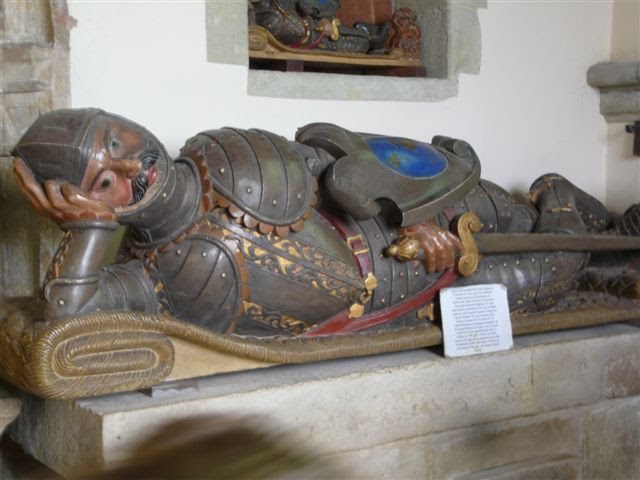
HADAS DIARY
Lectures are held at Avenue House, 17 East End Road, Finchley, N3 3QE, and start promptly at 8 pm, with coffee/tea and biscuits afterwards. Non-members: £1. Buses 82, 125, 143, 326 & 460 pass nearby and Finchley Central station (Northern Line), is a short walk away.
Tuesday 13th March 2012 – “It’s all in the Bones – St Bride’s crypt individuals” by Jelena Bekvalac (Curator of Human Osteology – Museum of London). The talk will be about the extraordinary assemblage of 227 individuals’ remains from the 18thand 19th century retained in the crypt of the church, which has kindly granted access and given permission for research. It will provide an insight into the lives and times of the people and some of the diseases/disorders observed in their skeletons, and how this informs us about them as individuals, and collectively about the time in which they lived – richly aided by documentary sources.
Tuesday 10th April 2012 -Conservation Techniques in Stone Masonry. Lecture by Stephen Critchley.
Tuesday 8th May 2012 -Bumps, Bombs and Birds: the history and archaeology of RSPB reserves. Lecture by Robin Standring (RSPB Reserves Archaeologist).
Tuesday 12th June 2012 -Annual General Meeting.
Sunday 26th -Thursday 30th August – Summer trip to Ironbridge
We still have a few places left for this trip. We will be based at the Best Western Valley Hotel, in the Severn Gorge. Although we will visit some of the museums in the immediate area, we have a number of other places to visit including Wroxeter Roman town, church and vineyard, Severn Valley railway, the RAF museum in Cosford and Shrewsbury – which has a large number of Tudor buildings.
Cost as last year is £390 per person in a double room or £450 in a single room. This includes bed, breakfast, packed lunches and evening meals, coach costs and the entry costs for visits. If you wish to join the group for this trip, please contact Jim or Jo Nelhams on 020 8449 7076.
Tuesday 9th October 2012 -The Life and Legacy of George Peabody. Lecture by Christine Wagg.
Tuesday 13th November 2012 – Tuesday 13th November 2012 – Archaeological Discoveries in Southwark. Lecture by Peter Moore (Pre-Construct Archaeology)
Sunday 2nd December 2012 – Following our enjoyable Christmas event at the end of last year, we have again booked Avenue House. The “party” will run from roughly 12:00 to 4:30. More details in due course.
THE MERCHANT TAYLORS’ GREAT FEAST OF 1607 Andrew Coulson
Report on the January lecture
A great feast. An annual event. The election of the Master and Wardens. An opportunity to demonstrate again that the Merchant Taylors are one of the twelve great Livery Companies of the Corporation of London. But this one was rather special.
Wool was the background of English Medieval prosperity and raw wool was exported to Europe. From 1480 the Merchant Taylors, or their predecessors, had gradually usurped the making of clothes from the continent and were doing very well. These distinguished and wealthy City gentlemen could fund the State and did. In the previous reign Queen Elizabeth the First had borrowed £50,000, much of it from the City. The Master of the Merchant Taylors had lent the Crown two tranches of £450 and £730 and the Company was, at that time, well able to lend the State £1000 per annum. And in return all manner of good things came their way. But the Queen died and James the First, frightened of assassination and the plague, spent some years before approaching the City in person.
The Merchant Taylors were one of the great twelve guilds and there were about a hundred lesser ones. Money could be borrowed from all of them. Further, even in their line of trade, they had competition -. the Clothworkers and the Mercers, for example. Inter-guild riots were common and bloodshed was normal. To invite the King to their annual feast ahead of anybody else would be a feather in their cap. But they had to move fast as the Lord Mayor, a Clothworker, had already invited the King to become a Clothworker. The date was June 27th. The invitation from the Master and Wardens was accepted on behalf of the King and of Henry Prince of Wales but the Queen, Ann of Denmark, declined to come. The traditional date for the great feast was the 16th of July. They had three weeks.
The first thing the Master and Wardens did was to advance their election to the 15th of July. This meant that the “ruling clique” which would meet the King would be in power for the next year. They then set about preparing.
The Company’s “New Hall” in Threadneedle Street was adequate accommodation and, despite being bombed during the war, was and is functional, and the medieval kitchens are in use to this day. The only structural change was caused by James I’s unwillingness to eat in public. He ate in a private room with a hole cut in the wall to provide a view of the top table where the Prince of Wales was presiding.
Furniture could be borrowed from the Merchant Taylors’ own resources, and from subsidiary or allied guilds; cutlery and china obtained through similar means and table linen was embroidered under the control of the Beadle’s wife who submitted a bill for £3-14s-4d. But catering staff presented a problem. In fact the Master, Sir John Swinnerton, and four Aldermen “borrowed” the Lord Mayor’s and the Sheriff’s staff of cooks, all thirty-two of them. Someone must have mentioned the need for “all pulling together for the good of the City”.
Provisions seem to have been made the subject of a similar “round robin”. Apparently everybody helped. Prince Henry sent six bucks; beef, mutton and pork arrived in the weights of 21, 41 and 79 stone; fish in proportion along with 17 swans, pheasants, turkeys, quails, peacocks, and 1300 hens eggs. A large portion of Westphalian ham and about 360 lbs of butter. And to eat it off there were 2880 trenchers. Records do not state what quantities of alcohol were provided but 24 chamber pots were available.
The dessert course consisted almost entirely of fruit enlivened by a rarity from the New World –
60 lbs of potatoes.
For entertainment the Master and Wardens had enlisted London’s theatrical community; John Rice, J.Hemmings and the Burbage Company at the Globe were all summoned to provide verses, instrumentals and singing. John Bull, a well known musician, was to accompany the King to his private room playing a tune which has been held to be a forerunner of the modern national anthem. Knowing the sycophantic habits of Stuart monarchy it could be true. As a structural addition the Master and Wardens had secured the pageant ship of 1602. This vessel, covered in light blue Watchet silk, and manned by three singers, was slung from the rafters of the Hall and the crew sang throughout the evening. One particular song was sung three times over to great applause. King James was, apparently, very impressed.
When any monarch wishes to enter the City, he has to be formally received at the gates by the Lord Mayor and then escorted to his destination. The Lord Mayor took his charge to the gates of the Merchant Taylors’ Hall and there had to hand him over to the Master and Wardens. Sadly he was not invited to the function despite having used the City Recorder to plead his case. He just had to wait outside until the King decided to leave.
The present capacity of the Hall is about 200 seated. The best estimate of the number of guests in 1607 is between 300 and 400. At least a quarter would be taken up with the King’s retinue. He had with him 21 Lords, 66 gentlemen – a sort of bodyguard – and three ambassadors and their retinues. Perhaps they were designed to be impressed by the economic might of the City and this part of it in particular. Certainly they discussed what sort of honours they might obtain when the Guild began handing out vellum rolls and packets of gold coin to the more distinguished guests.
The actual accounts of the occasion do not exist. All we have are bills, accounts of things borrowed, and letters. These bear witness to two facts: it was a most splendid occasion and the personality of the Prince of Wales made an indelible impression.
When the King and his retinue returned to Whitehall, the Master and Wardens counted the cost, arranged to return borrowed items, and set up a profit and loss account of influence gained and influence lost. The cost of the affair came to £1601; in modern terms about £100,000, and the present Clerk said, in his opinion they would need £1,000,000 to repeat the process. Apparently it took 100 staff 14 days to clear the Hall. It is not possible to account for influence gained or lost. An analysis of the Company’s fortunes in the near and distant future after mid-summer 1607 might help. But the fact is that the Merchant Taylors are still with us and are still part of the Great Twelve.
NEW INDUSTRIAL ARCHAEOLOGY HANDBOOK Stewart J. Wild
The CBA is about to publish a substantial new Industrial Archaeology Handbook:
http://www.britarch.ac.uk/books/palmer2012
Edited by Professor Marilyn Palmer, the UK’s first professor of Industrial Archaeology, with contributions from some of the country’s leading specialists in industrial archaeology, this Handbook provides an informative and accessible guide to the industrial remains of the UK.
This book will be essential reading for professionals, academics, students and anyone with an interest in our industrial heritage, giving concise summaries of the history of different industries, together with descriptions of the structures and below-ground remains likely to be encountered.
Info: 304pp, 121 illus incl colour, ISBN 978-1902771922 Due to be published March 2012.
WEMBLEY HISTORY SOCIETY 60TH ANNIVERSARY CELEBRATION
On Friday 16 March 2012, Wembley History Society will be holding its 60th Anniversary celebration meeting. It was hoped that this would take place in the Town Hall, but the Society’s committee has recently decided to stick with its familiar venue of St Andrew’s Church Hall, Kingsbury.
The programme, from 7pm to 10pm, will include short talks from several speakers, including local history author and former Brent Mayor, Len Snow, as well as refreshments and informal discussion.
Members of local history societies in the area, which may include others formed as a result of a 1951 conference, will be welcome to join the Wembley society’s own members if they wish to. If you do intend to come, please advise Linda Theobald by email to: linda.vt@hotmail.com in good time beforehand to help her plan the catering.
HADAS Finds Class Blog Stephen Brunning
Regular readers of this newsletter will no doubt know that HADAS took over the running of the old Post Excavation Analysis class from Birkbeck College in September 2009 and renamed it “Looking at Finds”.
If you wish to find out about what we get up to behind the scenes on Wednesday evenings at Avenue House, check out the new blog at www.hadasfindsgroup.blogspot.com.
Please feel free to register as a follower, and/or post any comments you wish.
“ARCHAEOLOGY EXPOSED” – LAARC AT THE MUSEUM OF LONDON
As part of the LAARC 10th Anniversary Celebrations, for 10 weeks the Museum of London is featuring “Archaeology Exposed” where they will be doing exactly what it says on the tin – exposing the different aspects of LAARC in all its glory, promoting the excellent work and achievements of its volunteers [some of whom are COLAS members] and sharing the enjoyment that we all get out of archaeology with any and all visitors.
A team of volunteers representing the past decade (and beyond) will be taking residence at MOL every Monday, Tuesday & Friday, until 23 Mar from 10 – 4. They’ll be packing material from 1975 General Post Office excavations (GPO75) whilst engaging with visitors in Archaeology Action.
Alongside them on Mondays there is a table focusing on Conservation, on Tuesdays a table displaying human remains and on Fridays a selection of archaeological records. All three will have material connected to GPO75; in particular, Friday’s Records table will be manned by none other than Alan Thompson, former LAARC Records Officer and the actual Site Director of the GPO75 excavations.
To promote the 4 remits of LAARC (Curatorial, Research, Education & Leadership) there will be a table in the foyer manned by staff and volunteers, with a range of goodies including finds, records, an activity box from 2005’s community excavation at Shoreditch Park, and online facilities for Londoners to search for archaeology in their area. There’ll even be a hard hat and tools if young ones (and those young at heart) wish to dress up.
Finally, each day from 3.15 – 4.15 (some days from 11.30 – 12.30 as well) there will be free Hands-On Archaeology sessions in the learning centre enabling ANY visitor to get involved, learning about London’s Archaeological Heritage and how to pack finds alongside volunteers.
Even if you can’t come along, LAARC would really appreciate it if you could spread the word and let others know what they’re doing. If your friends and family have ever wondered what exactly happens at LAARC this is the opportunity for them to find out. Full information about the project can be found at:
http://www.museumoflondon.org.uk/Corporate/Press-media/Press-releases/Celebrate+10+years+with+the+LAARC.htm.
You can follow progress via the blog: http://www.mymuseumoflondon.org.uk/blogs/blog/category/archaeology/archaeology-in-action/
And find our more about events on the MoL events pages: http://www.museumoflondon.org.uk/London-Wall/Whats-on/Events/eventDetails.htm?eventID=3292 and
http://www.museumoflondon.org.uk/London-Wall/Whats-on/Events/eventDetails.htm?eventID=3293
HADAS TRIP – WEDNESDAY 21 September 2011
Needles Breezer Bus Tour Vicki Baldwin
Following our voyage of discovery to Hurst Castle, our intrepid party embarked upon an excursion by land, namely a round-trip on the open-topped Needles Breezer. This is one of three Island Breezer circular routes linking places of interest and has a running commentary providing information on the route. Most of our party had boarded with the intention of visiting the Old and New Batteries at Needles Park, but Lydia and I had decided to make the 55 minute round-trip so that we could explore Yarmouth.
After leaving Yarmouth, we passed the site of the 1970 Isle of Wight festival where Jimi Hendrix played shortly before his death. It is an apparently empty green fields and I wonder what archaeological evidence survives. There are numerous contemporary accounts and a recent photographic exhibition in Bristol, but what is in the ground? Take away the documentation and what conclusions would be drawn about the site by future archaeologists? The report would probably include the words ‘ritual’, religious’, ‘seasonal campsite’, ‘feasting’.
Passing Afton Apple Park, we arrived at Freshwater Bay. This seems a rather quiet place with a hotel, a café and a lifeboat station, although it is home to one of the oldest churches on the island, All Saints, which was recorded in the Domesday Book. Nearby is Dimbola Lodge, once home to the pioneering photographer Julia Margaret Cameron and now a photographic museum. Originally it was two cottages, but Julia Margaret Cameron had a tower built to link them and had the frontage redesigned. One of her subjects, Alfred Lord Tennyson, lived further along the road at Farringford House which is now under-going renovations with a view to reopening as a Tennyson study centre and venue for concerts and poetry readings.
Another notable site is the thatched church dedicated to St. Agnes. Tennyson’s son Hallam donated the land and his wife, Audrey, suggested the dedication. It was consecrated in 1908.
The bus route continued to Needles Park and then to the site of the Needles Batteries. In places the view across Alum Bay is breathtaking, especially if you happen to look down and see the apparently sheer drop down the cliff! The famous multi-coloured sands are visible in the cliff face.
After returning to the Needles Park, the bus now followed an inland route and we could no longer see the sea and coastline. We next passed stops for Totland and Colwell Bay, two popular holiday resorts which are linked by a mile-long promenade. A short while later our journey was completed with our return to Yarmouth.
The Needles Old Battery David Bromley
The Island Breezer Bus is very appropriately named as we were heading for the Needles, the western-most point on the Island and today the windiest. On the way, we dropped two passengers at Dimbola Lodge. Needles Point Light was turned on in 1859 and became computer controlled in 1994.
Our first stop was the Needles Old Battery, sited on the triangular headland and reached over what was a tractable bridge across the defensive ditch, the mechanism for which can still be seen in the Winch Chamber. The ditch now houses a number of buildings that are not open to the public. One of these is the head of a lift shaft, sunk in 1887 and descending to just above sea level. It leads to five emplace-ments on the Solent side that housed searchlights and quick-firing guns to counter fast torpedo boats trying to enter the Western Solent. Also at the bottom is a spring and reservoir to supply some fresh water to the battery.
After the bridge is a tunnel through the outer defensive bank, which houses a number of rooms including the cartridge and shell stores and the guardroom. Through the tunnel the full extent of the fort is ahead: round a central parade ground the red brick structures of the six gun emplacements are sited, 76 meters (250ft) above sea level. Four-faced over the Solent on the northern side, one directly out over the Needles light and a sixth southwest. The latter was built over in 1940 to house the Admiralty Port War Signal Station and is now a warm tea and cake shop – most welcome on a windy day!
The fort was constructed between 1861 and 1863, following the Royal Commission on UK Defences in 1859. It was designed by the Royal Engineers and built by George Smith of Pimlico at a cost of £6,950. The original armament, installed in 1864, was six 7” guns with a range of three miles, but these were replaced in 1873 with 9” rifled muzzle-loaders. These guns were moved from Hurst Castle where they were no longer needed.
On the parade ground can be seen the foundations of the barracks accommodation for the complement of one officer, two NCOs and 21 men. Beneath this were two rainwater tanks holding 10,400 gallons, enough for one month. In the centre of the parade ground is a spiral staircase down to a brick-lined tunnel, built in 1885, which leads out to a point directly above the Needles – a definite photo opportunity. It was converted to an armoured searchlight position between 1898 and 1899.
By 1893 the need for new more powerful guns was apparent and as the chalk headland was too unstable, construction of the New Needles Battery was started. This is sited further inland and higher at 120m (390ft) above sea level. It comprised three emplacements and by 1904 housed three 9.2” breech-loading guns. Once the New Battery was operational the Old Battery was established as a Fire Command Post and the old 9” guns, weighing 12 tons each, were heaved over the cliff into Alum Bay. The Navy recovered four in the 1960s and two are displayed here on replica carriages in their barbets.
Both batteries played a part in both World Wars and were added to and changed a great deal. Both were mothballed at the end of the war and the guns were scrapped in 1954. In 1955
Saunders Roe leased the sites and the area was brought right up to the modern era with the construction of the Highdown Test Site. Here between 1957 and 1971 the Black Knight and Black Arrow rockets were static-tested. The two concrete sites where the rockets were anchored and test-fired out over the sea can be seen.
The whole site was closed in 1971 and the National Trust purchased it in 1975, opening the Old Battery to visitors in 1982 and the New Battery in 2004.
Following this excellent visit, it was time to board the Breezer Bus again and be blown back to Yarmouth.
HADAS TRIP – THURSDAY 22nd September 2011
Isle of Wight Jim Nelhams
Thursday was to cover a wide range of historical dates, including stone age, Roman, a church founded in the thirteenth century, a Norman castle, and then some industrial archaeology. Most of us visited the Isle of Wight Postal Museum, while Andy Simpson elected for what Flanders and Swan would describe as a “Transport of Delight”.
Brading Roman Villa Sheila Woodward
I first visited Brading in 1999 (with HADAS) and I had a vivid memory of its magnificence and its amazing mosaics, Perhaps it was inevitable that a second visit should produce some slight disappointment. The remains of the villa are now completely enclosed by an award winning Exhibition and Visitors’ Centre” – essential for preservation, but I found its design strangely obtrusive. It was sad to have to enter the villa from one side rather instead of via its own “front door” and the small souvenir guide on offer was a poor substitute for a proper up-to-date Guide Book, though producing one while excavation and re-interpretation continue could be problematic. Even the glorious mosaics at a second visit seemed slightly shabbier.
Successor to an Iron Age farm on the site, the first Roman Villa at Brading seems to have been a simple structure which was altered and expanded over the years as the farm prospered. By the mid 3rd century AD it had become a handsome 12-roomed courtyard villa, centre of a thriving farm and extensive trading complex, and home to a wealthy and educated family. But troubles soon followed in the form of pirate raids (the villa was then much closer to the sea), and a disastrous fire in the late 3rd century brought an end to prosperity. Even farming eventually petered out and all traces of the villa sank beneath undergrowth and soil.
The old (1998) guide book gives a dramatic account of its rediscovery in 1880. Captain Thorp, a retired army officer and keen antiquarian, recognised casual finds from the area as Roman and became to probe. He in turn enthused a local farmer, Mr Munro. One evening during the lambing season of Easter 1880, Munro was using an iron bar to make holes for an overnight sheep pen. “In the dimming light, he struck upon the mosaic …. and by 7 o’clock the following morning he and Captain Thorp had uncovered a small portion of the Bacchus pavement.” A charming drawing illustrates this event. Captain Thorp clasping a massively unsuitable (for archaeology) trowel kneels in a trench beside an uncovered portion of the Bacchus mosaic in pristine condition and immediately recognisable. Farmer Munro holds aloft a lantern and looks on admiringly, accompanied by his dog and a flock of rather bemused sheep! The amateur diggers were soon
supplemented by professionals. The local landowners, the Oglanders, gave practical and financial help (the villa is still administered by the Oglander Roman Trust, a registered charity) and by 1885, the excavation had been completed and published,
Of course, by modern standards it seems very inadequate: so much apparent misinterpretation, so much unintended damage and destruction. The site has remained vulnerable, wracked by wind, storm and tide, and severely flooded in 1994. Plough damage over the years was supplemented by the Dig for Victory campaign. Even some attempts at conservation have miscarried: a flood-damaged mosaic floor was relaid on a modern non-organic concrete base which caused efflorescence and further damage to the mosaics.
All is not doom and gloom. Now (we hope) adequately insulated from the weather, excavation of the site has been resumed under the direction of Professor Barry Cunliffe, and re-interpretation of the Victorian dig is underway. Preliminary results are described as exciting and challenging. A huge aisled hall in the villa’s north wing continues to be studied. It probably pre-dates the main house, has a substantial hypocaust and a bath suite was built over a disused well.
Continuity/coincidence between Iron Age and Roman settlement is being exposed. An Iron Age ditch has been identified and it appears to overlie pits which could have been Bronze Age or even earlier. The south wing of the villa, excavated and re-buried in the 1880s, could be re-excavated: its outline is still traceable on the ground. As well as storehouses and stables, it is though to contain the main bath suite.
The twelve main rooms of the villa are all accessible. They (probably) differ slightly in date, considerably in degree of preservation and noticeably in quality of decoration. The function of each room is purely speculative. The most memorable feature of the building remains its mosaics: memorable for their craftsmanship, their variety and their vigour. Those in room 12, largest and grandest of the rooms, are said to be amongst the most impressive in Northern Europe, Some of the themes are popular with mosaicists – e.g. the Four Seasons. Here there are lovely depictions of Spring, her head wreathed in fresh flowers. Summer with long-stemmed poppies in her hair, and Winter, snug in a warm hood but carrying a dead bird. Autumn’s depiction has sadly been lost. Less well known as a theme (in this country) is the astronomer or philosopher equipped with sundial, globe and bowl. In room 3, the Bacchus Mosaic uncovered so dramatically by Captain Thorp shows a much debated cock-headed figure variously interpreted as an obscure Roman or Eastern God or a venator, trainer of gladiators. A gladiator is depicted on the same mosaic. Another popular subject for mosaics is Orpheus, shown here surrounded by the birds and animals he has charmed with his music; they include a monkey. And other mosaics feature water-nymphs and shepherds, so appropriate for a seaside farming community.
There is much to see at Brading Villa apart from the mosaics. The finds on display are many and varied. Huge quern stones, carpentry tools, ploughs, mortaria, loom weights, crucibles and glass slag witness to a busy workforce. Pottery includes some good Samian, local Victis and New Forest ware. There is good metalwork ranging from doorplates and keys to jewellery and the usual collection of coinage. Outside the villa there are glorious views in all directions and you can peer down the old well or wander round the little garden. There is no evidence of a garden here in Roman times but the Romans liked gardens, and it adds another visitor attraction – and neatly rounds off the tour.
Brading Church Simon Williams
Brading Church is important, as it’s one of only four churches in England with a tower open on three sides (pierced by arches); external wooden steps lead to the bell chamber (one inscribed 1594 ER). It also has some of the finest family tombs and monuments on the Island – these are of the Oglander Family.
The Church occupies a very early Christian site, it is said (though without proof) that in the 680’s St.Wilfrid embarked on a mission to convert the heathen Islanders from here. It is known that Wilfrid was Bishop of Ripon (from 634-709); and that he was at the Council of Whitby in 664 (which settled the date of Easter, as in use today).
The Oglander Chapel is named after the Oglander Family, who came to the Island in the wake of William the Conqueror. Sir John’s will (dated 1649) provided for tombs for his father, Sir William, as well as for himself.
There are two Parish Chests of the 1630’s, which have three locks, so that they could only be opened in the presence of the three key-holders: the Vicar and the two churchwardens, to reduce the chance of theft.
Along the north aisle are a fine set of hatchments (large black diamond-shaped wooden boards displaying heraldic coats of arms), these were restored after the fire of 1989. On the back wall of the north aisle, a window is the only remnant of the late 1100’s church. The north aisle was widened and the roof raised to its present position in the 1200’s. The simple windows of the north aisle were likely to have been replaced in the 1400’s. From the south aisle one sees that the roof is higher, and the windows are larger and more ornate. The south aisle was improved in the 1500’s. All the beautiful stained glass is from the 1887 Victorian restoration.
On entering Brading Church we were lucky enough to be greeted with the sweet smell of apples, and freshly-cut flowers for the Harvest Festival.
OTHER SOCIETIES’ EVENTS ERIC MORGAN
Friday 2nd March 10.30 am – 12 noon, Friends of Barnet Borough Libraries, South Friern Library, Colney Hatch Lane, N10 The Story of English High Roads – talk by Ollie Natelson (who helped HADAS with resistivity at Friary Park).
Saturday 3rd March 11 am – 12.30pm and 2.-3.30 pm. LAARC, Mortimer Wheeler House, 46 Eagle Wharf Road, N1 7ED John Dwight’s Fulham Pottery. Part of the regular tours held every Friday and first and third Saturdays each month at above times. Book in advance on 020 7001 9844 or on www.museumoflondon.org.uk/events , cost £5.
Monday 5th March 1pm. Gresham College at Museum of London, 150 London Wall EC2Y 5HN. The Lost Hospitals of London: Leprosaria, talk by Prof. Carole Radcliffe (Medieval History). Free.
Wednesday 7th March, 6pm Gresham College at MoLAS Museum of London (as 5th March). On Top of the World, 1830-1914, talk by Simon Thurley. Free. (On English Building).
Monday 12th March, 1pm Gresham College at Museum of London, (as 5th March). London’s Forgotten Children: Thomas Coram and the Foundling Hospital, talk by Dame Gillian Pugh.
Monday 12th March 3pm Barnet & District Local History Society, Church House, Wood Street, Barnet (opposite the Museum) The Story of the Bow House, talk by Pauline Brown.
Wednesday 14th March 2.30-4pm Mill Hill Historical Society, Wilberforce Centre, St Paul’s Church, The Ridgeway, NW7 1QU An Eyeful of Architecture, National Trust, talk by Mike Watts (preceded by AGM).
Monday 19th March, 1pm, Gresham College at the Museum of London (as 5th March) The Lost Hospitals of London: The Bethlem Hospital, talk by Colin S. Gale (Archivist). Free.
Monday 26th March 1pm, Gresham College at the Museum of London (as 5th March) The Lost Hospitals of London: St. Luke’s. Talk by Prof. Nick Black. Free.
Wednesday 28th March, 1-2 pm, Museum of London, London Wall, EC2Y 5HN. Meet the Expert, with Jackie Kelly. Looking at Leatherwear. Free. Talk on Roman and Medieval leather objects in the Museum by the Curator.
Also 1.30-4.30 pm Local History Workshop on Getting the Best from the 1911 Census. Details on LAMAS website www.lamas.co.uk and applications by e-mail on www.museumoflondon.org.uk.
Wednesday 28th March, 7.45 pm Friern Barnet & District Local History Society, St John’s Church Hall (next toWhetstone Police Station) Friern Barnet Lane, N20. History of Gypsies in Barnet, talk by Hugh Petrie (Barnet Archivist). Cost £2. Refreshments 7.45 and after meeting.
Thursday 29th March, 8pm Finchley Society, Drawing Room, Avenue House, East End Road, N3 3QE Business Talk and Discussion by Albert Wright (Director of Small Business Solutions and Millionaire Coaching Academy). There will be tea, coffee and a cash bar, members free. Non-members £10. Pre-book preferred.
Friday 30th March 10.30 am-12 noon, Friends of Barnet Libraries, South Friern Library, Colney Hatch Lane, N10 The Story of Friern Barnet Town Hall, talk with coffee/tea and biscuits 50p

Number 491 February 2012 Edited by Andy Simpson
HADAS DIARY
Lectures are held at Avenue House, 17 East End Road, Finchley, N3 3QE, and start promptly at 8 pm, with coffee/tea and biscuits afterwards. Non-members: £1. Buses 82, 125, 143, 326 & 460 pass nearby and Finchley Central station (Northern Line), is a short walk away.
Tuesday 21st February 2012 (please note change of date from the usual format;
the February lecture is on the THIRD Tuesday to avoid clashing with a Valentine’s Day event at Avenue House)
The Medieval Cellars of Winchelsea. Lecture by Richard Comotto.
Richard Comotto of the Winchelsea Archaeological Society will be speaking about the historic Cinque Port town of Winchelsea and its medieval cellars. Winchelsea in fact has more medieval cellars than anywhere else in the country other than perhaps Southampton and Norwich. They are a remnant of the town’s involvement in the wine trade with Gascony before the Hundred Years War. Winchelsea also uniquely retains the layout of the medieval planned town founded in 1288 by Edward I.
Richard will be talking about the origins of Winchelsea, its medieval history, including the wine trade, and the archaeology of the town. The Winchelsea Archaeological Society was set up to do geophysical research in and around the town. Despite its historical significance, surprisingly little archaeology has been done on the medieval town and none on the port.
Tuesday 13th March 2012 – It’s all in the bones. Lecture by Jelena Bekvalac (Curator of Human Osteology – Museum of London).
Tuesday 10th April 2012 – Conservation Techniques in Stone Masonry. Lecture by Stephen Critchley.
Tuesday 8th May 2012 – Bumps, Bombs and Birds: the history and archaeology of RSPB reserves.
Lecture by Robin Standring (RSPB Reserves Archaeologist).
Tuesday 12th June 2012 – Annual General Meeting.
Tuesday 9th October 2012 – The Life and Legacy of George Peabody. Lecture by Christine Wagg.
Tuesday 13th November 2012 – Tuesday 13th November 2012 – Archaeological Discoveries
in Southwark. Lecture by Peter Moore (Pre-Construct Archaeology)
Errata and Mea Culpa Mary Rawitzer
The Editor of your last Newsletter must apologise for ennobling Dr Ann Saunders, the January Lecturer, to Dame, though she should surely be, if it were in my gift. And I inadvertently left Jo Nelhams off the contributor’s list for her great summary of Nathalie Cohen’s November talk on The Thames Discovery Programme.
A couple of notes via Stewart Wild;
For those of you who are interested in geophysics “Revealing The Buried Past” by Chris Gaffney and John Gater. These two gentlemen are often seen on Time Team with a bewildering array of technical kit. This book explains the different types of equipment available to the archaeologist, how it works and the sort of results that can be expected. Available from Amazon for £12.59
New discoveries in the cave at Hohle Fels (cave paintings in Germany).
http://www.pasthorizonspr.com/index.php/archives/11/2011/archaeologists-find -ice-age-painting-in-central-europe and http://www.thelocal.de/sci-tech/20111109-38751.html
BETTER LATE THAN NEVER – POST-EXCAVATION NOTES AND REPORT FOR THE WHITE SWAN SITE, GOLDERS GREEN ROAD.
Andy Simpson
The Sunday morning gang at Avenue House are, even now, making surprise discoveries amongst the Ted Sammes archive. Back in October 2011 we were delighted to come across finds material for one of several HADAS digs from along Golders Green Road. The White Swan pub site at 239-241 Golders Green Road, Hendon was situated on the western side of Golders Green Road, a quarter of a mile south-east of the junction with the North Circular Road and just north of Highfield Avenue; the pub still has a ‘mounting stone’ just outside it adjacent to the now-heavily trimmed large tree on the forecourt visible in Edwardian photographs, and this was shown on the 1954 OS Map, along with a milestone formerly showing six miles from London. Eighteenth century maps show the line of the originally medieval Hampstead Road, now Golders Green Road, established on its present NW-SE line in the nineteenth century, as a wide strip of land or unmetalled track passing through the original undeveloped manorial wastes of Hendon Manor.
Apart from a small originally medieval Hamlet in the Temple Fortune area (shown on John Roques map of 1756), before the coming of the tube railway in 1907, almost the only development at Golders Green was a ribbon of a few eighteenth century cottages and eighteenth and early nineteenth century villas and smallholdings in spacious grounds strung out along the Golders Green Road, such as South Lodge standing almost opposite the White Swan. The shops of Russell Parade latterly lay directly opposite; the present day White Swan pub, serving Hungarian food (and two hand-pumps dispensing London Pride!), and with a large and pleasant rear garden, is still extant immediately adjacent to the location of the actual excavation, at 243 Golders Green Road. Behind its modified frontage erected 1913-14 is Golders Green’s only surviving eighteenth century building, with later renovations. The Field Book for the Cook map of 1796 lists Mr Jereboam Clark as occupant of the ‘Swan public house, with stable, yard, and garden; a piece of ground in front, not enclosed, and a large tree by the six mile stone’
For present-day photo of the pub frontage and list of past licensees from 1826, see
http://deadpubs.co.uk/Middlesex/Hendon/WhiteSwan.shtml
On the opposite side of the Inn (once a Bass Ales establishment, and once called plain ‘The Swan’) on a site now occupied by a block of flats once stood the mid-19th century Highfield, originally a girl’s school, and later the HQ of the Worker’s Union, demolished in 1931 along with the weatherboarded two-story Grove Farm Dairy which stood between it and the pub.
This stretch of road has been well covered by HADAS excavations, with medieval material found at the Woodlands dig (TQ 2410 8850) in 1968 and 1975/76, as described below, and also 700ft/213m north of the White Swan at the Old Forge site on the opposite side of the road at 296 Golders Green Road (TQ 2414 8837) in 1991, where medieval pottery and a possible continuation of the road feature found at Woodlands was located. This was the site of Suckling’s Forge, destroyed by a V2 rocket in January 1945, and of the later Suckling’s Garage. This site, along with that of the adjacent Edwardian rebuilt Prince Albert Inn (latterly a Harvester Inn) demolished c.1993, still lies empty and awaiting redevelopment.
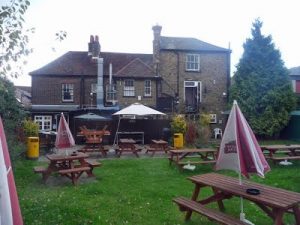 (Below) Rear of White Swan, November 2011, with oldest section on right.
(Below) Rear of White Swan, November 2011, with oldest section on right.
The Excavation
This excavation, immediately adjacent to the White Swan pub itself on its southern side, was reported in HADAS Newsletters 63 (p.1) and 64 (p.4), May/June 1976. The excavation (NGR TQ 2420 8830, Barnet SMR ref 081976) began on the weekend of 10th/11th April 1976, and continued until 23 May 1976, being directed by Jeremy Clynes, assisted by Percy Reboul and others.
Located on the site of a fairly large (1890s or Edwardian) weatherboarded two-story building at No.241 (originally a house, with single-story shop of similar construction and steeply pitched roof at No. 239 jutting out from the front of the main house) demolished a few years previously, (again shown on the 1954 OS Map). Weatherboarding was common locally – also seen in the former Clerk’s House in Church Terrace, Hendon for instance.
At one time the shop was occupied by S.J. Lester, Boot Maker and Repairer. In 2011 the site of 239-241 was occupied by a shop and new development of flats on the actual corner of the site with Highfield Avenue.
Three trenches were opened prior to redevelopment work.
The dig was described as being ‘disappointing’ in HADAS NL 64, with no evidence of occupation, either features or structures, or of either the Roman road sought (Viatores Route 167, previously possibly located at Copthall Fields, Mill Hill) or the pebble-metalled medieval road or embankment and associated Hertfordshire greywares (adding to previously found Surrey and West Kent Wares of 14th-15th century date) found by HADAS at No. 1 Woodlands a quarter of a mile to the north at the junction with the north Circular Road in 1968 and again by Alex Jeakins’ HADAS team in 1975-76, and also reported in HADAS Newsletter No. 63 along with the White Swan excavation. (The Woodlands 1975/6 site archive and finds are still held in the HADAS archive, and may repay further study with the advances in pottery studies over the past 30 years)
No site maps or context records etc. appear to survive, although there is a folder with a few map extracts in covering the immediate area. The three trenches were dug down to natural, with the only recorded finds being from the topsoil – broken glass (mostly beer bottles), pipe stems and what was thought at the time to be nineteenth/twentieth century pottery.
Four site photographs on HADAS record cards (including that reproduced below- Jeremy Clynes on left, Percy Reboul on right) show a shallow trench being dug right alongside the pavement on the line of the former building frontage, which lay closer to the road than the adjacent pub which was set back from the road. The previously levelled site itself was long and covered the whole of the former building plot.
The surviving finds are mainly unremarkable and much what you would expect from the environs of a site going back to the eighteenth century; they now include only two fragments of glass, one green vessel fragment and one of clear, thin window glass; There is also a small sherd of modern glazed earthenware, plus a tiny (13 grammes) fragment of micacious tile and a probable sheep’s tooth. However, closer examination of the pottery and clay pipe fragments in particular have provided one or two surprises.
The main finds. From left; Early Surrey Ware, Red Borderware, Tin-Glazed Ware Orton and Pearce style H (TGW H), German and English stonewares, and clay pipes (clockwise from top left; Types AO20; AO21; AO27 (two), AO18 and AO19)

The main finds. From left; Early Surrey Ware, Red Borderware, Tin-Glazed Ware Orton and Pearce style H (TGW H), German and English stonewares, and clay pipes (clockwise from top left; Types AO20; AO21; AO27 (two), AO18 and AO19)
The Pottery
Somehow overlooked at the time was the fact that one pottery sherd is most emphatically medieval; it is a rim sherd (38g) of hand made Early Surrey Ware (ESUR, c. 1050 – 1150) probably from the Surrey/Hampshire border, kindly confirmed by Jacqui Pearce as being from a large cooking pot (Form code CP) One sherd of residual ‘background’ medieval pottery does not of course a settlement make, and it could have originated from manuring of fields or similar.
Also present is a flower-patterned rim sherd of eighteenth English Tin-Glazed earthenware with pale blue glaze and dark blue decoration (TGW H) (otherwise known as Delftware) probably from a bowl or plate, with a broad date range of 1680-1800, plus a small body sherd from a second vessel of the same fabric, and another rather battered rim sherd (13g), this time of very-large diameter Surrey-Hampshire border redware (RBOR) with a rather wide date range of c.1550 to 1900.
Stonewares are represented by four sherds (of two or three separate vessels, two of them co-joining and including a handle base) of English Stoneware (ENGS) of c.1700-1900 and a single sherd of German stoneware, possibly a tankard-hardly surprising given the location adjacent to a pub.
The Clay Pipes
In addition to forty fragments of stem and five unidentifiable broken pieces of bowl, ( but no mouthpieces) the three fairly complete identifiable clay pipe bowls, along with three more consisting of stem and heel/spur but very little bowl, give an approximate date range of 1660- 1820, of Atkinson and Oswald types AO18 (1660-1680), AO19 (1690 – 1710), AO20 (1680 – 1710), AO21 (1680-1710) and AO27 (1780-1820), one of the two examples of the latter having the makers initials ‘PC’ on its heel.
Three other examples with this mark (as yet to be identified) were found on the HADAS Church Terrace excavation in 1973/74 (report forthcoming). This is the only pipe fragment with an identifiable maker’s mark, though a second AO27 type could be read as IE (or F) on the spur, the I being more certain than the E/F.
The close grouping of dates perhaps a little before or after 1700 is of interest, and could be contemporary with the Tin-Glazed ware sherds mentioned above.
I am grateful to Jacqui Pearce for checking the pipes for me.
In conclusion, it is clear that even the smallest finds group can contain some interesting material and a surprise or two. I hope to make similar studies of some other small finds groups from 1970s HADAS digs and watching briefs in due course, starting with the Fuller St excavation off Church Lane in Hendon in late 1974, which also has a sherd of previously unreported residual medieval pottery.
Bibliography
Barnet Libraries Archives and Local studies Department Bygone Hendon
Howkins, F c.1923 The Story of Golders Green and its Remarkable Development
Jeakins, A 1976 The Woodlands Dig HADAS Newsletter 63 May 1976
Petrie, H 2005 Hendon & Golders Green Past
Simpson, A 1991 A HADAS dig at Golders Green HADAS Newsletter 247, Oct 1991
Smith, C (Ed) n.d Hendon As It Was Vol. Two
Smith, C.R and Hall, J.P (Comps) 1979 The story of Golders Green
Smith C n.d Golders Green As It Was
Isle of Wight (Day 2) Jim Nelhams
For most people, no visit to the Island would be complete without exploring Osborne House and its grounds. After visiting the Glass Works and our ride on the railway (see December 2011), to find our coach waiting for us, we made our way to St Mildred’s Church, en route for Osborne House.
St Mildred’s Church, Whippingham. Micky Watkins
Prince Albert designed this church and it is an eclectic mix of Romanesque and Gothic that only a Victorian could design, or fully appreciate. The solid square tower with Romanesque arches has a thin Gothic central spire and four small spires, one at each corner. This strange mixture of styles continues throughout.
Victoria used to enter the church through a special doorway leading into the Royal Pew. Here, sheltered from the congregation she sat on a royal blue chair, her retinue around her. Edward VII ordered pews to be fitted, but kept his mother’s chair. One wall has a large plaque which is a memorial to Prince Albert.
Opposite the Royal Pew, in the South Transept, is the Battenburg Chapel, with a huge marble sarcophagus containing the bodies of Prince Henry of Battenburg and his wife Beatrice, Queen Victoria’s longest surviving daughter. The family changed the name to Mountbatten in 1917 owing to the widespread anti Bosch feelings during the war. The bronze statue in the Chapel was made by Princess Louise, who also designed the font; the tapestry carpet and stools were made by Princess Beatrice and other court ladies and the small lace hassock was made by Queen Victoria. Other members of the Mountbatten family are commemorated, but Lord Mountbatten, who was killed by an IRA bomb, was buried at Romsey Abbey near Broadlands. On the south wall of the Chapel is a crucifix in memory of Tsar Nicholas of Russia and his wife, Alexandra, granddaughter of Queen Victoria, and their five children who were all shot in 1918 in the Russian Revolution.
I found that the most beautiful feature of the church was the white marble reredos representing the Last Supper, a gift from Edward VII and other members of the Royal family in memory of Queen Victoria.
The original church was Anglo-Saxon, but the only remaining feature is the carving in the west wall of the porch. It was replaced by a Norman church which lasted until 1804 when it was demolished and rebuilt by John Nash. So the Nash church only lasted 50 years until Prince Albert pulled it down and erected his new church. What would St Mildred think of all these changes? She was a grand-daughter of King Aethelbert and an abbess of Minster-in-Thanet and might be disappointed to find so much about these new royals and so little about herself in her church.
OSBORNE HOUSE Tessa Smith
I have spent many happy holidays as a child with bucket and spade on the Isle of Wight but none at so splendid a seaside home as that at which Queen Victoria spent hers with her husband Prince Albert and their large family.
I arrived at Osborne House entrance by horse and trap driven by two smart bowler-hatted young grooms, via the short Ridgeway Carriage. The drive was edged with myrtle, laurel and dolphin-topped gas lamps – a fine flourish to the start of my visit.
Built in 1846 by William Cubitt, the house was designed in Italianate style by Prince Albert in conjunction with the builder; Albert chose this spot as the view reminded him of the Bay of Naples. The central block, (the Pavilion) houses the family’s private apartments, the whole building is built of brick rendered with cement, coloured to imitate warm Bath stone. Above the Grand Corridor wing the arcade of Venetian windows is light and airy.
The Long Corridor houses classical sculpture and sea paintings, “Naval Review at Spithead” and “Shipwreck of the Eurydice at Sandown Bay 1878” and leads to the main house. The Council Room is elaborately decorated with heavily embossed gold-coloured ceiling and it was in this room that the Privy Council ministers met. It was also used for dancing, charades and visiting entertainers, Dame Nellie Melba, Dame Clara Butt, Henry Irvine and Ellen Terry all performed there. Alexander Graham Bell demonstrated his telephone in this room and it was later installed here.
I had hardly begun to explore downstairs when I was offered the lift to the first floor by the friendly and helpful staff. My thoughts went to the elderly Queen Victoria who in her latter days had a lift installed. It was hand operated by an attendant in the basement who responded to a bell, it must have been quite a squash with crinolines, bustles and even Queen Victoria’s “Rolling seat”.
The first floor was the main family living area, housing bedrooms, dressing – and writing- rooms, (his and hers), all with splendid views over the terraces towards the sea.
Prince Albert’s bathroom has a plumbed-in copper bathtub – very, very deep with a heavy lid-a bit scary-and a shower and WC hidden as a wardrobe, Albert was keen to include up-to-date plumbing, heating and lighting. His dressing and writing room held his favourite early Renaissance paintings, a washstand and writing table. This room leads directly in to Queen Victoria’s large sitting room, which has marvellous views, here she and Albert shared a double mahogany desk where they worked on the dispatch boxes, the Queen wrote her journal, Albert sorted his photographic records, or they played the piano. The two elder children often took their supper here. The Queen’s bedroom seemed to me rather sombre with sad and mournful paintings. Beside the bed stands a little cushioned stool, and nearby a wardrobe with full-length mirror opened to reveal a bath, shower and W.C. She died in this room in January 1901.
On the first floor landing is the Page’s Alcove where a page of the back stairs was always in attendance, and a collection of mementos belonging to the aptly named George Waite, page to the Queen for more than 50 years, is on show.
Huffing and puffing after climbing 27 stairs to the nursery I caught up with other HADAS members admiring the nursery furniture, the table with chairs individually named (no squabbling), the royal cradles, and Noah’s ark. The children stayed in the nursery suite until they were 6 years old. A display of marble sculptures of baby hands and feet seems ghostly and macabre and very Victorian. On the walls are framed photographs that show how the present royal families of Europe are descended from Victoria and Albert’s 9 children.
The main staircase has a wonderful sweeping mahogany banister – how tempting to all those children.
A small, rather gloomy and uncomfortable-looking room – the horn room –contains furniture made from stag’s antlers; even the candelabra, pictures, and chairs are framed with antlers. On the wall hangs the famous painting by Landseer –“Sorrow” – showing the widowed Queen seated on her pony reading a dispatch. John Brown is standing close by in attendance with head bowed. This fuelled speculation and gossip about their relationship.
In contrast to the horn room, the dining room, drawing room and billiard room, are gloriously golden and richly decorated with elaborate ceilings and doors opening onto the terraces. The dining room table was set for a festive Christmas and huge paintings of family groups hang on the walls giving the impression that the room is alive with family. The drawing room is most opulent with huge mirrors and chandeliers, the piano is decorated with porcelain plaques painted as Old Italian masters, here Victoria and Albert played duets together. It was also in this room that Queen Victoria lay in state after her death.
Finally, the unexpected magnificence of the Durbar room, a high, light and atmospheric hall with mysterious music and aroma. The wonderful coffered ceiling is highly decorated with carvings and plasterwork, and the hugely ornate peacock chimneypiece sets the background to a display commemorating Queen Victoria’s golden and diamond jubilees. Address caskets containing loyal greetings are set in exquisite models coated in silver, of palaces, cannons and elephants, wonderful examples of Indian craftsmanship.
Following her death, the house was given to the state, and in 1903 part of the estate became a junior officer training college. During World War 1 it was used as an officers’ convalescent home. Now it is partly opened to the public and stage managed by English Heritage.
The Swiss Cottage, Osborne House, Isle of Wight Vicki Baldwin
The foundation stone of the Swiss Cottage was laid by the children of Queen Victoria and Prince Albert in 1853 in the grounds of Osborne House. In appearance the grandest play house imaginable, it was intended by Prince Albert to be the locus of the children’s practical education.
Here they learnt to grow food in the vegetable garden, cook and prepare meals in the kitchen, and entertain their parents in the dining room. Queen Victoria had a small writing desk in the dining room where she was able to continue working when visiting.
All the furnishings in the Swiss Cottage are scaled to suit children and the garden tools were marked with the owner’s rank and initials. A miniature shop: “Spratt, Grocer to Her Majesty”, complete in every detail, is one of the many fascinating objects on display.
Nearby is the miniature Victoria Fort and accompanying Albert Barracks, with earthworks, redoubts and buildings that the children helped to construct as a birthday surprise for Queen Victoria.
The children were also encouraged to build natural history collections which soon outgrew the space available in the Swiss Cottage. A museum was built to house the collections in 1862 and has the original cases built for the specimens although the contents were rearranged in 1916. Mementos from foreign visits were added to the museum.
In spite of the changes necessary to enable the public to visit, the Swiss Cottage somehow manages to retain the impression of its original owners, and it is not difficult to imagine them intent upon their various tasks and duties as they learnt about the running of an ‘ordinary’ household.
Isle of Wight – Wednesday Jim Nelhams
Wednesday was always going to be our riskiest day. Two boat crossings of the Solent in a small ferryboat. Hurst Castle with little shelter, and on our return to the island, an open top bus trip to the Needles Batteries. The only other way to get to the batteries is a mile long walk from Alum Bay. And when we awoke, it was raining.
The Needles is not the flattest part of the island, but the bus trip was a circular route, with commentary. The choices this allowed meant that while most people opted to visit the batteries. some stayed in Yarmouth, some stayed on the bus for the whole round trip back to Yarmouth, while Ken Carter and Micky Watkins stopped at Dimbola Lodge. Ken Carter’s note on Dimbola Lodge was published in the January newsletter..
Fortunately everybody made it back to Yarmouth to find our Galleon.
Hurst Castle Beverley Perkins
As we drove west from Sandown through an increasingly hilly landscape, the remnants of the previous night’s rain cleared and blue skies welcomed us to Yarmouth. There we boarded a specially chartered boat to cross the ¾ mile of water that separates the Isle of Wight from the tip of the narrow shingle spit on which Hurst Castle is built – the narrowest point of the Solent.
The low castle with its huge Victorian wing extensions looks impressively defensive, looming threateningly over the Solent. The Tudor castle at its core, constructed between 1540 and 1544, was one of a chain of fortresses built by Henry VIII to defend the vulnerable South coast from the feared Spanish or French invasion.
A display in the tower shows how the designs of Henrician castles varied according to the defensive needs of their sites, ranging from simple circular shapes to towers with up to six bastions. Hurst Castle was built as a 12-sided central tower encircled by a courtyard and a curtain wall, with three semi-circular gun bastions to the North East, North West and South so that it could withstand assaults from both land and sea.
Circular holes on either side of the gateway show that it originally had a drawbridge spanning a moat. Inside the gateway are slots for the portcullis. When completed, the castle had 71 gun positions in six tiers, though it is unlikely that it was ever equipped with so many weapons.
The ground and first floors of the 12-sided, two-storey tower were probably the living quarters of the garrison. The first floor had a defensive function, as its windows were above the level of the curtain wall so that small guns could be fired through them. Three doors in the first floor, now blocked, led to timber bridges across to the bastions. A cupboard off the staircase to the roof contained boxes of ammunition within easy reach of the gun crews. The roof offers splendid views over the south coast, the Solent and the Isle of Wight, including Fort Albert opposite, built in the 1850s, which has been partially converted to a block of very expensive flats.
The North West bastion, which covered the landward side and the gateway, was the most solidly built. The ground floor room had four gun embrasures, though one of these is now covered by the 1860s wing and the others have been narrowed. One still has its Tudor smoke vent which let out the clouds of noxious smoke produced by the guns. A doorway in the first floor leads to the portcullis chamber over the main gateway where the portcullis, weights and chains can still be seen. At the bottom of the steps to the basement is the entrance to a caponier – one of three built in 1852, it is a low, barrel-vaulted building protruding out to the north east with rifle slots on both sides covering the approaches to the castle. According to Wikipedia, the name ‘caponier’ originates – somewhat inappropriately – from the French for chicken-house!
The North curtain wall contains a chamber with a cartridge hoist. The circular vaulted basement is lined with recesses for stacking powder barrels. Lamp chambers in the central brick pier allowed the magazine to be lit without taking lamps directly into it. The North East and South bastions followed a similar pattern but have been partially masked by the 1860s wings.
Even after the threat of invasion had passed, the castle continued to be garrisoned. During the Civil War it was occupied by Parliamentary forces and Charles I was briefly imprisoned there in December 1648 on his way from Carisbrooke Castle to his trial in London. In the 1700s it became a jail for Popish prisoners. By 1793, when Britain went to war with France, it had become very dilapidated. It was repaired and equipped with eighteen 9-pdr guns. In 1803 more substantial repairs were made, the interior of the tower was gutted and a strong brick vault was inserted to support six 24-pdr guns on the roof. The basement was also vaulted and strengthened to protect the magazine. Doorways and windows were altered and the central spiral staircase linking the floors and the basement was replaced by a massive central brick pier. The remains of fireplaces several feet above the current floor level show that floor levels too were changed. However, the castle was not after all needed for defence and in 1809 became a hospital for soldiers wounded in Spain. Further strengthening was undertaken in the 1850s and new batteries were added.
By the start of the 1860s England once again feared invasion and the existing batteries were considered inadequate to protect the approaches to Southampton and Portsmouth Dockyard. They were therefore replaced by the massive East and West wing batteries, built out from the sides of the North East and North West bastions. These wings held a total of 30 guns of varying calibres. So many guns were needed because the casemates limited the angle of fire and the new steam warships moved faster than the old sailing vessels.
Each gun was protected by a massive granite-fronted casemate lined inside with a thick wrought iron shield. Two 12.5-inch 38-ton guns, salvaged from the sea below the Needles Old Battery, are on display in two of the alcoves. They fired shells weighing 820 lbs. with a range of 3½ miles. Twelve men were needed to load and move each gun. Woven rope mantles, hung in front of the metal shields, acted as flash screens, absorbing the metal splinters in case of a direct hit. The rear of the casemates provided accommodation for the garrison. Hoists raised the shells from the basement to the level of the guns through openings of various shapes and sizes.
Further guns were added to Hurst’s defence in 1893 and again during the First World War, when two Defence Electric Searchlights were also installed to light up the Needles passage. During the Second World War the castle was garrisoned by the 129 Coastal Battery Royal Artillery. One casemate became the garrison theatre, which still has its painted backdrop of a charming Restoration scene – apparently the only wartime backdrop which survives. How nice to know that during those dark days the garrison was allowed the relief of some light entertainment.
At the end of this fascinating visit we re-embarked, enjoying splendid views of the Solent and the coast as we sailed back to Yarmouth.
LONDON ARCHAEOLOGICAL ARCHIVE AND RESEARCH CENTRE
IDENTIFYING AND RECORDING CLAY TOBACCO PIPES
Tutor: Jacqui Pearce, BA FSA MIFA Saturday 17 March 2012 or Saturday 21 April 2012
The LAARC holds thousands of clay tobacco pipes, representing dozens of London makers and enabling us to trace the evolution of this commonplace artefact from before 1600 until after 1850. We are currently creating a new reference collection, initially comprising over 500 individual pipes, which will be completed in March 2012 and used for the first time during these two study days.
There will be a strong emphasis on practical activities, handling and studying the original artefacts, and so we are restricting the number of participants on each day to just 12. The sessions will include:
• Introduction and overview of tobacco pipes in London, c. 1600-1850
• Makers and makers’ marks
• Decorated pipes
• Archaeological assemblages: pipes in association with other artefacts
• Recording pipes individually and in groups
Course cost: £60, including: All tutorial expenses and access to on-line resourcesfollowing the course, Tea/coffee (morning and afternoon, and Lunch
To book, please contact the Museum of London Box Office (tel: 020 7001 9844)
• To discuss the content of the course, please contact
(Preferably by e-mail) Francis Grew (fgrew@museumoflondon.org.uk;
Telephone 020 7566 9317) or Jacqui Pearce
(jpearce@museumoflondon.org.uk; telephone: 020 7566 9325)
About the Archive and Research Centre: www.museumoflondon.org.uk/laarc
The Friends of Avenue House are running this event:
Talk on the Livery Companies of London. Wednesday 29th February 2012 @7.30pm
City of London expert Yasha Beresiner introduces the ancient and fascinating livery companies of London. Cash bar, hot drinks and cake. £7.50. To book for above event at Avenue House: telephone 8346-7812, or contact the Friends via info@friendsofavenuehouse.org.
Other Societies’ Events Eric Morgan
Friday 3rd February 10.30am-12noon Friends of Barnet Borough Libraries South Friern Library, Colney Hatch Lane, N10 Myths & Legends on the Battle of Barnet Talk by Hugh Petrie (Barnet Archivist) Tea/Coffee and Biscuits 50p.
Wednesday 8th February 2.30-4pm Mill Hill Historical Society Wilberforce Centre, St Paul’s Church, The Ridgeway NW7 1QU The Thames Barge Talk by Tony Earle
Monday 13th February 3pm Barnet & District Local History Society Church House, Wood St, Barnet (opposite Museum) Agincourt Talk by Prof. Anne Curry.
Tuesday 14th February, 8pm Amateur Geological Society The Parlour, St Margaret’s Church, Victoria Ave, N3 (off Hendon Lane) A Geological Map Puzzle Talk by Chris Darmon.
Wednesday 22nd February 7.45pm Friern Barnet & District Local History Society St John’s Church Hall (Next to Whetstone Police Station) Friern Barnet Lane, N20 The Arts Depot Talk by Keith Martin, Cost £2 Refreshments 7.45pm and after.
Thursday 23rd February 2.30-4pm Finchley Society Drawing Room, Avenue House, East End Road N3 3QE Tales of Tunnels & Tubes – The London Underground Talk by Brenda Cole Non-members £2.
Tuesday 28th February 6.15pm LAMAS Clare Learning Centre, Museum of London, 150 London Wall EC2Y 5HN Reconstructing Nonsuch; Evidence, Elevations and a Model Presidential Address by Prof. Martin Biddle, Preceded by A.G.M. Refreshments from 5.30pm.
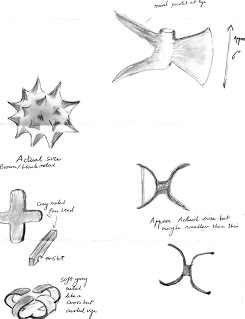
No.490 January 2012 Editor: Mary Rawitzer
HADAS DIARY
Lecture are held at Avenue House, 17 East End Road, Finchley, N3 3QE, and start promptly at 8 pm, with coffee/tea and biscuits afterwards. Non-members: £1. Buses 82, 125, 143, 326 & 460 pass nearby and Finchley Central station (Northern Line), is a short walk away.
Tuesday 10th January 2012 – The Merchant Taylors’ Great Feast, 1607. Lecture by Ann Saunders.
Dame Ann Saunders MBE FSA is a former HADAS President and a widely honoured historian and researcher on many aspects of London’s history. Her many publications include co-authorship of The History of the Merchant Taylors’ Company, covering 700 years of one of the “great twelve” livery companies.
Tuesday 21st February 2012 – The Medieval Cellars of Winchelsea. Lecture by Richard Comotto.
Tuesday 13th March 2012 – It’s all in the bones. Lecture by Jelena Bekvalac (Curator of Human
Osteology – Museum of London).
Tuesday 10th April 2012 – Conservation Techniques in Stone Masonry. Lecture by Stephen Critchley.
Tuesday 8th May 2012 – Bumps, Bombs and Birds: the history and archaeology of RSPB reserves.
Lecture by Robin Standring (RSPB Reserves Archaeologist).
Tuesday 12th June 2012 – Annual General Meeting.
Tuesday 9th October 2012 – The Life and Legacy of George Peabody. Lecture by Christine Wagg.
Tuesday 13th November 2012 – Tuesday 13th November 2012 – Archaeological Discoveries
in Southwark. Lecture by Peter Moore (Pre-Construct Archaeology)
Addendum to last month’s finds report from Hendon School Don Cooper
Following last month’s report on the finds from Hendon School (HDS06) in 2010 and 2011 (HADAS newsletter no. 489), I received back from the Museum of London seven sherds which had been given to them to identify and analyse. Their report identifies them as much-abraded Roman pottery sherds. They came from Trench A1, Context 2 of the 2011 excavation. Six are Oxford ware (OXID, dated AD50-400) and one is in a Brockley Hill fabric (BHWS, dated AD50–160). They are too abraded for their original forms to be identified. The Museum of London’s conclusion is that they are plough-soil scatter.
Inter alia I also received a very helpful e-mail from Pamela Taylor editor, of “A Place in Time”, the HADAS publication, which I failed to mention (mea culpa). Pamela points out that “Westminster Abbey obtained the whole of what became Hendon (an amalgamation of grants) during the mid-10th century and kept it pretty much intact up to the Reformation” rather than my suggestion of “ownership of the land by monasteries”. She also makes the point that Hendon was not part of the Danelaw, quoting in support the comment in The Place-Names of Hertfordshire (English Place-Name Society XV, 1932), page 26, that despite the name Dacorum, aka Daneis or Danish Hundred, which lies just north of Hendon, “The complete absence of any Danish place-name elements or personal names in the nomenclature of the Hundred shows that there can never have been any regular settlement here, even on a small scale”.
I am happy to accept both these comments.
Taylor, Pamela, ed. 1989, A Place in Time. London: Hendon and District Archaeological Society.
HADAS Anniversary – Mugs
At the recent HADAS party, attendees were given a ceramic mug suitably inscribed commemorating the HADAS 50th Anniversary. These mugs will now be available to all members at £3.50 each at the next HADAS lecture. So don’t forget to pick up your mug!!
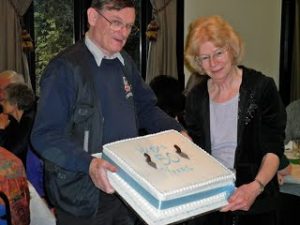
Jim & Jo Nelhams, Hon. Treasurer & Secretary,
display 50th anniversary cake suitably decorated with trowels
Jim & Jo Nelhams, Hon. Treasurer & Secretary,
display 50th anniversary cake suitably decorated with trowels
Harvey Sheldon (President) & Don Cooper (Chairman) about to start digging in!!
Sunday Sunday Sunday Andrew Coulson (and others’ comments)
The highly enjoyable 50th Birthday Buffet on December 4th, superbly organized as ever, left one HADAS member with a lot of questions and an outbreak of (blank?) verse and then led your this month’s Editor down some obscure byways of HADAS’s history:
Sunday Sunday Sunday
Sundays come in various types. There are
remembrance days, memorial days, victory days and
days that live in infamy. Some of these days
are Sundays. Our day, Hadasday, was a Sunday.
Whether it was the right Sunday is open to
question. Whether it should have been a Sunday at all
is a still larger question. A one in three
hundred and sixty five chance of being right for the day; a
one in fifty two for Sundays. But can anyone
prove this? Possibly not. But at least we think we
have the year. The buff mugs in the Garden Room
commemorate the 25th year of the society and
are dated.
In 1961 a man of Hendon, Themistocles
Constantinides, founded an archaeological society to prove
or disprove the Saxon origins of Hendon. His
English is very good but what is a man with a name like
that doing in North London? A refugee perhaps or
perhaps the child of refugees. And why the interest
in North London. We don’t know. He must have had
a lot of personal weight because the society took
off and kept rolling. It still does.
And what’s this about the Saxon origins of Hendon?
The Oxford dictionary of English place names has two
entries, one dated 975 the other 1086. “Heandun”
and “Handone” meaning “the place at the high hill”. All he
had to do was look it up in the County Histories of
the day. But he didn’t: he wanted origins and to find those
he was going to have to dig in to a past 500 years
earlier. And to do that he was going to need an
archaeological society.
Hence us. But did he ever get what he wanted? We
do fine parties: last Sunday was a fine party. Lots of food,
carols extemporised by Mrs Baldwin, the Hon
Secretary on the washboards: a great time was had by all. But
what of our mission? Fifty years is surely enough
time to produce some results but we hear only silence. This
is more than mission creep, this is mission
stampede. Something must be done.
Reading this it became obvious that even some of our more long-standing members had never read – or had forgotten – the HADAS publication “A Place in Time”, edited by Pamela Taylor. This publicly confirmed the truth of Mr Constantinides’s hypothesis of the Saxon origins of Hendon and the value of the work done by HADAS, the organization which he (among others) founded, in showing this to be true. Sheer serendipity: Andrew was given a copy of the publication by a friend after writing his “Report” and while this Newsletter was still being prepared, and learnt much!.
But there is another question still: It’s difficult to find clear information about Mr Constantinides, his other interests, his work and world. I believe, but have failed to confirm it in the time available, that, rather than coming as refugees, his family was part of that mercantile Greek diaspora which traded very successfully in Mediterranean products, tobacco, dried fruit, etc., and settled in London in the late 19th/early 20th centuries. In our Newsletter archive there is almost nothing personal about him apart from John Enderby’s obituary of Ted Sammes (Newsletter 333, 1998) with a recollection of their enthusiastic days studying:
“I first met Ted in 1960 when, along with Brigid Grafton Green and Mr. Constantinides, he attended Professor Zeuner’ s archaeology lectures at the Hampstead Garden Suburb Institute. Ted quickly proved himself to be an outstanding student whose well-researched written work shamed the others. I immediately struck up a rapport with him and, as a comparative newcomer to the area, found him to be a fund of knowledge on Middlesex and Hendon in particular. It was Ted who persuaded Mr Constan (as he was always known) to found HADAS in 1961…”
Might the 50th anniversary be the right time for a project to gather facts and memories on and about our founder members?
Interesting conferences and courses for the New Year, and a refreshing walk too
– Thames Shipbuilding and Thames-built Ships Saturday 18th February 2012
The Docklands History Group is hosting its fifth Symposium, to be held at the Museum of London Docklands. The day promises to be a first rate event, which will appeal to a very wide range of interests. For more information see the Group’s website: www.docklandshistorygroup.org.uk
– The Long View: Place and Prehistory in the Thames Valley Saturday 25 February 2012
This one-day conference will be held at the Society of Antiquaries, Burlington House, Piccadilly. It concludes the conferences in the Prehistoric Society’s Thames Valley series with a look at the long-term histories of particular places or parts of the valley. It’s aim will be to explore the differing trajectories of settlement, land-use and ritual activity in different localities from the Mesolithic onwards, including the contrast between places which were intensively used during virtually every period, and those which were used more sporadically or less intensively at certain times. Price: £35 (£20 student), including coffee (lunch not provided, available locally).
– Study Days: The Writings of Ancient Egypt and Fighting Pharaohs: Warfare in Ancient Egypt
Joyce Filer BA, Dip. Arch, MSc (formerly Curator of Human & Animal Remains, Dept. Ancient Egypt & Sudan, British Museum, London) has organized two study days, on Saturday 18 February and Saturday 31 March 2012, both from11 am to 5 pm. The first course looks at the information obtainable form the writings of ancient Egypt. Joyce says the beautiful hieroglyphic inscriptions on tomb walls and the astonishing amount of papyrus documents discovered are justly famous, but perhaps less well-known is what these written sources cover: an absolutely amazing range of subjects from laundry lists and love poems to last wills and testaments.
The second study day will highlight Egypt’s approach to its many military campaigns. The ancient Egyptians left a huge amount of artistic, biological and textual sources giving information about their combatant activities: who they fought, why they fought and where these events took place. It will examine many aspects of military life in ancient Egypt, including weapons, tools & equipment, different types of military activity, war injuries & medical treatment, and the life of the ancient Egyptian soldier. A specially designed study display will give participants the opportunity to examine source materials and test their skills of analysis.
Both study days will be held at Hughes-Parry Hall (Garden Halls), 19-26 Cartwright Gardens, London, WC1H 9EF. Applications to Joyce Filer, Accountability, 4 Lowndes Court, London, W1F 7HE (cost £40 each), or more information from study.egypt@virginmedia.com
– Course: Life in Roman London Starting January 12th, Thursdays 10.30-12.30
Highgate Literary and Scientific Institution (HLSI) is running this course on Daily Life in Roman London, using archaeological evidence to examine the 350-year history of Roman London, tutored by John Shepherd. The Spring term starts on January 12th 2012.
Few people lived in the area of the modern city before the Romans arrived and the earliest Roman town was probably more like a frontier town, but the consequences of the Boudiccan revolt in AD60-61 were to change all this. From that date onwards the Roman city of London began to flourish. This course will examine London’s buildings and people, how it was organised and the crafts and trades that were carried out. London’s fortunes changed over the centuries and the course will chart its course to the fifth century and its abandonment. For more information: phone 020 8340 7434 or e-mail admin@hlsi.net (website: www.hlsi.net).
– “An exploration of Sulloniacis: Hendon Central to Stanmore” Walk, 28th January 2012
Jane Rosoux, a well-known walks organiser is leading this Hampstead Ramblers walk. Starting at Hendon Central Station at 09.30 prompt, it is an 18.1 mile walk finishing at Stanmore Station.
A good description of the walk and its relationship to our area’s Roman period can be found at http://www.hampsteadramblers.org.uk/self-guided-walks/10-other-self-guided-walks/28-romano-british-estate-of-sulloniacis.html. It should perhaps be pointed out that the historical part of this description covers a period of which very many aspects remain obscure – in both framework and detail – and perhaps it presents a rather more concrete picture than picking up on the many uncertainties would have done!
Contact Hampstead Ramblers for more details at http://www.hampsteadramblers.org.uk/contacts.html The walk is described as strenuous!!
The Thames Discovery Programme November 8th Lecture Natalie Cohen
By Jo Nelhams
Without the River Thames there would be no London as water is the vital ingredient for human settlement. The Thames rises in the Cotswold Hills at Thames Head – a dispute over the source of the River, between Thames Head and Seven Springs, was decided by Act of Parliament in 1937 and Thames Head won. The river then flows through a variety of water meadows, farmland, cuts a deep gap through chalkland at Goring, through various historic places and towns, before flowing out through the Thames estuary to the North Sea.
Many changes, especially through human activity, have modelled the Thames to how we perceive it today. The Victorian Embankment designed by the great engineer Sir Joseph Bazalgette to improve the disposal of waste through sewers, has restricted the width, as has the construction of the docks. This narrowing has increased the flow, which in turn has led to accelerated erosion.
The Thames is an extensive resource for river studies and the Thames Explorer Trust has encouraged schools for many years to come to the river for various forms of study. Instigated in 2008, the Thames Discovery Programme was launched in October of that year. It involved training many volunteers to form the Foreshore Recording and Observation Groups or FROGS. The foreshore was walked from Richmond to Greenwich by a group of professional archaeologists. The Thames foreshore is the longest archaeological site in London. Twenty survey zones were selected, based on various criteria such as quality of features exposed, severity of erosion, accessibility and geographical location. These twenty survey zones will be only a sample for long term study as it is not possible to monitor the whole of the foreshore. Information concerning these sites can be found on the Thames Discovery website:
(www.thamesdiscovery.org/riverpedia/key‑sites-index).
Between 2008 and 2011 many features not previously recorded have emerged and been recorded. These include: London’s earliest prehistoric structure which is a Mesolithic site at Vauxhall
A number of Saxon fishtraps showing different types of fish trap construction
A jetty structure at Greenwich possibly medieval
Fragments of vessels including part identified as HMS Wellington(1852) at Charlton
The launch site of Brunel’s SS Great Eastern at Millwall.
It is important to record and photograph these discoveries, as features and structures are being eroded and some have been lost and are no longer evident. The vital monitoring work of the Thames Discovery Programme has shown that some features are still partially visible, but others now only survive in paper records and photographs.
The Thames Discovery Programme was funded by a grant from the Heritage Lottery Fund, which ceased at the end of September 2011, but the good news is that the work will continue as a core team have new contracts with MoLA (Museum of London Archaeology). The vital work of the FROG volunteers will need to continue as well. The work and discoveries so far have revealed a fascinating insight into activities along the River Thames in days gone by. This has shown how human occupation has used the Thames over centuries to aid its survival. The Thames indeed holds many stories and maybe secrets, and is still a great source for enhancing our knowledge today.
Our thanks go to Natalie Cohen for a very informative and entertaining lecture and we shall look forward to hearing of future developments from the Thames Discovery Programme.
Isle of Wight (Wednesday, Day 2 – part of part 2) Jim Nelhams
Wednesday was always going to be our riskiest day. Two boat crossings of the Solent in a small ferryboat. Hurst Castle with little shelter and, on our return to the island, an open-top bus trip to the Needles Batteries. The only other way to get to the batteries is a mile long walk from Alum Bay. And when we awoke, it was raining.
The Needles is not the flattest part of the island, but the bus trip was a circular route, with commentary.
The choices this allowed meant that while most people opted to visit the batteries, some stayed in Yarmouth, some stayed on the bus for the whole round trip back to Yarmouth, while Ken Carter and Micky Watkins stopped at Dimbola Lodge. Where? Ken’s report will explain that.
Fortunately everybody made it back to Yarmouth to find our Galleon.
Dimbola Lodge Ken Carter
Where did the life paths of these people cross – Julia Margaret Cameron, Jimi Hendrix and Virginia Woolf? It’s like a question on ‘Round Britain Quiz’.
Julia Margaret Cameron lived in Dimbola Lodge, Freshwater Bay, Isle of.Wight, from 1860 to 1875. For her 48th birthday in 1863 her daughter gave her a large plate camera. She hoped the gift would give her mother a new interest while Mr. Cameron (aged 68) was overseas, attending to business affairs in Ceylon. The present was a spectacular success. Briskly, her mother descended on an old chicken hut in the garden and turned it into a studio. She started photographing anyone she could persuade to sit for her – local children, friends’ children, neighbouring fishermen (Dimbola Lodge had originally been a cluster of fishermen’s cottages), her near neighbour & friend Lord Tennyson and distinguished visitors such as Robert Browning, Charles Darwin, G. F. Watts and his young wife, Ellen Terry. Since Julia Margaret Cameron claimed copyright for each of her photos, we have a record of the thousand or so she took during just 12 years of strenuous, excited activity. These photos are deliberate works of art. She chose individual, revealing backdrops for her sitters; she excelled in catching character-indicating aspects; she ruffled children’s hair so that they didn’t have the glazed expressions of stuffed dummies; she created many a naturalistic, posed illustration (such as for ‘Idylls of the King’). She aimed for a poetic realism. I was amazed at the life and blood freshness of her photo of Robert Browning – ready to answer me had I spoken to him. What a record, then! – a remarkable photographer … an ‘amateur’, in the finest sense … a Victorian woman of great distinction.
The statue of Jimi Hendrix stands in the front garden of Dimbola Lodge – almost 2/3 life-size, blackish against the light green lawn. He played his last concert just down the road, in 1970. Some 600,000 were at the festival, larger than the number at Woodstock that year. 19 days later, Jimi Hendrix was dead. Dimbola Lodge hosts memorabilia of the early festivals, holds exhibitions connected with rock and rock stars, together with posters & images of the I.o.W. Festivals since 2002.
Virginia Woolf was a great niece of Julia Margaret Cameron. Her sole surviving play, ‘Freshwater’, written for her friends, figures her great aunt and her associates cavorting in Dimbola Lodge. It is occasionally revived. One such – two decades ago – was at Offstage, Chalk Farm, in which the part of Ellen Terry was ‘deliciously taken’ by one Sarah Carter, my daughter.
Were these from the Battle of Barnet? By Don Cooper
David Dunk was at school at Cromer Road in the late 1950s. He and his family were living at 5 East Barnet Road. His father unearthed the items below in their back garden together with a lot of animal bones, his father thought were horse bones. David took the items into school to show them, but unfortunately they then went missing (it is possible somebody may have them, it would be great if they turned up – contact me at the address below.). Here is a drawing made by David (excellent! if I may say so) for me so that I could publish them. I look forward to receiving HADAS member’s views.
News of other events by Eric Morgan
Thursday 5th January 8pm: Pinner Local History Society, Village Hall, Chapel Lane Car Park, Pinner. Talk by Terry Jenkins: “Sir Ernest Lemon: The Railwayman who equipped the RAF for war”. Visitors £2.
Monday 9th January 3pm: Barnet & District Local History Society, Church House, Wood St, Barnet. Talk by Pamela Wright: “The Life and Times of Octavia Hill
Wednesday, 11th January 2.30-4pm: Mill Hill Historical Society, Wilberforce Centre, St Paul’s Church, The Ridgeway, NW7 1QU. Talk by Wing-Commander Erica Ferguson: “The History of Bentley Priory: WW2 Bomber Command.
Wednesday 11th January 7.45pm: Hornsey Historical Society, Union Church Hall, corner Ferme Park Rd/Weston Park. Talk by Janet Owen: “Images from the North Middlesex Photographic Society” Visitors £2. Refreshments, sales & info.
Saturday 14th January 2-4pm: Museum of London, London Wall, EC2Y 5HN. Walk “Walking the Roman Wall”. Book in advance, £10 (concs £8) 020 7001 9844 or thro’ www.museumoflondon.org .
Tuesday, 17th January 6.30pm: LAMAS, Clore Learning Centre, Museum of London, London Wall, EC2Y 5HN. Talk by Julian Hill (MoLA) ” Mapping Roman London: from site context to town plan”. Refreshments 6pm. Please note this lecture is on Tuesday, not Thursday as in December’s Newsletter
Wednesday, 18th January .7.45pm: Edmonton Hundred Historical Society, Jubilee Hall, 2 Parsonage Lane/junction Chase Side, Enfield. Talk by Graham Dalling “Architectural Photography”. Visitors £1
Thursday, 19th January 8pm: Enfield Society, Jubilee Hall, as above. Talk by Dave Cockle “The History of Enfield’s Railways, Part 1. Lea Valley, Southbury Loop, Enfield Town”.
Friday, 20th January 7pm: COLAS, St Olave’s Parish Hall, Mark Lane, EC3. “Talk by Lyn Blackmore (MoLA) “Londinium to Lundenwic: Saxon London & its Region” £2.
Tuesday, 24th January 6pm: Gresham College at Museum of London, as above: Talk by Richard J Evans “Empire: from Conquest to Control”. Free.
Thursday, 26th January 6pm: Gresham College, Barnard’s Inn Hall, Holborn, EC1N 2HH: Talk by Dr Patrick Wallis & Dr Christopher Minns (LSE) “Apprenticeship in Early Modern London: Economic origins & destinations of apprentices in 16th & 17th centuries. Free.
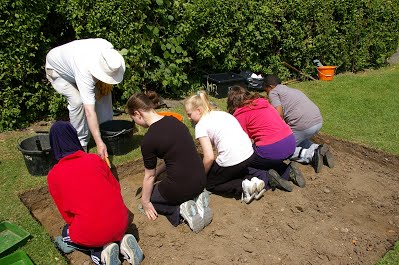
It has come around again, imagine! Where did the year go? Anyway, it is that time again when we wish all our members and their families a happy holiday season and, of course, a healthy, happy and prosperous 2012.
HADAS DIARY
Lectures are held at Avenue House, 17 East End Road, Finchley, N3 3QE, and start promptly at 8 pm, with coffee/tea and biscuits afterwards. Non-members: £1. Buses 82, 125, 143, 326 & 460 pass nearby and Finchley Central station (Northern Line), is a short walk away.
Sunday 4th December 2011 – HADAS Christmas Party
Tuesday 10th January 2012 – The Merchant Taylors’ Great Feast, 1607. Lecture by Ann Saunders.
Tuesday 21th February 2012 – The Medieval Cellars of Winchelsea. Lecture by Richard Comotto.
PLEASE NOTE: Change of Date for this February lecture.
Tuesday 13th March 2012 – It’s all in the bones. Lecture by Jelena Bekvalac (Curator of Human
Osteology – Museum of London).
Tuesday 10th April 2012 – Conservation Techniques in Stone Masonry. Lecture by Stephen Critchley.
Tuesday 8th May 2012 – Bumps, Bombs and Birds: the history and archaeology of RSPB reserves.
Lecture by Robin Standring (RSPB Reserves Archaeologist).
Tuesday 12th June 2012 – Annual General Meeting.
Tuesday 9th October 2012 – The Life and Legacy of George Peabody. Lecture by Christine Wagg.
Tuesday 13th November 2012 – Tuesday 13th November 2012 – Archaeological Discoveries
in Southwark. Lecture by Peter Moore (Pre-Construct Archaeology)
Below is a “Customer’s” view of the first day of our excavation at Harrow-on-the-Hill (see last month’s newsletter)
ARCHAEOLOGY ON THE GREEN, HARROW ON THE HILL
12TH & 13TH AUGUST 2011 by Judith Mills
It began on Thursday with bore holes. Don Cooper, a trained archaeologist passionate about community archaeology, made 6 bore holes on The Green on Harrow on the Hill. We had seen pictures of possible concrete under The Gantry and the bore holes revealed sandy soil. Relief all around and the dig could start. This was the first part of The Gantry project. There has been very little archaeology on the Hill despite its long history. As the Gantry on The Green has been a feature for at least 325 years we thought it would be a good idea. Also we could look at the footings of the 19C base in preparation for the removal of the 1980s structure and its replacement, with one that is more in keeping with previous ones.Five other amateur archaeologists from HADAS (Hendon and District Archaeological Society) joined Don on Friday: Sarah, a PhD Archaeology student, Vicky, Jim, Guy the Major and Bill. Have to say they may have not been Time Team but they looked like them.
The process was as follows: unload Don’s car of axes, trowels, buckets, baskets, tool box, measuring tape, string, plastic fencing for overnight protection, blue plastic sheets for the turf and the spoil, i.e. the soil you dig out of the trench. Then the trench was measured and marked with string. It extended 3 metres from under The Gantry towards the tree. The turf was cut carefully, removed and laid out in order on one of the blue sheets. When two people were working on this or any task, the other four were hawkeyed and chatting ‘this looks like sand’ ‘perhaps levelling the ground at some stage’ ‘what’s that’ ‘at least it’s not clay’. Clay is dreaded for Archaeology in London. Once you reach it you meet the geology which means no more evidence of human activity.
The trench appeared when the grass disappeared and the work begins after kneepads, gloves and sun screen are donned. Worms, caterpillars and earwigs are put in soil buckets for a sleepover. There is a ritual of breaking the soil with a fierce tool and then gently scraping the earth with a flat trowel, all the time keeping to the line of the string. Bits of clay pipe are found. Clay pipes were given free with pints of beer until the 1930s, a custom from the 1600s. A shard of Victorian pottery, beautifully embossed, was seen. Sarah had the knowledge to explain how it was made and fired to people who passed by and showed interest. Lin, a local volunteer, was sifting through the spoil heap and found a button. It had a copper back and a glass top made from glass rods moulded together to form a rose. We had a number of visitors with their own memories or stories. The Kings Head allegedly had cellars that went under The Green and also had its own well.
Archaeologists are observant and enquire. What looked like an ordinary stone to me, had marks of being worked on and the ensuing discussion surmised it could be a weight. There is a photo of the Green in the 1930s with a goat. We found one of its teeth. Other finds were a piece of Tudor pottery (maybe),Victorian earthenware, shards of pots, long nails (could be from a previous gantry), old glass which has bubbles in it and then ‘the pipe’. We had been assured by all the services there was nothing under The Green. What was it? Pictures from the display in Stephen Woodward’s, the local estate agents, gave the answer. Jim detected small remnants of the gas lamp on the Green and the pipe was in line with it! Care was taken with it and then, the fear became a reality. London clay at 10 inches! It was 4.00pm first day, just like Time Team. A rethink and a new plan for the morning!
Judith Mills
Snippets of Archaeological News
Oldest Briton?
Scientists re-examining a fragment of jawbone with three teeth that was found in the 1920s in Kent’s Cavern near Torquay have established that it is much older than previously thought. The team from Oxford University say that it is between 41,000 and 44,000 years old and is the earliest known human “part” in Western Europe. The Times 3rd November 2011
Worcestershire coin hoard
A metal detectorist found a Roman coin hoard at Bredon Hill, near Evesham in June 2011. The hoard consisted of 3784 coins with 16 Roman emperors represented. Worcestershire archaeology service has subsequently found evidence of a Roman settlement at the site. The coins are now being conserved at the British Museum. Redditch Advertiser 22nd October 2011
Early Bronze Age cist excavated on Dartmoor
An early Bronze Age burial cist containing cremated bones and material dating back 4,000 years has been excavated on Dartmoor (Devon, England). Archaeologists uncovered items from the site on Whitehorse Hill including a woven bag or basket and amber beads. Dartmoor National Park Authority said the discovery could be one of the most important archaeological finds in 100 years.
Archeo News, 15th November 2011.
Viking’s Sat-Nav?
Scientists say that a crystal called Iceland spar could have helped Norsemen to navigate to within one degree hundreds of years before compasses reached Europe by enabling them to detect the sun’s position. Iceland spar, a transparent form of calcite common in Scandinavia, is sensitive to polarisation, the way sunlight is scattered by the atmosphere. The crystal could have been used as a “sunstone” to pinpoint the sun in a cloudy sky. The Times 2nd November 2011.
The finds report on the Hendon School Excavations in 2010 & 2011 by Don Cooper
address: Hendon School,
Golders Rise,
Hendon
NW4 2HP
Site Code: HDS06 Grid reference 523675.129E 189026.785N and height above sea level 59.850m. The centre of the combined trenches was 13m due east of the grid reference point.
This report covers the finds from two Hendon School excavations as both took place in the same area.
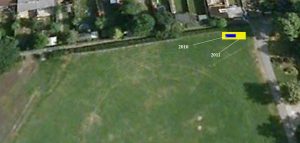
Figure 1 This is a Google Earth image of the Hendon School playing field looking almost due north. The white/yellow rectangle represents the 2011 dig and the black/blue one 2010. The 2010 area would be under the 2011 area. The view is not to scale.
The 2010 dig took place from 28th June to 2nd July and a preliminary report was produced. It was published in the HADAS Newsletter No. 473 in August 2010 and can be read on the HADAS website. In summary, it was a very successful dig with respect to demonstrating practical archaeological skills to the pupils. However, as is often the case, the natural surface was not reached due to the constraints of time. On the last day a sondage (a small trench within a trench) was excavated which, in this instance, was used to assess where the natural, i.e. London Clay, occurred. Imagine our surprise when 117 sherds of early medieval pottery sherds (bits of pot) turned up. The sondage was only 2 metres by half a metre and either we had struck lucky or there was more to find. We determined to come back the next year.
So in June 2011 (17th to 25th) we returned to Hendon School, to the same place as far as it was possible to identify because, unfortunately, in the intervening year building contractors, who were building the new 6th Form building, had been using the area to park their huge trucks, track-laying vehicles and diggers and, in addition, the hedge which we had used as a marker since it ran parallel to the side of the 2010 trench, had been grubbed out! We also had an erroneous measurement from the 2010 excavation. A preliminary report of the 2011 dig was published in the HADAS Newsletter No. 485 in August 2011 and is also on the website.
More trials and tribulations of the 2011 dig were brought about by the fact that we had 260 pupils to cater for. The trench, which was opened by the on-site building contractors using a digger, was 6 metres by 6 metres which was intended to encompass the 2010 trench. However, in order to have some chance of managing that many pupils an area of 3 metres by 6 metres of the western end of the trench (i.e. half of it!) was dedicated to the pupils and did not go down very far as the same area was more or less reprocessed with each new group of pupils. When there was time, we dug the eastern end as far as we could. This somewhat unsatisfactory outcome nevertheless revealed more medieval pottery sherds.
What did we find?
2010 report
The trench was three metres by two metres (see blue area in fig.1) and in terms of depth is divided into a series of contexts, features and sondage as follows:
Context 1: the de-turfing layer about 6cm deep
The context was mostly detritus from the playing field – sweet papers, broken pens and pencils, bits of metal (nails & modern coins), building material (brick, tile and slate) and a few small sherds of pottery (three pieces of English Tin-glazed ware). Except for the pottery, all the finds from context 1 were discarded. The modern coins were added to the coffee fund.
Context 2 with context 3, context 4 (a lens of London Clay) and context 5 (a slight gravel layer) all deemed part of context 2.
This was the main context. It roughly occupied between 6cms and 25cms and was therefore approximately 20cms deep. It was a much disturbed layer with evidence of previous episodes of gardening.
There were lots of finds:
Building material: Brick (794g), Roof tile including peg tiles (878g), Floor tile (157g), Slate (78g), Ceramic drain, red and white (45g).
All discarded except one piece of peg tile, one piece floor tile and three pieces of decorated tile.
Glass: Bottle glass, brown (17 pieces), Bottle glass, green (9 pieces), White bottle glass (45 pieces), Window glass (25pieces). All discarded.
Clay pipe: 54 pieces of stem, 7 pieces of bowl. All retained.
Metal: 37 nails, two horseshoes (one very small), one hook, one part blade and one amorphous lump of iron. Only the horseshoes, lump of metal, and part knife blade were retained.
Animal Bone: It has been a characteristic of all the Hendon School digs that there has been remarkably little animal bone found. In this case, seven very degraded pieces of bone were found and discarded.
Pottery: 48 pieces of pre-1350AD pot sherds weighing 302 g, mostly cooking pots with one bowl fragment; there are five different fabrics from, at least, 20 vessels. Then there is a gap of approximately 100 to 150 years in the pottery sherd date sequence. After which there are 150 sherds (783g) made of medieval fabrics (AD1480 onwards) to modern (AD1900), including Border ware, German stoneware and transfer-printed ware.
Sondage and features 3 and 4: The sondage was at the eastern end of the trench and was two metres by half a metre and approximately 25cm deep. Mid-way across the sondage there was what seemed like a post hole into the London clay natural surface. The top of the post hole was designated feature 3 and the bottom feature 4.
The sondage produced 114 sherds (414g). They consisted of five pieces of Roman pot, 107 pieces of pre-1350AD pot and two small sherds (4g) of 17th century intrusions. The top feature produced 3 sherds of pre-1350AD pot and the bottom feature had 2 unidentified pieces of metal, probably nails. There were no other finds.
2011 report
Trench A1 covers both the black and the white rectangles in Fig.1 (blue/yellow for those receiving this Newsletter by e-mail!). The only trench opened was 6m x 6m with the eastern half of it used to teach practical archaeological excavation skills to the pupils. Due to time constraints the other half was not excavated down to the natural. Some of the trench was on top of the 2010 trench. Fig. 2 gives an indication of where the contexts were.
Figure 2 2011 trench
Context 01 De-turfing by machine. The only finds were the detritus of the playing field. None were retained. This context is not shown on the sketch as it covered the whole trench.
Context 02
The top 25cm of the western half of the trench yielded many finds. This was a very disturbed context with pot sherds whose date sequence ranged from the 11thC to 19thC (168 sherds weighing 1055grms). Most periods were represented except between mid-14thC and early 16thC, a similar pattern to the one we had seen in the 2010 excavation. The pre-/mid-14thC sherds were represented by at least seven different fabrics, but the forms were mostly cooking pots, jugs and jars. As well as the pot sherds there was roof tile (56 pieces, 2 retained), Claypipe (32 stems, one retained which was stamped “J Cole, High St. Hampstead”, and four bowls, one retained), Bottle glass (five pieces, three retained) and window glass (three pieces, none retained). One large piece of slag (281grms) was retained and there was also one piece of glazed tile, one fragment of an ornament; one small medallion, scalloped shaped, all of which were retained. Metal nails (3 iron nails) and two tiny fragments of bone were discarded.
Context 025 (properly a feature) This context was a small irregular patch of gravel in the south-west of the trench. It produced no finds.
Context 028 This context represented a sondage sunk in the middle of the western half of the trench. It was 2metres by half a metre. There were no finds from this, possibly because it was where the 2010 trench had been.
Context 027
The finds from the eastern half the trench which was dedicated as a “pupil” area (Context 027) were as follows: Pottery sherds (51) of which 18 were pre-/mid-14thC and retained, of the other 33, nine were retained. A similar dating sequence gap to that mentioned previously was observed. As well as the pottery there were: 36 clay pipe stems (none retained), three pieces of clay pipe bowl, two with the makers mark “WT” (all retained), 28 pieces of brick and tile (3 peg tile retained), glass (27) mostly green and brown wine bottle sherds (two retained). Metal: 8 nails (one retained).
Context 030 This was an “L” shaped sondage in the north-west corner of the trench 1m east x half a metre south and then extended 1 metre to the south by two-thirds of a metre east and 30cms deep. The natural London clay was reached. The grubbing out of the hedge may well have disturbed this context.
There were 36 sherds of pre-/mid-14thC pot (all retained) with most of it being 12th/13thcC. Brick and tile (18) one retained and one pipe stem retained. There was no glass or bone in this context.
Interpretation
The hamlet at the crossroads of Brent Street and Bell Lane is clearly established by the Survey of Middlesex by John Roque in 1756. According to the History of Middlesex in the Victoria County History (VCH) series, Brent Street was the largest hamlet in Hendon in the 18th century. Brent Street as a hamlet is first mentioned in 1613 (Petrie, 2005, p25). John Norden was living at Hendon House in Brent Street in 1607 as he recorded on his maps. However, it is difficult to go further back, other than noting that we know the ownership of the land was by various monasteries. Brett-James (1932) says that Hendon was at one stage part of the Danelaw. In 1540 the Abbot of Westminster resigned, and Henry VIII created a new bishopric which included Hendon, according the Letters Patent of 1542 (Hopkins1964, p33).
The sherds of Norman pottery found in the excavation at least indicate human presence in the area during the 12th, 13th, and 14th centuries. The gap in the pottery date sequence cannot easily be explained. The Black Death, which wreaked such a terrible toll in the years 1348 to 1350, may well be the explanation as to the area being deserted and not repopulated for a considerable time. According Brett-James (1933, p2):
“We had no exact figures for the ravages of plague in Hendon, but the disappearance of
certain families after 1350 side by side with the persistence of others and the rapid changes
of officials at that time are possible indicators of the mortality caused by the plague.”
No structures have so far been found; the “post hole” in the sondage in 2010 could just as easily be a fence post, as old maps show a fence on roughly the same alignment. The land slopes down from the crossroads of Brent Street and Bell Lane and the finds from the 16thC onwards may well be “hill wash” gradually moving down the slope. On the other hand, Bell Lane is an old road as it leads to the crossing of the Brent at Mutton Bridge, so perhaps there were dwellings along it.
I would like to invite any of our readers, who may have done more research than I, to send me their thoughts and references so that we can gradually refine the story of the area.
It has to be remembered that the main objective of the excavations at Hendon School is to demonstrate practical archaeology to the pupils. In 2010 Sarah Dhanjal produced a first-class 22-page booklet specifically for the school excavations. The booklet highlighted the tasks we try to cover during the excavation.
The tasks included: Health and Safety with special reference to the tools used in practical archaeology as well as behaviour on the site, Drawing, including “drawing our site” using plan and section drawing, There was photography, surveying using the dumpy level, finds processing including pot washing and marking, as well as trowelling in the trench as you can see in the photograph below:
Figure 3: The Learning Process at Hendon School
References:
Baker, T.F.T. ed., 1976. A History of Middlesex vol.5 Oxford: Oxford University Press (VCH series).
Brett-James, Norman. 1932. The Story of Hendon. Hendon:Warden & Co.
Brett-James, Norman,1933. Some extents and surveys of Hendon: In LAMAS transactions Vol.VII, Part I.
Hopkins, John. 1964. A History of Hendon. Published by Hendon Borough Council.
Petrie, Hugh. 2005. Hendon & Golders Green Past. London: Historical Publications Ltd.
The October Lecture Report by Sheila Woodward
“Silchester: the Revelation of an Iron Age and Roman City” by Dr. John Creighton
After many visits during the last 50 years, the site at Silchester is no stranger to HADAS. Nor is Dr. John Creighton: he reminded us that in his student days he joined us briefly on our West Heath dig.
Unlike most Roman towns in England, Silchester (Calleva Atrebatum) was totally abandoned when the Romans departed; there has been no rebuilding on the site. Only Caistor St Edmund, which we visited last year, and Wroxeter, which we hope to visit again next year, share this distinction. It means that the original lay-out of the town is intact under its covering of soil and vegetation. That was long ago appreciated and Silchester has been extensively excavated.
Even in the 18th century the site had attracted the attention of antiquarians such as William Stukeley and John Ward and their descriptions and tentative plans have proved valuable to the later researchers. By the 19th century both excavation techniques and mapping had improved dramatically and Dr. Creighton likened Henry McLoughlin’s topographical map of 1850, showing all the massive earthworks visible in Silchester, to a modern OS map. After the area came into the possession of the Duke of Wellington, the Society of Antiquaries was able to organise a full season (May to November) of excavation each year from 1890 to 1908, so producing the first comprehensive survey of a Roman town in this country. It has been reproduced many times in books on Roman Britain. Archaeology as discerned by Pitt Rivers was beginning to take shape. In more recent years the development of Roman Silchester from its Iron Age predecessor has attracted much attention, particularly in the area known as Insula IX, lying north-west of the Forum.
How did the Roman town develop? How was it related to its predecessor? And how and when did that town develop? The sources of information available are now so many and varied and our lecturer whirled through them at such a speed that my notes are woefully inadequate! Aerial photography combined with new excavation has revealed more stone buildings, shops and workplaces, and a large timber building at a diagonal to the street grid. In 1973 George Boon and Colin Williams wrestled with the dating of the earthworks. There were geophysical surveys in 1993 and an English Heritage magnetic survey in 2008, and there have been resistivity surveys and ground penetrating RADAR ones. The Society of Antiquaries plans have been digitised and there has been a new mapping project somewhat troubled, I gather, by livestock challenges, especially from llamas!
Dr. Creighton plans to accumulate data from every possible source and combine all the available information to get an overall view of the town, its predecessors, its history and its surroundings. At present it seems possible that there were Roman incursions in the area well before the AD43 conquest. There are many features which still need explaining. Dr Creighton has set himself a massive task but he is an enthusiast. Further developments in the Silchester saga will be well worth watching.
Isle of Wight (Day 2 – part 1) by Jim Nelhams
For most people, no visit to the Island would be complete without exploring Osborne House and its grounds. But first we went to a local glassworks before a nostalgic trip by rail through the countryside to Wootton, to be met there by Dave in our coach. Not all members share the same interests, and sometimes it is possible to accommodate special requests. In this case, Andy Simpson, with the chance to explore the railways, disappeared as it were in a puff of smoke…. Now read on:
Glory Art Glass www.gloryartglass.com by Lydia Demetris
I looked forward to this visit, as I had often watched glassblowing as a child in my father’s factory, the Hastings and Folkestone Glassworks.
Martin Evans, the owner, began his business 15 years ago after retiring from the armed forces. He gave a very good talk and potted overview of the glass industry. The way he makes his glass, he stated, has little changed since Roman times, and he had, in fact, made replica Roman glassware for Carisbrooke Castle in the past. The business involves both sales of his finished work and demonstrations to schools and parties.
Glory Art Glass premises consists of a ground floor shop divided by a wooden counter into a street entry customer’s retail display area and manufacturing space to the rear. Helpful display boards detailing some glass-manufacturing processes hang in strategic places around the walls. Our group sat in the showroom facing the workroom, on the long benches and chairs that are provided for their group visitors, tourists and school parties. Martin began his presentation with a short history of Glass.
Glass is a simple process made originally from silica sand, soda and lime fused at high temperatures. Many variations have taken place including potash and lead, the latter making the glass easier to work. Silica sand is obtained from numerous sites in the UK. The use of the sand from each site depends on its content. For example the type that Martin uses for his work differs from that used in the manufacture of Plate Glass for shop windows. (Further information can be obtained from the British Geological Society www.bgs.ac.uk) However, Martin buys his ready mixed from Scandinavia together with ground coloured glass in a variety of shades.
Martin began his talk by introducing the beginning of production of glass at around 5000 years ago with simple beads gradually progressing to carved artefacts where glass was treated rather like stone. The big step forward in his opinion, was the introduction, during the Roman Period, of metal blowing tubes leading to the production of all kinds of vases, drinking vessels and jewellery. He then proceeded to show us some of his moulds that glass can be blown into, together with his metal pincers, cutters and tools used to process his stock. Glass windowpanes in Roman times would have been either poured into moulds or blown and then unrolled.
At the rear of the premises an oven with molten glass was heated at a constant temperature of 1100oC, taking four days to achieve this. The oven has to remain constantly fuelled during operation and in a commercial situation this would involve 365 days a year, although Mr Evans now closes it during the winter months, presumably due to trading reasons. In days before gas a constant supply of wood was essential, and we learnt that the Chinese, in the past, were experts at building huge draught ovens on hillsides to maximise heat.
Martin introduced a blow rod into the oven and withdrew a small bulb of glass. I would have expected the rod to be heated prior to this, but I neither saw any evidence that it had taken place nor was in a position to see whether he marvered the glass. He certainly rotated the soft bulb to keep it centred and blew through the tube to form a bubble, introduced the coloured ground glass and briefly replaced it in the oven. He explained how it could be re-dipped after cooling to encapsulate the colour and how this process was used to create his glass vases and other pieces in the showroom. He then used his tools to crimp and pull wings and a beak from the glass and skilfully produce the shape of a bird. The glass, he said was still at a temperature of 3000 oC and he proved how hot it was by touching it with a newspaper, which immediately burst into flames – an instant winner with the schoolchildren of course. The bird, still attached to the rod was placed in an Annealing Oven. The rod was tapped to disengage the bird and the door closed. Glass produced in this way is kept in an Annealing Oven overnight at 500 oC to cool; as if it cooled too quickly it would implode. Martin then took out another bubble of glass and blew it into a huge bubble before bursting it safely into a bucket with a resounding bang that made us all laugh.
Martin then began his final process which involved another glass bulb which he processed into a flower with his crimpers, then twisted the base and curled it to make hand crafted napkin rings. These, he said, together with the small animals, were the basis of his trade and how he was able to stay in business. We then had our buying opportunity!
Martin’s presentation was very enjoyable and gave a very good overview of the old skills of glass blowing to the general public. It is, of course, too huge a subject to discuss in any depth. I think we all thoroughly enjoyed our visit.
RAILWAYS by Andy Simpson
After our thoroughly enjoyable visit to the glass emporium, the group boarded the coach for the short trip to the western outskirts of Sandown where the railway station is situated. This, for me, was obviously the start of a much-anticipated part of the trip.
The story of railways on the Isle of Wight began with the opening of the line from Cowes southwards to Newport in June 1862. The opening of the line from St Lawrence to Ventnor West in June 1900 completed an island-wide system of 55.5 route miles, serving 36 stations. Road competition and declining traffic saw early route closures in 1952, 1953 and 1956. Closure of the Smallbrook Junction (of which more later) to Cowes via Newport (the hub of the system) and Shanklin–Ventnor lines to passengers in February/April 1966 saw the ‘main line’ reduced to the 8.5 miles on the eastern side of the island between Ryde Pier Head southwards to Shanklin, which was operated by Victorian Adams class O2 0-4-4 tank steam engines until 31 December 1966. Tight clearances in the tunnel at Ryde limited the choice of replacement stock. The remaining line was electrified on the third rail system from late 1966.
From 20th March 1967, services on the remaining line were provided by three/four-car sets of 1923-34 built ex- London Transport ‘Standard’ tube stock originally from the Bakerloo/Northern/Piccadilly Lines and later used on the Northern City Line, painted initially in soul-less 1960s/70s BR ‘rail blue’, several cars of which returned to the mainland in 1990 for preservation by the London Transport Museum – some of which remain in store at Acton Depot for future restoration to working order for use in LT’s Heritage fleet. From the autumn of 1989, initially part of ‘Ryde Rail’, they were replaced by shortened two-car sets of ex-Northern line ‘1938 stock’ – on one of the six ‘Class 483’ sets currently in use, which HADAS, filling some normally quiet coaches at that time of the day, took a short run on what now trades as the heavily-subsidised ’Island Line’ (www.island-line.com) from Sandown northwards via the former junction at Brading (of which more later in the week) to Smallbrook Junction just outside Ryde. From 2000, after carrying various liveries since 1989, these sets have all rather fetchingly been repainted into LT red!
Until 26 January 1969, the railway on Ryde Pier was paralleled by the Ryde Pier Tramway, of which the rusting track supports remain – as well as one preserved tram from this line in Newport Bus Museum (see below). HADAS saw another ex-Ryde Pier tram – the horse-drawn ‘Grapes’ car of 1871 – at Hull Streetlife (Transport) Museum on our visit there a few years back.
When we reached Smallbrook Junction, a swift cross-platform transfer was made to a steam-hauled train on the Isle of Wight Steam Railway (www.iwsteamrailway.co.uk) , which operates from there five miles westwards to Wootton along part of the former Newport/Cowes Line; in July 1991 the railway reopened the previously closed line and lifted three miles of track from Havenstreet, from where preserved trains ran to Wootton from April 1971, operated by the Wight Locomotive Society, making this their 40th anniversary year, with various special events. Our eager throng crowded onto our specially reserved coaches, including the one I was on, dating back to 1922 (hauled by former Longmoor Military Railway and Marchwood Military Port 1953-built Hunslet 0-6-0ST WD192 ‘Waggoner) for a one-way trip along the line via Ashey and Havenstreet to Wootton, where the rest of the party moved on via St Mildred’s Church at Whippingham to Osborne House, leaving yours truly with his bargain value £14 ‘Island Liner Rover’ to explore both the preserved and main lines at leisure – which I did, thoroughly!
The preserved line’s engine shed and HQ is at Havenstreet, with plenty of interesting steam (and diesel) engines in the yard, including the sole-surviving ‘O2’ Calbourne, sold by BR for preservation in May 1967, and two well-stocked bookshops to browse! The weather was pleasant and the camera saw plenty of use … after which I re-joined the ‘main line’ at Smallbrook Junction and spent the next five or six hours traversing the line and visiting seven of the eight stations, including the very pleasant heritage and information centre at Brading station (www.bradingstation.com), to catch up on local gossip (much disquiet at IoW council cuts) and have a welcome mug of coffee. Come rush hour, the trains filled with commuters and unusually smartly dressed school children. All trains run VERY punctually through some very pleasant countryside, much like the top few miles of the Central Line towards Epping where one can also travel on a tube train with green fields both sides of the track.
Exhibition at the British Museum by Don Cooper
The Grayson Perry exhibition at the British Museum “The Tomb of the Unknown Craftsman” which runs until the 19th February 2012 (cost £10 for seniors, members free) is proving very popular. The exhibition which is of a unique kind for the British Museum sets modern craftsmanship against old items made by unknown craftsmen from the BM’s eclectic collection.
In the accompanying catalogue (Perry, 2011) Neil MacGregor, Director of the British Museum, he of “The History of the World in 100 Objects”, says “The resulting juxtapositions are something that none of those of us working in the Museum ever would – or could – have brought into being.” And Jacob Bronowski is quoted in the introduction to the catalogue as follows: “The most powerful drive in the ascent of man is his pleasure at his own skill. He loves to do what he does well and, having done it well, he loves to do it better. You see it in his science”.
This is an exciting exhibition which certainly changed my views. If you are going, you need to book in advance as the exhibition is timed entry.
Perry, Grayson, 2011. The Tomb of the Unknown Craftsman London: British Museum Press.
News of other events by Eric Morgan
Tuesday, 6th December at 14.00: Harrow Museum, Headstone Manor, Pinner View, North Harrow, HA2 6PX, a talk by Tony Earle on “Thames Barges”. Cost £3.
Wednesday, 7th December at 13.00: Gresham College at the Museum of London, 150 London Wall, EC2Y 5HN, a lecture by Prof. Tim Connell called “The City Livery Companies”. Free.
Monday, 12th December at 18.30: British Library Conference Centre, 96 Euston Road NW1 2DB, a talk Michael Wood called “Royal Manuscripts, the story of a book” The talk is on a manuscript about King Athelstan. Cost £7.50 (£5 for concessions).
Tuesday, 13th December at 18.30: LAMAS at the Clore Learning Centre, Museum of London, 150 London Wall, EC2Y 5HN, a lecture by Glynn Davis and Catherine Elliott called “Thomas Layton’s Artificial Curiosities: Oceanic Collections of an ‘Old World Type’”. Free.
Tuesday, 13th December at 20.00: Cuffley Industrial Heritage Society, Northaw Village Hall,
5 Northaw Road West, EN6 4NW a talk by Robert Hulse called “Isambard Kingdom Brunel’s First Project”. Non-members £3.
Wednesday, 14th December at 14.30: Mill Hill Historical Society, Wilberforce Centre, St. Paul’s Church, The Ridgeway, NW7 1QU, a talk by Neil Morley called “Hidden City”.
Wednesday, 14th December at 19.00: Camden History Society, Charlie Ratchford Resource Centre, Belmont Street, NW1 8HF (off Chalk Farm Road opposite The Roundhouse), a talk by Dr. Ann Saunders called “The London Letters (1712-1713) of Samuel Molyneux, later MP”. Wine and mince pies before talk.
Wednesday, 14th December at 19.45: Hornsey Historical Society, Union Church Hall, corner Ferme Park Rd. Weston Park N8, a talk by Mark Evison called “Alexandra Park, Past and Present” Visitors £2.
Events for your next year’s diary
Thursday, 17th January 2012 at 18.30: LAMAS at the Clore Learning Centre, Museum of London, 150 London Wall, EC2Y 5HN, a lecture by Julian Hill of Museum of London Archaeology called “Mapping Roman London: from Site Context to Town Plan”.
Saturday, 9th April 2012, at the Museum of London: The LAMAS Archaeology Conference. You can apply for tickets online. (Members £8, non-members £10).
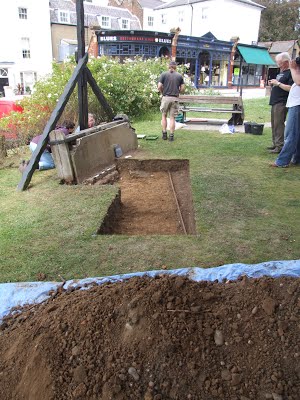
HADAS DIARY
Lectures are held at Avenue House, 17 East End Road, Finchley, N3 3QE, and start promptly at 8 pm, with coffee/tea and biscuits afterwards. Non-members: £1. Buses 82, 125, 143, 326 & 460 pass nearby and Finchley Central station (Northern Line), is a short walk away.
Tuesday 8th November 2011. The Thames Discovery Programme. Lecture by Nathalie Cohen.
When the tide is out, the Thames is the longest open–air archaeological site in London, and much of the foreshore is freely accessible to the public. However, many of the exposed archaeological sites are often unrecognised and unprotected, and almost all are vulnerable to the twice–daily scouring of the tidal river, and thus require close monitoring.
Building on initiatives pioneered by the Museum of London’s Thames Archaeological Survey that took place from 1993–1999 and the Thames Explorer Trust’s innovative education projects, the Thames Discovery Programme aimed to communicate an understanding and informed enjoyment of the historic Thames to the widest possible audience. From 2008-2011, Nathalie was the Team Leader for the Thames Discovery Programme, a Heritage Lottery Funded community archaeology project. This talk will present some of the exciting discoveries made on the Thames foreshore during the three years of the project and the plans for the future of the programme.
Sunday 4th December 2011 – HADAS Christmas Party
This will be a lunch/afternoon affair. Please see separate booking form with this newsletter. As noted last month, we have booked Avenue House for this event. The cost is £20 per head and we need to have your booking form and money by 15th November, so that we can order sufficient food
Tuesday 10th January 2012 The Merchant Taylors Great Feast, 1607. Lecture by Ann Saunders.
Tuesday 14th February 2012 The Medieval Cellars of Winchelsea. Lecture by Richard Comotto.
Tuesday 13th March 2012
It’s all in the bones. Lecture by Jelena Bekvalac (Curator of Human Osteology – Museum of London).
Tuesday 10th April 2012 Conservation Techniques in Stone Masonry. Lecture by Stephen Critchley.
Tuesday 8th May 2012 Bumps, Bombs and Birds: the history and archaeology of RSPB reserves.
Lecture by Robin Standring (RSPB Reserves Archaeologist).
Tuesday 12th June 2012 Annual General Meeting.
Tuesday 9th October 2012
The Life and Legacy of George Peabody. Lecture by Christine Wagg.
Tuesday 13th November 2012 Lecture to be confirmed
HADAS LONG OUTING 2012
2012 is both Diamond Jubilee Year and Olympic Year; many regular holiday arrangements will be amended. Therefore we have started our planning early.
Our base will be Ironbridge and we have provisionally booked the Best Western Valley Hotel, which is in the Severn Gorge less than a mile from the Iron Bridge itself. Very few dates were available in our regular window.
Preliminary checks show that there is more than enough of interest in the area, and although we will visit some of the “industrial” museums, we have also listed a Roman town (Wroxeter) and vineyard, a brewery, and interesting old town (Shrewsbury), some unusual churches, an air museum, a boat trip, a steam railway and a wildlife park. And there are others…
So please put the dates in your diary: Monday 27th (Bank Holiday) to Friday 31st August 2012.
More details in the New Year when initial deposits will be required. Final costs should be about the same as this year, say £390 sharing a room and £450 in your own room.
We have booked rooms based on this year’s Isle of Wight group – and that may not be enough. If you are interested, and you are coming to our Christmas Party, please complete the section provided on the form enclosed with this newsletter. If you are not coming to the Party, you can still return the form, or email or phone Jim or Jo Nelhams (contact details at end of the newsletter) so that we have a better idea of numbers.
Report of an excavation at Harrow-on-the-Hill village Green – August 12th/13th 2011 by Don Cooper
1. Introduction
At the request of Harrow Hill Trust in the form of Judith Mills, members of digging team of the Hendon and District Archaeological Society (HADAS) carried out two days excavation. The site of the excavation was the triangle of grass bounded by Byron Hill Road, London Road and High Street at Harrow on the Hill (see appendix B) on which stands a wooden gantry. Grid references are TQ 15160, 87040 or latitude 51.570479 longitude -0.33976523. The site is 120.39m above sea level. A site code of HHG11 has been allocated by the Museum of London. The research question to be addressed was “is there any evidence of the remains of previous gantries in the ground.”
As the site is in a conservation area, permission was sought and granted by English Heritage (Kim Stabler). Harrow Council also gave permission and there was an assurance from the utilities that there were no relevant services.
2. Excavation
The excavation began on Friday 12th August at 09.00 in fine weather. There were six members of the digging team (Bill Bass, Guy Taylor, Vicki Baldwin, Jim Nelhams, Sarah Dhanjal and Don Cooper). A 3m x 1m trench, running north to south, was opened near the site of the present gantry (see the accompanying photo on p.3]. The local geology is known as “Bagshot Beds” and it was reached (somewhat surprisingly) at approximately 30cm. down. The intervening 30cm was made up of a much disturbed top soil. Finds included stems of clay pipe, willow-patterned pottery, English stoneware, nails and amorphous rusty lumps, buttons, animal bone, coins and a sea-urchin fossil. Contrary to expectations there was an old (rusty) iron pipe of small dimension running north-south along the trench. There were no structures indicated and the natural appeared undisturbed. It is speculated that the pipe was an iron gas pipe connecting a gas light that appears on old photos of the area. It was left in situ (see photo on p.3).
Although contributing only negative evidence to the research question, this trench attracted a lot of local interest from passers-by who showed great interest in the prospect of a replacement gantry. The local estate agents (Woodwards) mounted a photographic exhibition of old photos of the area which showed previous version of the gantry as well as highlighting other uses of the Green.
The combination of the excavation and photographic exhibition provoked much discussion and many interesting recollections. The finds also attracted attention with onlookers fascinated by these glimpses of the past. At the end of Friday the trench and spoil heap were fenced off.
There was a slight drizzle on Saturday morning but the weather soon cleared up into another perfect day for “digging”. It was decided to extend the trench westward towards the remains of the pre-1987 gantry. This gantry had been destroyed by the 1987 hurricane and the present crude one erected. After de-turfing, the same pattern as the rest of the trench was revealed with the natural “Bagshot Beds” being reached at approximately 30cm. The list of finds was similar although perhaps more 20th century than 19th.
The foundations of the pre-1987 gantry were exposed to about half their length as was the area around half of the wooden end piece. The area was cleaned up and after it was photographed drawn and planned, the whole trench was back-filled with help from members of the Harrow Hill Trust, re-turfed and the excavation completed.
3. Discussion
The Harrow Hill Trust has produced a document, “King’s Head Hotel, Gantry Restoration Project 2010”, which is online at:
webjam-upload.s3.amazonaws.com/kings_head_hotel_gantry__2938__.pdf
This describes the project and includes some fascinating photographs. In summary the gantry first appears in a painting by John Inigo Richards in 1770 which shows a gantry with three posts directly into the ground, but once we get to the mid-19th century the gantry clearly has a rendered (brick?) base with a wooden plank on top and wooden end pieces. The excavation confirms the date of the brick structure as mid-19th century as nearly all the finds indicate dates around that time. A brick from the bottom of the structure has been dated by the Museum of London to mid to late 19th century. There was, unfortunately, no obvious evidence from any older structures.
4. Acknowledgements
Thanks are due to all the members of the Harrow Hill Trust especially Judith Mills, Anthony Leyland and Ted Allett and to the members of the HADAS digging team Bill Bass, Guy Taylor, Sarah Dhanjal, Jim Nelhams and Vicki Baldwin.
TOURS OF THE LAARC
The London Archaeological Archive and Research Centre is granting special access the Archive with weekly behind-the-scenes tours. Visitors can walk amongst the 10km of shelving and discover some of the hidden archaeological treasures that have not made it yet into the Museum of London’s galleries. As well as touring the vast store, visitors also have the opportunity to see the area where the objects are cleaned and sorted when they first come out of the ground. Guests will have the chance to handle objects and visit the phenomenal Ceramics and Glass store.
Visits to the Archive take place every Friday and on the first and third Saturday of the month. Tour times: 11:00 a.m. – 12:30 p.m.; 2:00 p.m. – 3:30 p.m. Cost £5 (advance booking required). To book, call the Museum of London Box Office on 020 7001 9844.
CBA in Oxford – Saturday 1 October Emma and David Robinson
We attended the CBA Study Day and AGM. This successful and enjoyable day was based at the Pitt Rivers Museum of Anthropology and Archaeology (University of Oxford). The programme began with a walking tour of Oxford led by experienced Blue Badge City Guides. They had been briefed to tell us something of the history and archaeology of the city – rather than to dwell simply on the Oxford Colleges alone. The questions asked by our lively group took us down all sorts of by-ways of Oxford’s past. Taking the guide’s recommendation we lunched convivially at The Turf – an ancient inn frequented by that well known TV detective Inspector Morse. Legend has it that the inn got its name because Oxford students used to go there to settle their gambling debts with their turf accountants.
After lunch we heard three diverse presentations on current archaeological work in Oxfordshire. David Clark of the Oxfordshire Archaeological and Historical Society gave us a fascinating account of some recent listed buildings casework and building recording in the county. We were particularly interested in his detective work on what he argued to be an early manor house in the village of Horley near Banbury. David Griffiths then spoke about the East Oxford Project – a community archaeology initiative led by the University of Oxford’s Department for Continuing Education and involving many local history societies, community groups and individuals. This project revealed that the eastern suburbs of Oxford also have a long and fascinating history. The third presentation was given by Dan Poore of Oxford Archaeology and explored some recent work in the City. Through case studies he demonstrated that in the centre of the historic city new developments require careful initial investigations before building work can proceed.
The main focus of the AGM was the CBA’s financial situation. The challenge here is that the CBA’s core grant of some £300k from the British Academy is to be phased out over the next five years. CBA President Dr Kate Pretty told us that the Academy now wished to focus on developing countries to help internationalise their research. The Academy’s decision was not forced by reductions in its own Governmental grants – but was simply a strategic choice in spite of their continuing praise for the high standard of CBA’s work. This decision has had a great impact on CBA’s work. CBA Director Mike Heyworth told us that the new strategy was going to focus on expanding the membership base and making the CBA more financially independent. He also stressed that the CBA’s problems nationally merely mirror problems of the heritage sector generally and it was important that heritage organisations, for example, the National Trust and CBA, work together more collaboratively.
The AGM was followed by a private viewing of the Pitt Rivers collections. What makes this museum different is that whilst in most ethnographic and archaeological museums the displays are arranged according to geographical or cultural areas, here they are arranged according to type. Some of our favorites included musical instruments, writing implements and carved bone objects – all demonstrating how different peoples have solved the same problems in very different ways over time.
The final event of the day was the annual De Cardi lecture. This was given by Professor Richard Bradley of the University of Reading on “British prehistory since 1948: the CBA’s research policy after sixty years”. He eloquently explored the initial research priorities set out by the CBA and linked these to the then giants of archaeological practice who drafted it – including Stuart Piggott and, Christopher and Jacquetta Hawkes. The lecture was a masterpiece.
MEMORY CORNER
As noted in the September newsletter, at our party on 7th August, we invited those present to contribute their memories of HADAS. The newsletter invited further contributions and that opportunity has not closed, so here is your chance to send yours to Jo Nelhams – contact details at the end of the newsletter. A number have been received, three of which are printed below – with thanks to the writers.
From Celia Gould
I joined HADAS in September 1971 and participated regularly in activities over the next few years, including a short stint on the committee and editing a couple of issues of the newsletter.
My fondest memories relate to the early sessions of the West Heath Dig. I was a regular digger in glorious hot sunny weather, where endeavours were agreeably punctuated by lunch at the café in Golders Hill Park. Perhaps the most memorable activity was participation in the brief dig at the nearby bog from which soil samples were taken to determine climate and vegetation. I spent a glorious week up to my neck in mud, discarding my clothes and jumping straight into a bath immediately after I returned home each day, I have a few photos to prove the point.
Although no longer resident in the immediate area, I enjoy occasional participation in HADAS events, and was delighted to have the opportunity to celebrate the 50th anniversary of the Society.
From Joan Wrigley
We were digging on site at Hampstead Heath with Margaret Maher (Site Director) when a policeman on a horse came up to the site fence and said, “I’m looking for a man.” Margaret replied, “Aren’t we all?”
Also on site, I was making tea for the members when a man came up and asked a technical question I was not able to answer. I said I would get an archaeologist to speak to him and that I was only the tea lady. He replied, “I’ll have two cups of tea with milk, one with sugar and one without. I had to tell him that I was only making tea for the diggers.
From Erna and Harold Karton
We celebrate.
Today is a great day. It was about 47 years ago that we moved to Hampstead Garden Suburb and not long after, our friends Mary and Barney Barnett who were members of HADAS suggested that we join.
We have found the HADAS programme of lectures, outings, digs and training etc fascinating. Although we are not able to participate as much as we would like, the Newsletter keeps us in touch and we look forward to its prompt monthly arrival.
As to memories, we read in the local paper that Dorothy (Newbury) had been given an Honour. She had been unaware of this and was not convinced that the report and accompanying photograph referred to her! Eventually we had a delightful party, with Dorothy wearing her decoration, and everybody was very happy.
HADAS TRIP to ISLE OF WIGHT Jim Nelhams
The previous HADAS excursion to the Isle of Wight had been for one day while staying at Portsmouth, so this trip allowed more latitude in our choice of places to visit. This year we had 38 travellers in the splendid gold coach from Galleon Coaches driven by Dave, our driver last year to Norwich and more recently to Folkestone. Fresh fruit and items for our packed lunches having been loaded, we set off around the borough to collect our passengers, and once this was completed, headed south. First, a comfort stop at Fleet. Then on to Southampton. With no motorway problems, we arrived at the ferry terminal suitably early, allowing us to visit the small Maritime Museum opposite the ferry terminal. Everybody having returned to the coach, we waited to board the ferry, which duly arrived from East Cowes.
But this ferry was not going anywhere. The engine had a fault and was being checked. Occasional puffs of black smoke showed that work was ongoing, but with no positive outcome. Were they electing a Pope, suggested one traveller. We just had to wait an hour for the next available boat.
We had planned on reaching the island to visit the Roman Villa in Newport which closed at 4 p.m. We must be grateful to the people there that they agreed to remain open so that we could visit them, and once we arrived, we were made most welcome and not rushed. Leaving Newport, we headed for our hotel in Sandown.
The Wight Montrene Hotel in Sandown was to be our base for the trip. As befits a seaside holiday hotel, it is close to the beach and shops, making it suitable for an early morning or evening stroll for those who felt the need. The hotel did us proud, with 5 course meals in the evening and musical entertainment, and also provided the pre-ordered sandwiches for our packed lunches. It also provided the first challenge for Dave in getting his 13 metre coach into the narrow entrance. Dave does like a challenge.
The Southampton Maritime Museum Brian Warren
On reaching Southampton Docks, most of the party crossed the road to visit this small museum. My main interest concerned the permanent exhibition on the sinking of Titanic in 1912. This small exhibition was upstairs, and primarily recorded the people who lived in the neighbourhood of Southampton and their experiences. There were mounted photographs of them and in some cases brief descriptions. Also included was a commentary of their opinions on various aspects of the tragedy. Other displays of some of the survivors related to their experiences and their subsequent lives. For instance, none of the senior officers subsequently held command of their own ship.
The most senior officer to survive was Second Officer Lightoller who had moved with his family to Netley, Southampton in 1907. When Titanic was sunk, he saw that all the lifeboats on his side of the liner were lowered except one. He attended both inquiries in America and Britain to give evidence. Not mentioned in the exhibition but of previous interest to me was that he later lived at The Cottage, Games Road, Cockfosters, the last house on the right before the entrance to Hadley Wood. He was awarded the DSC in the first World War and later took his own boat to rescue as many troops as he could from Dunkirk.
As there is to be an exhibition at Potters Bar Museum next year to celebrate one hundred years since the sinking of Titanic, I noted the following facts: –
703 were saved from 2206 people on board
202 were first class
115 were second class
210 crew
100% of the first/second class children
30% of the third class children.
There was a larger exhibition on the origins of the Ordnance Survey, but I only had time to glance at it and did not have time for other items.
The Museum is in the Wool House, which was built in 1417 as a warehouse for the medieval wool trade with Flanders and Italy. It had other uses, including to house prisoners of war, before it was opened as the Southampton Maritime Museum in 1966. (Note – The Museum has now been closed and is being relocated elsewhere in the City, though it will not re-open until April 1912. JN)
Newport Roman Villa Don Cooper
Getting our trip off to a flying start, we went straight from the ferry to a residential part of Newport and there, surrounded by family houses, was the entrance to Newport Roman Villa. We were met by Corina Westwood, the curator, who introduced us to the villa. It was built in the AD 270s, lasted about 50 years, and is a good example of a winged-corridor villa of a type typical in Britain. The site, which was excavated in 1926 by Percy Stone and Ambrose Sherwin, is well preserved with much of it enclosed by a modern roof, notably the west wing bathhouse.
The bath suite is said to be one of the best preserved in southern Britain with its hypocaust system well displayed. The outline of the villa is marked by the original bases of the walls which were made of local stone (flint, chalk, limestone and greensand) and can be seen almost to their original height. There is also a well-stocked authentic Roman garden maintained by the museum staff. There are good display cases showing the finds from the site.
The education room is fitted out with replica artefacts showing the Roman way of life, especially in cooking, eating and drinking. A remarkable object was the replica glirarium or dormouse fattening pot where dormice (Glis glis) would have been fattened with walnuts and almonds before being eaten. The villa was probably a farmhouse lived in by a Romano-British family growing cereals and keeping livestock. Corina gave us a demonstration of flour-making, grinding local corn using replica Roman quern stones, and there is a reconstructed corn-drier at the entrance to the site highlighting the theme of cereal growing in the area. The small shop sold out of its books and leaflets of the site!
This was a memorable visit to a beautifully displayed Roman Villa. The staff, who were very knowledgeable, accessible and friendly, went out of their way to make our visit a success – our thanks to every one of them. All too soon it was back on the coach and off to our hotel.
Other Societies’ Events Compiled by Eric Morgan
Saturday 5th November, 10:30 a.m. – 4:30 p.m. Geologists Association Festival of Geology, University College London, Gower Street, WC1E 6BT. Exhibitions, fossil and mineral displays, stonecraft, books, maps, geological equipment and talks. Also Sunday 6th, walks and field trips. Further details – 020 7434 9298; email – geol.assoc@btinternet.com. Visit www.geologistsassociation.org.uk. Admission free.
Tuesday 8th November, 2 – 3 p.m. Harrow Museum, Headstone Manor, Pinner View, North Harrow, HA2 6PX. From Queen Victoria to Avatar – The History of 3D. Karen Cochrane. £3.
Tuesday 8th November, 5:30 p.m. Institute of Archaeology and British Museum Medieval Seminar. Room 612, IOA, UCL, 31-34 Gordon Square, WC1H 0PY.Who was buried at Wics? Community and Identity in the 7th century. Chris Scull
Wednesday 9th November, 2:30 pm – 4 p.m. Mill Hill Historical Society. Wilberforce Centre, St Paul’s Church, The Ridgeway, NW7 1QU. The History of Money. Talk by Richard Selby.
Wednesday 16th November, 10:30 a.m. Society of Genealogists 14 Charterhouse Buildings, Goswell Road London EC1M 7BA Getting the Most from the Society of Genealogists A Lecture with Else Churchill – FREE but advanced booking required – 020 7553 3290.
Wednesday 16th November, 7:30 p.m. Willesden Local History Society. Scout House, High Road (corner of Strode Road), NW10 2RY. Ken Valentine and the Pillar Boxes. Talk by Margaret Pratt (Gen. Sec.) on his research on Willesden Pillar Boxes and other work.
Wednesday 16th November, 8 p.m. Islington Archaeological and History Society. Islington Town Hall, Upper Street, N1 2UD.– Toymakers of Islington. Talk by Chris Rule (G.L.I.A.S.)
Friday 18th November, 8 p.m. Enfield Archeaological Society. Jubilee Hall, 2 Parsonage Lane, Enfield, EN2 0AJ. The Roast Beef of Old England. Talk by Neil Pinchbeck (EAS osteo-archaeologist). Visitors – £1. Refreshments, sales from 7:30 p.m.
Saturday 19th November, 10 a.m. – 5 p.m. LAMAS. Local History Conference. Weston Theatre, Museum of London, London Wall, EC2Y 5HN. Sporting London. See September newsletter for full details.
Wednesday 23rd November, 7:45 p.m. Friern Barnet and District Local History Society. St John’s Church Hall, (next to police station), Friern Barnet Lane, N20 0LW. Leisure and Entertainment in and around Finchley. Yasmine Webb (Barnet Archivist). Cost £2.
Thursday 24th November, 2:30 p.m. Finchley Society. Drawing Room, Avenue House, East End Road, N3 3QE. 40 Years at Kodak. Talk by Tony Earle. Non-members – £2.
Tuesday 29th November, 5:30 p.m. Institute of Archaeology and British Museum Medieval Seminar. Room 612, IOA, UCL, 31-34 Gordon Square, WC1H 0PY. The River Thames in the Middle Ages – Evidence Old and New. John Clark and Natalie Cohen (HADAS November lecturer)
Thursday 1st December, 7:30 p.m. Friends of Avenue House. Avenue House, East End Road, N3 3QE.
Quiz Supper. £12:50 including food. HADAS usually enters a team. Contact Jim Nelhams (see below) if interested.
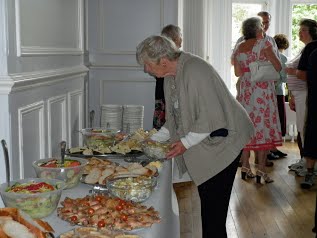
HADAS Diary
Tuesday, 11th October 2011, Silchester: the revelation of an Iron Age and Roman city. Lecture by Dr John Creighton (University of Reading). 7.45 for 8pm, Drawing Room, Avenue House, 17 East End Road, Finchley, N3 3QE. Non-members £1.
100 years ago, a campaign of excavations at the Roman city of Silchester came to an end creating one of the earliest images of an entire Roman city, an iconic image that has been reproduced in countless books on Roman Britain. But the process of revelation neither started nor ended there; its beginnings lay in Stukeley (1722) and John Ward (1740s) and have continued thereon to include the long running Insula IX excavations by Fulford and Clarke.
This lecture will be a guided story through 260 years of endeavour culminating in a recent project which has seen a large scale geophysical survey take place in and around the town, combining it with a digitisation of the 260 years of excavation records, cartographic data, geological and field-walking information. This rich combination has led to the discovery of new cemeteries, large burial enclosures, new defences, re-routing Roman roads. It has also been possible to tease away the Roman layers to try to interpret and re-create a plan of the settlement in the Late Iron Age.
Tuesday 8th November 2011
The Thames Discovery Programme. Lecture by Nathalie Cohen.
Sunday 4th December 2011
Christmas Party at Avenue House. This will be a lunch/afternoon affair. Please see page 2 for further details. Tuesday 10th January 2012
The Merchant Taylors Great Feast, 1607. Lecture by Ann Saunders.
Tuesday 14th February 2012
The Medieval Cellars of Winchelsea. Lecture by Richard Comotto.
Tuesday 13th March 2012
It’s all in the bones. Lecture by Jelena Bekvalac (Curator of Human Osteology – MOL).
Tuesday 10th April 2012
Conservation Techniques in Stone Masonry. Lecture by Stephen Critchley.
Tuesday 8th May 2012
Bumps, Bombs and Birds: the history and archaeology of RSPB reserves.
Lecture by Robin Standring (RSPB Reserves Archaeologist).
Tuesday 12th June 2012. Annual General Meeting. Tuesday 9th October 2012
The Life and Legacy of George Peabody. Lecture by Christine Wagg.
Tuesday 13th November 2012 Lecture TBC.
HADAS Party – Don Cooper
As mentioned in last month’s newsletter HADAS are having a buffet lunch for members and their partners at Avenue House on the 4th December 2011. We will have a 50th anniversary cake, raffle and other goodies. It will be a great occasion to catch up with friends/members and celebrate the final event in HADAS’s 50th anniversary year. The cost will be £20 per person. An application form will be available with next month’s newsletter.
New Members Update – Stephen Brunning
A very warm welcome to the HADAS members who have joined since the last update in the December 2010 newsletter. They are: Jessica Aberbach, Audrey Alimo, Robert Bard, Roger Chapman, Judy Goodwin, Hannah Page, Victoria Rosoux and Mollie Shomali. I hope to meet some of you at a forthcoming event.
Bobbie Proffer – Mary Rawitzer
We have sad news that Bobbie Proffer died on August 14th. She had been diagnosed with leukaemia in about 2000. At HADAS we knew she had been quite ill, but she brushed it aside and didn’t talk about it when she came to meetings and outings again. She was put on steroids which kept the illness at bay for 10 years, but in early 2010 immunity to the medication had built up and she died after a year’s illness.
Myrtle Proffer was born on 13th August 1921. As a child she hated the name “Myrtle” and decided she wanted to be called “Bobbie” – the name we all knew her by. While her three children, Keiran, Stephen and Judy, were growing up she got a job as a part-time teacher at Kingsgate primary school in Kilburn for 3 days a week. She remained at that school until she was 80! She kept retiring and they kept calling her back to help.
Bobbie became interested in archaeology at about the age of 50, took the Institute of Archaeology Diploma Course and was awarded her Diploma in 1980. With a gift for friendship, a group of her fellow Diploma students has continued to meet each year ever since. Her Diploma practical took her up a mountain near Malaga, into a scarcely accessible cave which, after 6ft depth of earth and heavy rocks had been heaved out, yielded Beaker pottery. All those rocks had to be energetically flung back in afterwards. It was at this time that Bobbie joined HADAS and was involved with the West Heath dig. She was interested in everything, a fount of knowledge, and always seemed so young. It is hard to believe she has gone. Our thoughts are with her family.
Listed Buildings – Peter Pickering
In the light of recent concerns and some misunderstandings about the former Church Farmhouse Museum, I thought it would be helpful to set out what I believe to be the legal position on listed buildings.
Buildings are listed by the Secretary of State for Culture, Media and Sport on the advice of English Heritage. He usually follows their advice, but is not bound to, and occasionally refuses to list a building they have recommended him to list. Each listing includes a description of the building; recent listings generally have a much fuller description than those from years ago. Demolition of, or alteration to, a listed building (inside or out) requires listed building consent, whether or not it also requires planning permission.
There are three grades of listed building: I – buildings of exceptional interest (approximately 2 per cent of all listed buildings); II* – particularly important and more than special interest (approximately four per cent); and II.- buildings of special interest. The requirement for listed building consent is the same for each grade.
The authority which decides whether to grant listed building consent is the local planning authority. If, however, the building is owned by the local planning authority, the decision falls to the Secretary of State for Communities and Local Government in the case of Grade I and Grade II* buildings, and for works to the exterior of Grade II buildings. An application for listed building consent has to provide a description of the significance of the listed building, so that the planning authority can understand the potential impact of the proposal.
In London, the borough council has to notify English Heritage of all applications for listed building consent involving Grade I and II* buildings, and of applications for the total or substantial partial demolition of Grade II buildings, of any applications relating to railway or underground stations, theatres, cinemas or bridges across the Thames, or where the authority is either the applicant or the owner of the building in question. English Heritage may give the authority directions how to deal with the application, or may leave that to the authority’s discretion. National amenity societies (including the Council for British Archaeology) have to be notified by the local planning authority of applications for the demolition or partial demolition of a listed building, and can comment. The London and Middlesex Archaeological Society is an agent of the CBA, and should receive notifications from London boroughs (in practice some notify quite minor alterations, including ones to unlisted buildings in conservation areas, while other boroughs, such as Barnet, interpret ‘demolition’ more narrowly);
I serve on a LAMAS Committee dealing with Listed Buildings.
Appeals against the refusal of listed building consent (like appeals against the refusal of planning permission) are to the Secretary of State for Communities and Local Government, though they are almost always delegated to an Inspector.
The policy under which planning authorities work is set out in the Government’s Planning Policy Statement 5, and is “Substantial harm to or loss of a grade II listed building . . . should be exceptional. Substantial harm to or loss of . . . grade I and II* listed buildings should be wholly exceptional”. The present Government wishes to replace PPS5, and all similar guidance, with a single National Planning Policy Framework.
Museum of London Finds Conference – Don Cooper
A Conference entitled “Following finds – from site to store” was held at the Museum of London on 10th September in memory of Penny MacConnoran whom many of you will have met or heard of, for Penny was finds manager at the Museum of London (MoL) and the London Archaeological Archive and Research Centre (LAARC) for many years. She sadly died of cancer in July 2010. Her colleagues put on a wonderful conference in her memory and raised money for St Joseph’s Hospice.
The conference consisted of 14 sessions, mainly on finds from London, and dealt with every period from Pre-Historic (Jon Cotton), Roman (Gus Milne, Roberta Tomber, Angela Wardle & Michael Marshall, Sue Winterbottom), Saxon and Medieval (Marit Gaimster, Lynne Keys, Ian Riddler, Francis Pritchard, Beth Richardson and Jackie Kiely) up to Post-Medieval (Jacqui Pearce). Finds conservation as well as strategies for archiving were also presented at this well-attended conference.
Penny was a brilliant finds manager and is sorely missed. However it was good to see that MoL still has an active and experienced group of finds specialists. It is to be hoped that in the uncoupling of MOLA (formerly MOLAS) from the MoL and LAARC (MOLA is being set up as a separate charitable trust!) the finds specialists are not lost to access by local societies. It is important that any new strategy for LAARC makes provision for finds identification and processing expertise so that the London Archaeological Archive and Research Centre continues to live up to the “research” aspect of its title.
White Bear Public House – Peter Pickering
A note of mine in the newsletter for November 2010 told members about the planning application to demolish this public house and replace it with a 5 storey building of flats above a shop. I emphasised the need for an archaeological condition on any planning permission. In fact, the application was turned down and the building remains, still with restaurant menus on it, unused and sad-looking; a board claims that it has been sold.
The White Bear is in The Burroughs conservation area, which gives it a higher degree of protection than usual. There is a portacabin on the car park belonging to the pub, and cars for sale are standing all around. This use must be without planning permission, since in March there was a planning application to regularise it which elicited 14 objections. Officers recommended the council committee to allow the application, but they turned it down, and it has now gone to appeal. The change of use would not itself require any archaeological condition, but there may well be another application in the fairly near future involving demolition, and we shall have to keep our eyes open.
The Ness of Brodgar – Don Cooper
The highlight of a recent holiday in the Orkneys at the end of July 2011 was the couple of days spent at the excavations at the Ness of Brodgar.
The Ness of Brodgar is an archaeological site covering 2.5 hectares (6.2 acres) that has been excavated from 2003 to the present between the Ring of Brodgar and the Stones of Stenness in the Heart of Neolithic Orkney World Heritage Site near Loch of Harray, Orkney, in Scotland.
It has provided evidence of decorated stone slabs, Neolithic pottery, drains, Neolithic anthropomorphic figurines, painted walls, a massive stone wall and the foundations of up to a dozen buildings including one huge edifice of as yet unknown purpose. One building, at least, would appear to have had a stone roof. The site may have been occupied from as early as 3500 BC to the end of the Neolithic and have had a great many phases of occupation.
The excavations are run by the Orkney Research Centre for Archaeology, based within the Archaeology Department at Orkney College, University of the Highlands and Islands, and are manned by volunteers from all over the world. The excavation has already won Current Archaeology’s Research Project for the year 2011.
We took one of the two daily tours; we were shown the outlines of the many buildings gradually being exposed by the forty or so volunteers on site, as well as some of the finds of Neolithic pottery etc. that were coming up on a daily basis. Decorated stones were being recorded and catalogued in situ on the many walls still standing.
This excavation has the potential to change our understanding of the Neolithic in Britain. While there are a good many more years of painstaking excavation before the full results of what has been discovered can be published, what has so far emerged is the story of a flourishing society up in the far north of Great Britain who could build great stone buildings, understood drainage, painted and decorated their walls, made large and small pots. This
year’s excavation has now finished – although the daily journal is still on the web site http://www.orkneyjar.com/archaeology/nessofbrodgar/ . Do go and have a look and watch a major site emerge from the mists of the past. The dig is expected to start again in July 2012 and if planning a visit to the Orkneys don’t forget to include a visit to the Ness of Brodgar. By the way a “Ness” is a headland or promontory or cape.
A Brief Sojourn in the Faroe Islands – Emma and David Robinson
In August we visited the Faroe Islands – partly out of curiosity; but also with a view to doing some fieldwork for a possible new research project exploring the tangible (visible) and the intangible (invisible) cultural inheritances of islands of the Nordic Fringes. In this the archaeological remains of Viking settlements and the Norse sagas and traditional ballads would be significant strands. This project would build on research in Iceland we have been involved with in the recent past.
The Faroes are best known to many through the BBC Radio Shipping forecast as in: “Attention all shipping … gale warning to shipping Fair Isle, Faroes and Southeast Iceland westerly gale force 8 expected soon, increasing storm force 10 later”. The islands lie some 190 miles NE from the north of the Shetlands. For early travellers by sea it was often a challenge to locate them due to mist and gale-force winds … and often impossible to land due to heavy seas and few sheltered harbours.
Our interest in visiting the Faroe Islands increased further when we read that the National Geographic conducted a survey of sustainable tourism in 2007 and rated them top of a list of the most unspoilt islands. Their summary is given below. It was also clear that we would need to prepare for our trip carefully.
“Superb glaciated landscape with incredibly steep slopes. Only a small amount of flat land. A unified local community, resolutely Faroese not Danish, with its own language. It has a unique architectural heritage, right down to the grass roofs, quite rightly preserved and cherished. Tourists are adventurous and well informed.”
Geologically the Faroes are of volcanic origin and substantially of basalt. They are much older than Iceland and there is virtually no seismic activity. They lie in the Gulf Stream with a typical temperature range of between 3 C. in winter and 11 C. in summer. There are few days of frost and few when it does not rain at least to some degree. The dominant characteristics are the steep cliffs with abundant birdlife. Cultivation for agriculture of the little flat land there is has always been a challenge. But the reality is that these 18 windswept volcanic islands are quite extraordinary. It is a world of wild and austere beauty where clear streams cascade down the slopes – softened by the bright colours of the houses which often still have turf roofs..
Politically the Faroes has been a self-governing dependency within the Kingdom of Denmark since 1948. Interestingly, whilst Denmark is in the EU – the Faroes are not. Some areas of government remain the responsibility of Denmark, including military defence, police, justice and foreign affairs. Whilst not wishing to dwell on political history, this is very important in terms of their cultural inheritances and identity today.
Like Iceland the Faroes were first settled by Irish monks in the 5th / 6th centuries. However, they were settled by the Vikings or Norsemen in the 8th / 9th centuries, some time before Iceland, and even now the names of their old settlements often carry the suffix of Vik. The Norsemen brought their Nordic language which has evolved into the Faroese language spoken today – but this was only written down in the 19th C.
The only Norse saga directly relevant to the Faroes is The Faereyinga Saga. This recounts the stories of the emigrants who settled on the islands around the end of the 9th century. But the Faroes also retains its unique Nordic Faroese dance tradition – a chain dance which is performed to ballads retelling the stories of the islands.
In this short piece it is difficult to give more than a few words about our explorations. We visited most of the major islands with the exception of the most southerly, Suduroy. Torshavn might be the smallest and most northerly capital city in the world, but it is a veritable metropolis compared to other larger regional settlements. Until recently many settlements were only accessible by sea, or by often precarious tracks hanging onto the sides of steep slopes – but most islands and larger settlements are now linked by tunnels through the rocks or by bridges which have done much to facilitate communication. The economy relies heavily on fish and fish farming – but a majority of families also still own sheep and geese and rely on their potato and vegetable plots.
Highlights of our visit included: Tinganes in Torshavn Harbour where the main assembly or Ting met every summer; Kirkjubour with its St Magnus Cathedral and arguably the oldest wooden house in Europe; excavated Viking settlements such as that at Kvivik; the impressive recently opened national museum which tells the story of the islands with great insight and sympathy; and, perhaps we should also add by way of contrast, our visit to the remote northern isles. We were lucky to be able to take a trip round a small island called Nolsoy in a traditional wooden sailing sloop – a fascinating experience. We returned to Nolsoy to a cultural festival with a strong local flavour. The religious revival meeting conducted by the Salvation Army to traditional tunes in the beer tent was notable!
In our explorations we must express our gratitude to the Faroese travel agency, Greengates Incoming, who made all our travel arrangements with great flair and ensured that we got to most of the places we wished to see. We are also very grateful to Samal Blahamar – the owner of Tora Travel – who seemed to know almost everyone and went out of his way to explain cultural nuances which would have otherwise passed us by.
Finally, we are grateful to Jorleif Kurberg – a retired lecturer in English from the Technical College – for hosting a dinner in his home and taking us to see some places of particular interest in the locality of Torshavn.
Getting to the Faroes from north London is now very easy from May to October. We took advantage of the new direct Atlantic Airways flights from Stansted (c. two hours). The Stansted Express Coaches also conveniently stop at Golders Green. We would commend a visit to you all – with careful planning this should not be beyond the scope of most intrepid HADAS members.
We found the following two easily available books very helpful:
Proctor, J., (2008). Faroe Islands. Chalfont St Peter: Bradt Travel Guides.
Kjorsvik Schei, L & Morberg, G. (2003). The Faroe Islands. Edinburgh: Birlinn Ltd.
HADAS 50th Anniversary Party – Stephen Brunning
Here are a couple of photographs taken at last month’s memorable event
Chatham Dockyard Visit – June Porges
Stewart and I were very pleased to read in last month’s Newsletter that people had enjoyed the outing to Chatham. However I must confess that I, having already visited the air raid shelters and having experienced being put to bed in one regularly during the Manchester blitz, took Don’s alternative option and went on the river cruise instead. I must therefore apologise that the write-up was not by me, but by our indefatigable Jo and Jim Nelhams who do so much to make all our expeditions enjoyable. Thanks to both!
Other Societies’ Events Compiled by Eric Morgan
Wednesday 5th October 5pm. British Archaeological Association. Society of Antiquities, Burlington House, Piccadilly W 1. Birkbeck training excavations in Syon Park: The Bridgettine Abbey and the formal gardens of Syon House. Talk by Harvey Sheldon (HADAS President). Tea 4.30pm.
Wednesday 5th October 8pm. Stanmore and Harrow Historical Society. Wealdstone Baptist Church Hall, High Street Wealdstone. Lancelot Andrews: main translator of the King James Bible. Talk by Jo & John Brewster. Visitors £1.
Thursday 6th October 10.30-12 noon. Mill Hill Library, Hartley Avenue NW7. The Battle of Barnet: Myths, Legends and Location, Location, Location. Free Talk.
Thursday 6th October. 8pm. Pinner Local History Society. Village Hall, Chapel Lane Car Park, Pinner. Smoke, Soot & Steam: The early days of London’s Metropolitan Railway. Talk by David Burnell. Visitors £2. Monday 10th October 3pm. Barnet and District Local History Society. Church House, Wood Street, Barnet (opposite museum). Coffee Houses, coffee shops, coffee stalls, coffee bars. Talk by Marlene McAndrew. Tuesday 11th October 2-3pm. Harrow Museum, Headstone Manor, Pinner View, North Harrow. London Transport Posters: a century of Graphic Design. Talk by Oliver Green (LT Museum). Cost £3.
Wednesday 12th October 2.30pm. Mill Hill Historical Society. Wilberforce Centre, St Paul’s Church, The Ridgeway NW7. A Walk around Hatton Garden and Leather Lane. Talk by Pat Clarke.
Wednesday 12th October 7.45pm. Hornsey Historical Society. Union Church Hall, corner of Ferme Park Road, Weston Park N3. A History of Highgate. Talk by Stephen Denford. Visitors £2. Refreshments, sales and information 7.30.
Friday 14th October 8pm. Enfield Archaeological Society. Jubilee Hall, 2 Parsonage Lane/junction of Chase Side, Enfield. Happisburgh Prehistoric Site. Talk by Dr Nick Ashton (BM). Visitors £1. Refreshments, sales and information 7.30.
Saturday 15th October 10am-1pm. LAMAS. Clore Learning Centre, MOL, London Wall EC2. Guide to 1911 Census for Local Historians. Details on page 5 of September Newsletter.
Sunday 16th October 2pm. Finchley Society. Guided walk along Church Path and other back streets of North Finchley and Whetstone. Meet at the entrance to the Lodge Lane Car Park to go as far as Swan Lane Open Space (near the High Road), and walk back along Woodside Avenue that has some interesting buildings. Less than 2 miles. Led by Derek Warren.
Monday 17th October 8.15pm. Ruislip, Northwood and Eastcote Local History Society. St Martin’s Church Hall, Eastcote Road, Ruislip. Reservoir to Lido: 200 years of history. Talk by Eileen Bowlt. Visitors £2. Wednesday 19th October 7.30pm. Willesden Local History Society. Scout House, High Road (corner of Strode Rd) NW6. McVities Past History and Busy Present. Talk by Tom Culyer.
Wednesday 19th 8pm. Edmonton Hundred Historical Society. Jubilee Hall, 2 Parsonage Lane/junction of Chase Side, Enfield. WWI – aspects of the Home Front. Talk by David Green. Visitors £1. Also Saturday 29th October 10am-4.30pm. EHHS Day Conference at Jubilee Hall.
Wednesday 19th October 8pm. Islington Archaeology and History Society. Islington Town Hall, Upper Street N1. Islington’s Green Plaque Scheme. Talk by Allie Dillon (Islington Local History Centre). Thursday 20th October 7.30pm. Camden History Society. Charlie Ratchford Centre, Belmont Street NW1 (off Chalk Farm Road opposite Roundhouse). The bricks that built Victorian London. Talk by Peter Hounsell.
Friday 21st October 7pm. COLAS. St Olave’s Parish Hall, Mark Lane EC3. A Hidden Landscape Revealed: excavations at Syon. Bob Cowie. (MOLA). £2.
Friday 21st October 7.30pm. Wembley History Society. St Andrew’s Church Hall, Church Lane, Kingsbury NW9. Some forgotten short films of WW2. Talk by David Hughes. Visitors £2. Refreshments in interval. Tuesday 25th October 10.30am. Enfield Society. Jubilee Hall, 2 Parsonage Lane/junction of Chase Side, Enfield. A touch of glass (Historical aerial photography from 1900 onwards) including pictures taken from the Tiger & Puss Moth aircrafts. Gary Lakin.
Tuesday 25th October 2-3pm. Harrow Museum, Headstone Manor, Pinner View, North Harrow. Harrow in the days of Guy Fawkes. Talk by Narinder Mudhar. Cost £3.
Wednesday 26th October 7.45pm. Friern Barnet & District Local History Society. St John’s Church Hall (next to Whetstone Police Station), Friern Barnet Lane N20. The Geology of Friern Barnet. Talk by Stephen Kranse. Non-Members £2.
Thursday 27th October 8pm. Finchley Society. Drawing Room, Avenue House, East End Rd N3. Finchley Society: Its first 40 years. Jean Scott Memorial Lecture by David Smith (Chairman). Non Members £2.
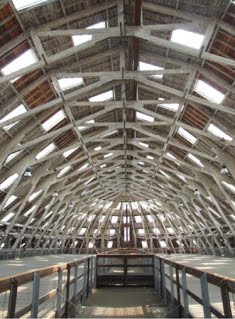
For the academic year 2011/2012 HADAS is again running its course called LOOKING AT FINDS – A PRACTICAL COURSE IN POST-EXCAVATION STUDIES. The course will tutored by Jacqui Pearce BA FSA MIfA and will be held on Wednesday evenings starting 28 September, from 18.30 – 20.00 hrs at Avenue House. See details below.
Christmas 2011
A date for your diary. HADAS is planning a buffet lunch at Avenue House on Sun 4th Dec. Details later. HADAS DIARY
Tues. 11th Oct. 2011, Silchester: the revelation of an Iron Age and Roman city, Dr John Creighton
(University of Reading).
Tues. 8th Nov. 2011, The Thames Discovery Programme, Nathalie Cohen, (TDP Team Leader)
Sun. 4th Dec. 2011, Christmas Event, buffet, at Avenue House, TBA.
Tues. 10th Jan. 2012, The Merchant Taylors’ Dinner from the 18th-century, Dr Anne Saunders Tues. 14th Feb. 2012, The Medieval Cellars of Winchelsea, Richard Comotto
Tues. 13th March 2012, It’s All in the Bones, Jelena Bekvalac, (curator of human osteology, MOL) Tues. 10th April 2012, Conservation Techniques in Stone Masonry, Stephen Critchley.
Tues. 8th May 2012, Bumps, Bombs and Birds: the history and archaeology of RSPB reserves, Robin Standring, (RSPB Reserves Archaeologist).
Lectures are held at Avenue House, 17 East End Road, Finchley, N3 3QE, and start promptly at 8 pm, with coffee/tea and biscuits afterwards. Non-members: £1. Buses 82, 125, 143, 326 & 460 pass nearby and Finchley Central station (Northern Line), is a short walk away.
LOOKING AT FINDS – A PRACTICAL COURSE IN POST-EXCAVATION STUDIES.
Following on from the success of previous award-winning courses, HADAS will be continuing to explore the treasures hidden in the London Archaeological Archive and Research Centre (LAARC). The aim is to give instruction in identifying, recording and understanding different categories of finds from archaeological excavations in London that, for various reasons, were never fully written up, with a view to publication in a relevant journal. This year we will be starting to look at sites excavated by the Guildhall Museum in the early years after the Second World War and focusing on a wide range of finds, from pottery to clay pipes, glass and building material, examining them in their wider context and so learning more about the people who used and discarded them.
A 22-week course in post-excavation analysis to be held at Avenue House, East End Road, Finchley
Wednesday evenings, 6.30–8.30 pm, starting on 28 September 2011.
Course fee: £275 for 22 sessions. To book, contact Don Cooper (020 8440 4350, or email: chairman@hadas.org.uk) or Jacqui Pearce (jacquipearce126@hotmail.com Tel: 020 8203 4506).
Please make cheques payable to HADAS and send to Don Cooper, 59 Potters Road, Barnet, EN5 5HS.
HADAS VISIT TO UPNOR CASTLE AND CHATHAM DOCKYARD, 31 JULY, 2011.
Upnor Castle, by Jean Bayne
Upnor, a tiny, charming village on the Kent coast, has a cobbled main street, weather-boarded houses, old-style shop fronts and an impressive medieval castle. It was described by Stuart as a ‘Tudor des res’ : a hidden gem, in fact, as very few of us had ever heard of it.
Situated on the banks of the River Medway, the castle was built in 1559 at the behest of Queen Elizabeth I in order to protect the fleet when it was moored in the river ‘in ordinary’, or out of commission. The original buildings were less extensive, consisting of the water bastion or platform and a residential block with two towers. Great guns could be mounted on the bastion and on top of the main building. Later, in 1599, the gatehouse, moat and drawbridge were added and the north and south towers were reconstructed and strengthened. Also, a courtyard wall was added to provide defence from the landward side. On the seaward side, a timber palisade and ditch with flankers (fortified positions for firing) were put in place, the bastion raised and a higher parapet added.
Even in 1601 it was not completely finished, but its appearance was much like today. As a visitor, it felt well- preserved and substantial. Moreover, its small rooms, differing levels and twisty stairways gave it a human dimension and scale: it is easy to imagine people living and working there.
In 1623 the garrison consisted of 29 people: a captain, a master gunner, seven gunners and twenty soldiers. Eighteen guns were mounted there, with, surprisingly, 34 longbows. But the castle was in great need of repair and intensive maintenance. It is notable that during the Civil War it was only used as a prison for Royalist officers.
The most significant event for Upnor Castle occurred in its final days as a defensive structure. This was the Dutch raid in the River Medway in 1667. Following a successful sea battle, the English were taken by surprise when the Dutch fleet sailed up the Medway, burning many anchored ships and capturing HMS Royal Charles. The English managed to muster extra guns while the Dutch were at anchor and pounded their ships when they resumed their assault. The Dutch were unable to progress and put out to sea. Upnor Castle had defended well but the burnt out hulks of ships were a humiliation for the English navy. ‘A Dreadful Spectacle’ was John Evelyn’s pronouncement. Pepys concluded that Upnor had lacked munitions rather than bravery: ‘I do not see that Upnor Castle hath received any hurt by them though they played long against it and they themselves shot till they had hardly a gun left upon the carriages, so badly provided they were’.
The incident was the castle’s death knell as a fortress. New defensive structures were hastily constructed along the Medway and Upnor was reduced in importance. In 1668 it became a store for gunpowder shipped from the Tower of London wharf. In 1691, it stored 5,206 barrels and other munitions to supply the navy. The castle was modified to take the increased weight and altered to reflect its new function. For example, the gun platforms on the roof were taken down. In 1718 barracks were built: one of the first ever purpose-built ones, which housed two officers and 64 soldiers. The Magazine continued for many years until it closed in 1827, and by 1840 there was no gunpowder left. It became an Ordnance Laboratory and by 1945 it was officially designated as a museum.
The finest view of the castle is from the river as it clearly shows the shape of the building, with its turreted façade, decorative roundel windows and the triangular water bastion overhanging the river with stumps of an old palisade visible at low tide.
The Historic Dockyard Chatham, Part 1, by Vicki Baldwin
We arrived at the Visitor Entrance at approximately 11.45am, passing buildings marked ‘PUMPMAKERS’, ‘CAPSTAN MAKERS’, and ‘COAK AND TREE NAIL MAKERS’ and after a short wait ARP Warden Irene boarded our coach to give us a guided tour of the Dockyard.
The River Medway was first used by the Royal Navy in 1547. As it was difficult to navigate, it was considered to be a safe berth for the Navy and a small dockyard was developed. Another important factor was the absence of Teredo navalis, a boring worm that destroyed ships’ hulls. In 1586 The Sunne was the first warship built at Chatham and the Dockyard was busy building, refitting and repairing the ships that would face the Spanish Armada in 1588. The first submarine built there was the C17 in 1907.
The changing needs of the Royal Navy are reflected in the history of the Dockyard until its closure in 1984. The site was then split into three with the smallest and most historic part set aside to become The Historic Dockyard. Not all the buildings are accessible to the public but those that are open house various exhibitions and collections with a connection to the Dockyard and maritime history. No. 1 Smithery, where anchors and chains were forged, now houses exhibitions, some temporary, in conjunction with the Imperial War Museum and The National Maritime Museum. Originally working conditions in the Smithery were so hot in summer that men passed out and so cold in winter that handling the iron could take the skin off the hands. The workers were each allowed 8 pints of strong beer a day.
Across Museum Square and opposite No. 1 Smithery are the boatsheds and covered slips. No.3 Slip (The Big Space) was built in 1838 using timbers from old warships. At the time it was thought to be the largest wide span timber structure in Europe. In 1904, no longer used for ship building, it was filled in and a mezzanine floor added for storing ships’ boats. Its roof is spectacular whether viewed from inside or out (see photo).
Nos. 4, 5, and 6 were constructed mainly from cast iron in 1848, and No.4 houses a collection of lifeboats and No. 6 is leased to railway enthusiasts.
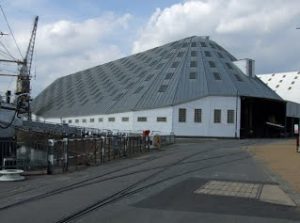 No. 7, built in 1855 from cast and wrought iron, has an early example of a metal trussed roof and was used for building submarines from 1907 until 1966. The last submarine built there was HMS Ocelot which was launched in 1962. Alongside the covered slips are three ships, HMS Gannet, HMS Ocelot herself and HMS Cavalier. HMS Gannet was built in 1878 a Victorian, dual-powered (sail and steam) gunboat. When she was decommissioned in 1895 her boiler and engine were removed, she was renamed HMS President and became a training ship. She was towed to the Hamble where she remained after the school was closed in 1968. In 1987 she was purchased by the Dockyard. The third ship, HMS Cavalier, forms part of a memorial to the destroyers sunk in World War II.
No. 7, built in 1855 from cast and wrought iron, has an early example of a metal trussed roof and was used for building submarines from 1907 until 1966. The last submarine built there was HMS Ocelot which was launched in 1962. Alongside the covered slips are three ships, HMS Gannet, HMS Ocelot herself and HMS Cavalier. HMS Gannet was built in 1878 a Victorian, dual-powered (sail and steam) gunboat. When she was decommissioned in 1895 her boiler and engine were removed, she was renamed HMS President and became a training ship. She was towed to the Hamble where she remained after the school was closed in 1968. In 1987 she was purchased by the Dockyard. The third ship, HMS Cavalier, forms part of a memorial to the destroyers sunk in World War II.
Chatham Dockyard Air raid shelter, by June Porges
In the foyer of the Smithery, we met up with ARP warden Irene, our guide from the earlier bus tour. She led us on a short walk to one of the many air raid shelters on the site and the only one currently open to the public, though another is being cleared.
This shelter is in front of the Officers’ Terrace, a row of 4-storey houses built around 1720. It was used by officers and their families, though others could use it with permission of an officer. It can hold up to 70 people and is about the same size as a Northern Line carriage. The construction is of corrugated iron and is totally covered by earth. Access is by a concrete staircase at right angles to the main area, and with an emergency escape by a vertical ladder at the opposite end. It differs in several ways from the “other ranks” shelters, with a concrete floor, rather than earth, electric light instead of candles, and a telephone. The toilet was a metal bucket behind a curtain.
The dockyard was not seriously bomb damaged during the war, supposedly because the Germans hoped to use it as a safe haven when they invaded.
An alternative option, by Don Cooper
A number of members, having previously visited the dockyard, or just wishing to chill out on a sunny Sunday afternoon, decided to take the 21/2 hour cruise on the Kingswear Castle. The Kingswear Castle is one of the last steam-driven paddle vessels operating in the UK. It was built in 1924 and now offers pleasure cruises on the River Medway and the Thames. We cruised down the Medway, past Upnor Castle and Kingsnorth Power Station with one of the longest jetties in Europe, all the way to Oakham Ness. The sun was shining, there was that lovely coal smell from the engine, the river was full of small boats and interesting sights. What a lovely way to spend a Sunday afternoon!
HADAS 50th Anniversary Party and Wanted —Your Memories! Jo Nelhams
One of the largest HADAS gatherings for some time took place on Sunday August 7th at Avenue House to celebrate 50 years of the society. It was a great pleasure to see some longstanding members who, for various reasons, can no longer attend events on a regular basis.
Besides a very enjoyable spread of food and drink with a lot of talking and laughing, a recording of the very first lecture was heard, given by our founder Themistocles Constantinedes.
We would like to collect HADAS memories for present and future members to enjoy. It would be nice to hear present members’ recollections of any outings or digs, or about former members who are no longer with us. At the party, a number of people penned amusing and interesting memories. If you have anything to offer, please send them to Jo Nelhams (Hon Secretary), at the address at the end of this newsletter.
Local History News from the London and Middlesex Archaeology Society John Hinshelwood
The next LAMAS Local History Workshop is on 15 October, 2011, and will be led by John Hanson author of Getting the Best from the 1911 Census. This is the latest in the series of workshops started in March 2010 to explore how to create a nineteenth-century parish history from the online census reports. The workshops, held twice each year, are provided to motivate and assist individuals from affiliated societies to undertake their own research projects. Details and an application form for the forthcoming workshop are on the LAMAS website (www.lamas.org.uk/) on the Local History Committee pages. Alternatively contact John Hinshelwood (see below) with your name, address and phone number, and email if you have one. John would welcome suggestions for future workshops from individuals or affiliated societies.
The next LAMAS Local History Conference will be on 19 November 2011, with the theme Sporting London covering sport from mediaeval times to the present day. The conference will once again be held at the Museum of London and affiliated societies will be invited to apply for a stall to display and sell their publications. During the conference the winners will be announced of the 2011 LAMAS Local History Publications Awards. The conference programme is available on the website at www.lamas.org.uk, the cost is £8 for LAMAS members, purchased in advance, and £10 for non-members; any unsold tickets will be £10 on the day to everyone. Tickets are available from the website, or by postal application to: The Secretary, LAMAS Local History Committee, c/o 9 Umfreville Road, London, N4 1RY. Contact: johnhinshelwood@btinternet.com
The following article appeared in Hampstead Scientific Society’s newsletter of August 2011. The author is Doug Daniels, who is that Society’s president, a celebrated amateur astronomer and resident of Finchley. As computers continue to impact on archaeology, Stewart Wild thought that the content of this amusing essay would be of interest and relevance to members of HADAS, so he asked Mr Daniels if he would allow his thoughts to be recycled for the HADAS Newsletter. Mr Daniels has kindly agreed.
TO ‘Go To’ or NOT TO ‘Go To’ – THAT IS THE QUESTION, by Doug Daniels
Of course I’m biased. I belong to a generation that inhabited a world long before computers were commonplace. In my heyday there were not even such things as electronic calculators, and ‘windows’ were panes of glass that you looked through. The best calculating aids we had were slide rules and a book of log tables – oh yes, and a set of tables drummed into our brains at the age of six plus, so thoroughly, that if you ask us to multiply 9×8, the answer 72 is delivered instantly without even having to think about it!
Today it seems everything has to have a computer attached to it otherwise it is just not worth considering. Astronomical telescopes are no exception.
I recently spent an interesting yet frustrating few hours with a good friend who had just taken delivery of one of those small computerised ‘Go-To’ telescopes. Apparently it was able to automatically find upwards of 5,000 celestial objects all by itself and was designed to make “finding celestial objects easy for the beginner”. Some mistake surely!
After inserting a handful of batteries, we switched it on. It asked us to enter the date and time; we complied. A message was spelled out on the handset warning of the dangers of looking at the Sun, spelled out at such an incredibly slow speed that I was already beginning to feel my arteries hardening. Why for heavens sake? We have already told the wretched computer the date and that the time is 23.00 hrs UT – if it’s that damn clever it should know that the sun is below the horizon!
It then asks us if we would like ‘a tour of the solar system?’ No we would not – we just want to look at the Moon! It proceeds to do it anyway. Motors hummed, the telescope swung wildly up and down and round and round, finally coming to rest pointing down towards the ground, presumably attempting to home in on the Sun to justify its earlier warning.
After several abortive attempts to encourage it to point to the Moon my patience had run out and I switched it off, unclamped it and pointed it at the Moon manually. But even that was not so easy as the wretched device uses a built-in diagonal and has no finder. I would hate to try to point it at something really faint – you would just have to rely on its computerised functions to do this, and judging by our earlier attempts it could take all night to find the Andromeda Galaxy. OK, perhaps I’m being too quick to judge and it will take some time to become thoroughly acquainted with its little foibles; hopefully before its batteries go flat.
But I still maintain that such a device could lead to enormous frustration for a real beginner. It’s only a 70mm refractor for heavens sake! A simple alt-azimuth mount on a tripod would allow you to point it at the Moon and get an instant result without spending hours reading the instruction manual and then trying to identify certain stars to set its position.
An absolute beginner would probably not be familiar with these stars anyway. Before even attempting to use a ‘Go-To’ telescope it would be better to spend a few months getting acquainted with the night sky with a simply mounted telescope or a good pair of binoculars and a star map.
And while I am having a rant on the subject of unnecessary computers and telescopes, I strongly object to fitting computers to antiques. I recently visited the old Royal Greenwich Observatory and was appalled to discover that they had ‘computerised’ the historic 28-inch refractor. Using this wizard ‘strap-on’ electronic gizmo meant that it only took them about ten minutes to locate the Moon – a task that could have been accomplished manually in about thirty seconds by just squinting through the finder. I thought that computers were supposed to make life easier. Some mistake surely!
It’s the same at Mill Hill Observatory. The 18/24-inch Radcliffe refractor, a magnificent example of Victorian engineering constructed by Sir Howard Grubb, is now draped with cables and electronics and thoroughly ‘computerised’. I’m sorry but I just do not agree with this. I understand that students need to learn how to manage a computerised telescope but attempting to modify an ancient instrument is the wrong route to take.
To see all this electronic paraphernalia attached to the works of traditional makers such as Grubb and Cooke is,
to quote our esteemed heir to the throne: “Like seeing a monstrous carbuncle on the face of an old friend.”
Computers and brass fittings do not blend comfortably. If you must teach on a computerised instrument, and of course today you probably must, use one that is specifically built for that purpose, don’t desecrate the works of historic telescope makers.
OK, rant over. I shall now return to my cave, light a fire by rubbing two sticks together, suck the marrow out of the bones of a woolly rhinoceros and pay tribute to old King Ludd.
The Archaeology of Prehistoric Europe
This course, arranged by the Mill Hill Archaeological Study Society, will introduce the cultures that inhabited Europe from the introduction of metal to the beginnings of history with the arrival of the Greeks and Romans. Tutor: Scott McCracken. Venue: Hartley Hall, Lawrence Room, Flower Lane, NW7. Beginning Friday 30th September, 2011. Time: 10:00 – 12:00 hrs. Cost: £130 for 20 classes. Enrol at the first meeting. If you are new to the society’s meetings please contact the secretary: Peter Nicholson ‘M 020 8959 4757.
Free film screening at the Phoenix Cinema, East Finchley, Sunday 18 September
Did you know that the first ever public film screening in Britain happened in Barnet in 1896? Did you also know that two of Britain’s most important film pioneers, Birt Acres and Robert Paul, were working in Barnet in the 1890s and early 1900s?
Whether you’re an authority on film history or know nothing at all, come along to The Phoenix in East Finchley on Sunday 18 September, at 2.00 pm to see a free screening of early 20th Century films showcasing Barnet as the birthplace of British cinema and including the work of Acres, Paul and British & Colonial. The films will be introduced by Phoenix trustee and film historian Gerry Turvey and the screening will be followed by a discussion with Gerry Turvey and fellow film historian Ian Christie.
Booking is essential, so call the Box Office to reserve your seat on 020 8444 6789. For more information visit http://www.phoenixcinema.co.uk/education/heritage/from-the-archives/
Follow the Phoenix Storybook featuring people’s memories and thoughts about the cinema: http://www.phoenixcinema.co.uk/education/heritage/phoenix-storybook/
Membership Renewals – Stephen Brunning
A number of members have not renewed their membership subs which became due on 1st April. If this applies to you, a letter with a renewal form on the back is enclosed with this Newsletter. If you do not receive these and have not sent off your cheque yet, please get in touch with me by 1st October. My contact details are above. Thank you.
ERIC MORGAN’S MONTHLY ROUND-UP OF EVENTS
Some early September events were listed in the August Newsletter
Heritage Open Days 2011 will be 8-11 September with many openings: http://www.heritageopendays.org.uk/
Sat 10th Sept (Not the 15th as stated in the last Newsletter) Barnet & District LHS coach outing to the Ashmolean Museum, Oxford. Details from Pat Alison: ‘M 01707 85843 or email patron37@sky.com Sat 10th
Sept, 10.00-17.30 ‘Following finds – from site to store’ a meeting on aspects of archaeological finds in memory
of Penny MacConnoran, Weston Theatre, Museum of London. A varied programme of speakers including Jon
Cotton, Marit Gaimster, Francis Grew, Gus Milne, Jacqui Pearce, and others. To register visit Museum of London site: http://www/museumoflondonarchaeology.org.uk/News/FollowingFinds.htm or telephone booking option. Registration is £10, including tea and coffee.
Mon 12th Sept, 3.00 pm (tea at 2.30 pm), Barnet & District LHS, Church House, Wood St, Barnet, Beatrix Potter, by Pamela Wright.
Tues 13 Sept, 8.00 pm, Amateur Geological Society, The Parlour, St Margaret’s Church, Victoria Ave, N3 Amber, by Dr Chris Duffin (Geological Society & Geologists’ Association).
Wed 14 Sept, 7.45 pm, Hornsey Historical Society, Union Church Hall, junction Ferme Park Rd/Weston Park, N8, History of London’s Underground Railway, by Peter McMahan. Visitors £2.
Fri 16 Sept, 8.00 pm, Enfield Archaeological Society, Jubilee Hall, Parson’s Lane, junc. Chase Side, Enfield, Life in the Imperial War Museum, by Steve Turner (IWM) visitors £1, refreshments 7.30 pm.
Sat & Sun 17/18th Sept. London Open House Weekend.
Free access to hundreds of buildings. Details at www.londonopenhouse.org/
including: Bruce Castle, Forty Hall and Markfield Beam Engine, Markfield Rd, Tottenham, N15 (www.mbeam.org/)
Sat. only, Old St Andrews Church, Church Lane, Kingsbury, NW9.
Sun only, Myddelton House, Bullsmoor Lane, Enfield, E A Bowles House and Gardens open, 10.00 – 4.00 pm.
Wed 28 Sept, 7.45 pm, Friern Barnet & Dist. LHS, St John’s Church Hall, Friern Barnet Lane, N20, The History of the the Travelling Funfair, by Mel Hooper. Visitors £2.
Thurs 29 Sept, 8.00 pm, Finchley Society, Martin School, High Road, East Finchley, N2 (NB change of venue) Slides of Yesteryear and Planning Issues: East Finchley, by Derek Warren. Visitors £2.
~~~~~~
THANKS TO ALL OUR CONTRIBUTORS:
Vicki Baldwin, Jean Bayne, Don Cooper, Doug Daniels, John Hinshelwood, Eric Morgan, Jim Nelhams, Jo Nelhams, Peter Nicholson, June Porges and Stewart Wild.

